The Wigan Territorial Force in World War One

- 5th BATTALION MANCHESTER REGIMENT (TERRITORIAL FORCE) 1914-1919
Introduction
As well as relating the stories of family members and other soldiers who served in the regiment, this article focuses primarily on the movements, locations, war time conditions and battles that the first line territorial unit, 1/5th Battalion of the Manchester Regiment fought in during the Great War, from leaving Wigan in August 1914 to its return in March 1919. It also strives to give an insight to the bigger picture, militarily and politically.
In communicating with each other either officially or casually the armed forces use abbreviations, acronyms and nicknames. To anyone who has not served in the military or is not a military researcher this can be baffling and seem like a foreign language. Despite probably being frustrating for anyone who is accustomed to military terminology I have used full titles and terms whenever possible. This is in order for the general user, who for instance might be researching a relative who served in the regiment, to understand the sequence of events more fully without constantly referring to a list of abbreviations.
Much has been written about the exploits of the battalion in the ill-fated Gallipoli Campaign of 1915. However, information about their time on the Western Front in France and Flanders from 1917 onward is sparse and has to be obtained from 42nd Infantry Division history records, copies of official orders from Headquarters 127th Infantry Brigade, and War Office trench maps produced by the Ordnance Survey.
The war diaries were recorded daily, usually by the battalion Adjutant, but sometimes by the Intelligence Officer or Commanding Officer. In total there are 916 daily diary entries available online covering the Manchester’s time at Gallipoli between 1 May and 31 December 1915, and on the Western Front between April 1917 and March 1919, most are written in pencil and some are feint and hard to decipher. The National Archives at Kew hold copies of the diaries covering the battalions time in Egypt, Sinai and Palestine in 1916 and 1917. However these are not available online so details covering that period have been obtained from other written sources.
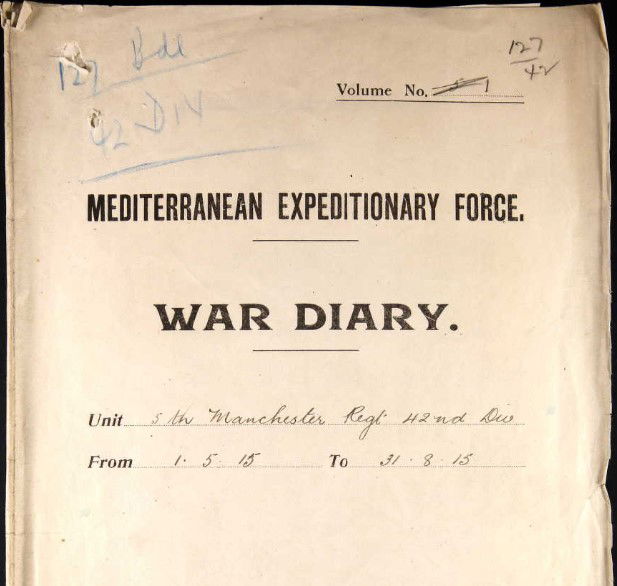 The very first war diary of the 5th Battalion Manchester Regiment, May 1915
The very first war diary of the 5th Battalion Manchester Regiment, May 1915
The last war diary entry was made on 28 March 1919 and signed by Lt. Colonel Henry Clayton Darlington, the Commanding Officer who had led the battalion throughout the Gallipoli campaign and onto the Western Front, finally bringing the Regimental Colours home to Wigan in 1919.
 Cap badge and shoulder title of 5th Battalion, Manchester Regiment, Territorial Force.
Cap badge and shoulder title of 5th Battalion, Manchester Regiment, Territorial Force.
It is important to note that the 5th Battalion Manchester Regiment raised two more territorial battalions. With the first line troops off to war and the drill halls now empty, more volunteers were recruited in August 1914 to form the 2/5th Battalion, initially made up of territorials from the 5th Battalion who hadn’t signed for overseas service. The battalions’ original intention was to provide drafts of replacements for the first line units serving overseas, however these second line troops were destined to see active service in France and Flanders.
They were assigned to 199th (2/1st Manchester) Brigade), 66th (2nd East Lancashire) Infantry Division, and trained at Altcar Camp near Southport, followed by a move in May 1915 to Crowborough in Sussex. In March 1916 they moved to Colchester in Essex. A year later on 6 March 1917 they sailed from Folkestone to Boulogne on board SS Princess Henrietta to enter the war on the Western Front.
In the press and in local history accounts of the Manchester Regiment, the exploits of 1/5th Battalion in Gallipoli overshadow their second line unit. In fact in twelve months of active service between March 1917 and March 1918 the 2/5th saw plenty of action, taking part in the Battle of Poelcapelle during the Third Battle of Ypres in October 1917 (more commonly referred to as The Battle of Passchendaele). The battalion suffered 98 killed in action, 314 wounded and 23 missing in action between March 1917 and February 1918.
The battalion also suffered very heavy casualties in the German Spring Offensive which commenced in March 1918. At first a composite battalion was made up from remnants of the various companies but the battalion had suffered such heavy losses that the decision was made not to bring the battalion back up to full strength.
In April 1918 they were reduced to a training cadre, tasked with teaching newly arrived American troops the art of trench warfare. The strength of the battalion at the end of June 1918 was twelve officers and 62 other ranks. 2/5th Battalion was officially disbanded on 31 July 1918 at Haudricourt, between Amiens and Rouen in France. The remnants of the Cadre were then transferred to their first line battalion counterparts, the 1/5th Manchester's, who then officially became the 5th Manchester Battalion, although they continued to use the prefix 1/5th in their title.
A new third line battalion designated 3/5th Battalion Manchester Regiment was formed on 20 May 1915. Early in 1916 they moved to Witley Camp, near Godalming in Surrey for training. On 8 April 1916 they became the 5th (Reserve) Battalion, stationed at Codford Camp on Salisbury Plain, training replacements for the other two front line units serving abroad.
On 1 September 1916, the day that National Conscription started, the 5th (Reserve) Battalion Manchester Regiment absorbed the 6th and 7th (Reserve) Battalions and became part of the East Lancashire (Reserve) Brigade. It entailed a move back to Lancashire in October 1916, where they trained at Altcar for three months. The brigade subsequently moved to Ripon in North Yorkshire in January 1917, then three months later to Scarborough, in late 1918 they were at Hunmanby Camp near Filey until disbandment in 1919.
A FAMILY at WAR
In 1915 the Wigan Observer & District Advertiser published an article about my family, entitled ‘Loyal Ince Families Losses - Fine Contribution to the Colours’ with the accompanying photos of my grandfather Sgt Francis Morgan Taylor and his younger brother, my great uncle, Pte George Arthur Taylor. (from here on referred to as Frank and George). They were both serving in 1/5th Battalion Manchester Regiment (Territorial Force) and had both been wounded in the Dardanelles Campaign.
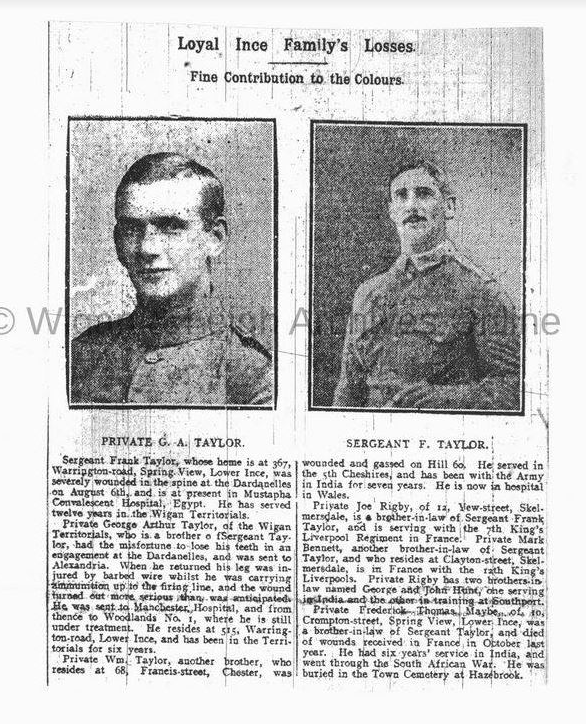 Wigan Observer & District Advertiser 1915
Wigan Observer & District Advertiser 1915
The article was a regular feature used by all newspapers during World War One, as a way of reporting on local soldiers who had been killed in action, wounded or missing. Information and photos were obtained from families to add more detail to the brief casualty lists. As well as my grandfather and great uncle there were accounts in the article of four other family members who had either been killed in action or wounded and discharged from the army.
6376 Pte Frederick Thomas Maybe
With the Great War just nine weeks old, my great aunt Alice’s husband, Frederick Thomas Maybe had been killed in action in France in 1914, aged 32. A regular soldier, serving with 1st Battalion North Staffordshire Regiment, he had served in India for six years and throughout the Second Boer War in South Africa.
He was one of the original ‘Old Contemptibles’, a reference to a remark Kaiser Wilhelm II of Germany made when he described the small but professional British Army as that ‘Contemptible little army’. The Germans and French, who had standing armies ten times larger, were more prepared for a European War than the British Army, whose priority was maintaining a world-wide Empire. The British Expeditionary Force (BEF) of 1914 used this criticism as a badge of honour and were proud to be called the ‘Old Contemptibles’.
1st Battalion North Staffs landed at St. Nazaire on 12 September 1914, then by a combination of train journeys and marching they made their way 440 miles across France to Courcelles near the Belgian border. Ten days later they went into the trenches for the first time, relieving the South Staffordshire Regiment.
Frederick died of wounds suffered in battle on 13 October 1914 and is believed to have first been buried in the French cemetery at Merris, near to the town of Hazebrouck. Like thousands of other soldiers who have no known grave, his final resting place was obliterated as the fighting raged back and forth and whole cemeteries were destroyed in artillery barrages.
There is a memorial cross to Frederick at Cabaret Rouge British Cemetery at Souchez, north of Arras and a mile to the west of Vimy Ridge. It is what is known as a Special Kipling Memorial, with Rudyard Kipling himself choosing the epitaph. On it is inscribed.
‘To the memory of this British Soldier Killed in Action 1914 and believed to be buried at the time in MERRIS Churchyard, whose grave is now lost. Their glory shall not be lost'.
Frederick's name is also inscribed on the war memorial in Ince Urban District Cemetery on Warrington Road, Lower Ince, Wigan.
In May 2000 the remains of an unknown Canadian soldier were taken from Cabaret Rouge Cemetery and buried in a special tomb at the foot of the National War Memorial in Ottawa, Canada. A focal point for remembrance, he represents more than 71,000 Canadians who lost their lives during the First World War. A headstone in Plot 8, Row E, Grave 7 marks the unknown soldier's original grave.
 Cabaret Rouge British Military Cemetery
Cabaret Rouge British Military Cemetery
John William Taylor
My great Aunt Mary’s husband, John William Taylor, from Chester was serving in the 5th Battalion Cheshire Regiment. He had been gassed at the strategically important position of Hill 60 (named after the contour line it sat on) at Zillebeke, three miles south of Ypres in Flanders
Hill 60 wasn't a natural feature but man made, it was originally a spoil heap from a cutting following the construction of the railway between Ypres and Menen. The British had captured the hill which had commanding views of the surrounding countryside, by the use of underground mines. with very little losses on 17 April 1915. By 5 May however, after repeated bombardments with gas shells Hill 60 was back in German hands.
Of the 2,413 British casualties admitted to hospital, 227 died. At the time of the article in the newspaper John had been evacuated back to the UK and was currently recovering in hospital in Wales.
 Bunker at Hill 60, Zillebeke, Flanders. Originally a German shelter it was expanded and fortified by the Australians in 1918, The bunker also saw heavy fighting on 27 May 1940 during the withdrawal by the British Expeditionary Force to Dunkirk.
Bunker at Hill 60, Zillebeke, Flanders. Originally a German shelter it was expanded and fortified by the Australians in 1918, The bunker also saw heavy fighting on 27 May 1940 during the withdrawal by the British Expeditionary Force to Dunkirk.
14740 Pte Mark Bennett
The husband of my maternal great-aunt Isabella who resided at 39 Clayton Street in Skelmersdale was Mark Bennett of the 12th (Service) Battalion, Kings (Liverpool) Regiment. Mark disembarked at Boulogne with his battalion on 24 July 1915. In 1916 the battalion fought in the Battle of the Somme which lasted from 1 July to 18 November. They were in action alongside the Canadians at Mount Sorrell in June, and Delville Wood in August, they fought at Guillemont, Flers Courcelette, and Morval in September and the Battle of Le Transloy in October 1916, the last big attack on the Somme. In 1917 they were in action during the German Retreat to the Hindenburg Line. That year Mark was wounded in action, suffering a gunshot wound to his right leg. He was discharged from the army on 8 October 1917 with a thirty percent disability assessment, receiving a weekly pension of 17 shillings for his wife and two children.
227598 Pte Joseph Rigby
Also mentioned in the newspaper article was my maternal great-uncle Joseph Rigby who lived at 12 New Street Skelmersdale. He served in the 1/7th Battalion, Kings (Liverpool) Regiment. He entered the theatre of war in France on 5 August 1915 and was wounded in battle on 31 March 1916. After recovery he was transferred to 2/1st Rifle Battalion Monmouthshire Regiment, a territorial unit who were based in Suffolk. He was discharged from the army as being unfit for further military service on 8 June 1917 at Shrewsbury. Before the war he worked as a miner at White Moss Coal Co. Ltd in Skelmersdale.
Part Time Soldiers
My grandfather Frank enlisted into the 1st Battalion Manchester Volunteers in 1903 aged 18. On 1 April 1908, following the reforms introduced by Richard Haldane, the Secretary of State for War, the Territorial Force (TF) was formed by combining the Volunteer Force with the mounted Yeomanry Forces while the Militia was renamed the 'Special Reserve'. Thus 1st Battalion Manchester Volunteers was re-designated as the 5th Battalion Manchester Regiment (Territorial Force).
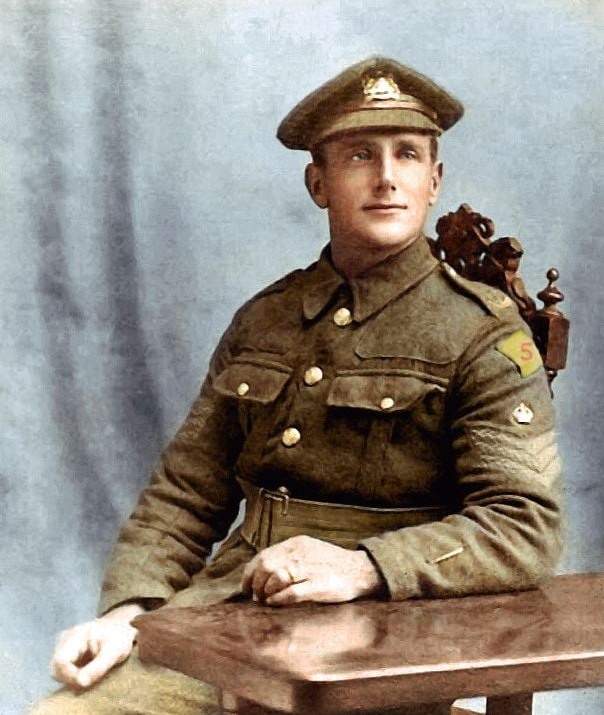 Colour Sgt Francis Morgan Taylor MSM
Colour Sgt Francis Morgan Taylor MSM
The part time soldiers, nicknamed the 'Terriers', were the butt of jokes and were derided as ‘Saturday Night Soldiers, ‘Saturday and Sunday Only Soldiers’ or as ‘Weekend Warriors’. However when the time came to answer the call to arms they did so with distinction, as they had done so during the Boer War in South Africa fourteen years earlier.
The Territorial Force was originally envisaged as a home defence force for service during wartime; units were liable to serve anywhere within the United Kingdom when the force was embodied (i.e. called up for active service) but could not be compelled to serve outside the country.
However in 1910 the part time soldiers were invited to volunteer to be liable for overseas service by signing Army Form E624, which enforced the Imperial Service Obligation Act. To distinguish them from 'Home Defence Only' soldiers, the ones who signed were issued with a badge, worn on the right breast of their uniform, under the Kings Crown were the words ‘Imperial Service'.
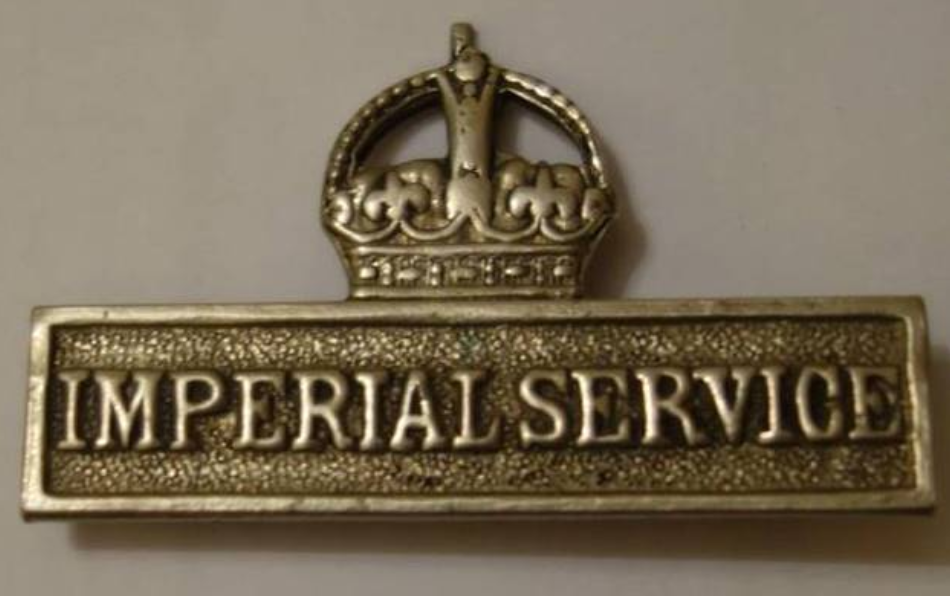 Imperial Service badge
Imperial Service badge
In March 1913 Frank married my grandmother Alice Rigby, who hailed from Skelmersdale, at Wigan Register Office. Their first child Isaac was born later that year. In 1914 Frank worked for Ince Urban District Council as a carter, transporting goods by truck. He simultaneously held the rank of Corporal in the Territorial Force for which he was paid a daily rate of one shilling and eleven pence, which included proficiency pay of three pence.
His younger brother George became a territorial soldier on 13 June 1910 aged 18. At the time he was an apprentice carpenter at W.R. Davies & Co. Railway Wagon Works at Springs Branch in Lower Ince, Wigan. He married Elizabeth Hunt in 1914, just before the start of the First World War.
The Great War
In the summer of 1914 the territorial soldiers had just returned from their Annual Training Camp at Carnarvon in North Wales. They were blissfully unaware that soon they would be fighting for real in a deadly conflict that would claim millions of lives.
The assassination in Sarajevo of Archduke Franz Ferdinand and his wife Sophie, Duchess of Hohenberg, on 28 June 1914, by Bosnian Serb Nationalist Gavrilo Princip set off a rapidly escalating chain of events that would soon engulf Europe. On 28 July, with the backing of Germany, Austria-Hungary declared war on Serbia, who then appealed to Russia for assistance. Because of the political alliances in force at the time it meant that within a week, Russia, France, Great Britain and Serbia had lined up against Austria-Hungary and Germany, and World War One had commenced.
 The assassination of Arch Duke Ferdinand and his wife Sophie
The assassination of Arch Duke Ferdinand and his wife Sophie
On 4 August 1914, Germany enacted the ‘Schlieffen Plan’, an aggressive military strategy that meant invading France through neutral Belgium. Kaiser Wilhelm II thought that Britain wouldn’t intervene as it’s small professional army was busy garrisoning the Empire and had no capacity to provide an expeditionary force in a major war He also reckoned on the German Army smashing through the Belgium defences and taking Paris before their Russian allies could respond.
That same day, Prime Minister Herbert Asquith told the nation that Great Britain was now at war with Germany and her ally Austria-Hungary, for failing to respect Belgium’s neutrality.
Call to Arms
The original 100,000 strong British Expeditionary Force consisted of one army of five regular army divisions in 1914. This would increase to two armies of sixteen divisions with the mobilization of the Territorial Forces.
Field Marshall Lord Kitchener the Secretary of State for War immediately started recruiting volunteers for his new army. The concept of the million strong civilian army was born. He planned to have half a million men ready and trained by 1916 but circumstances dictated they be used earlier in 1915 at Gallipoli and the Battle of Loos in France. To distinguish them as New Army troops the newly formed battalions had the word 'Service' in brackets in their title before their Regimental name.
Eventually numbering over five million men, Britain's army in the First World War was the biggest in the country's history. Remarkably, nearly half those men who served in it were volunteers. Nearly two and a half million men enlisted between August 1914 and December 1915. In 1916 the volunteer system ended when national conscription was introduced.
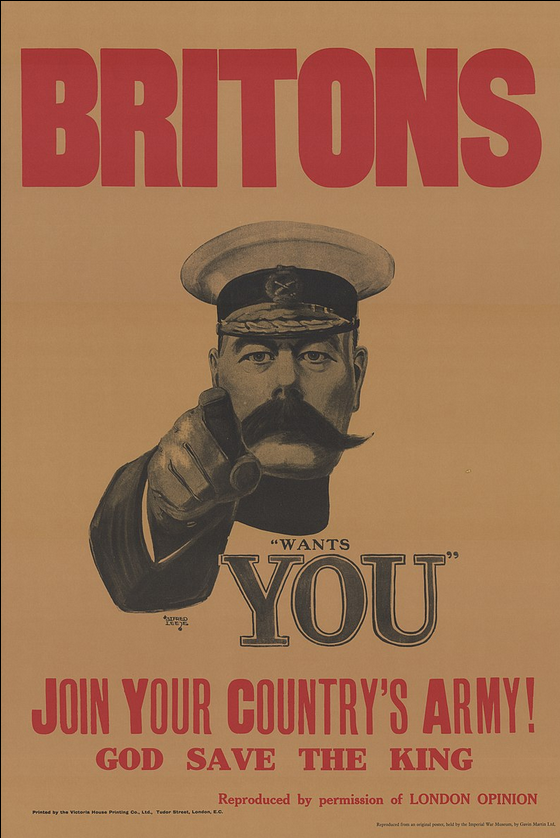 The famous WW1 Lord Kitchener recruiting ad
The famous WW1 Lord Kitchener recruiting ad
At 1730 hours on 4 August 1914 the Manchester Brigade of the East Lancashire Division, consisting of the Wigan based 5th Battalion and its sister battalions the 6th and 7th in Manchester, and the 8th in Ardwick were mobilised for war. The territorial soldiers were ordered to report with all their kit to their respective Drill Halls.
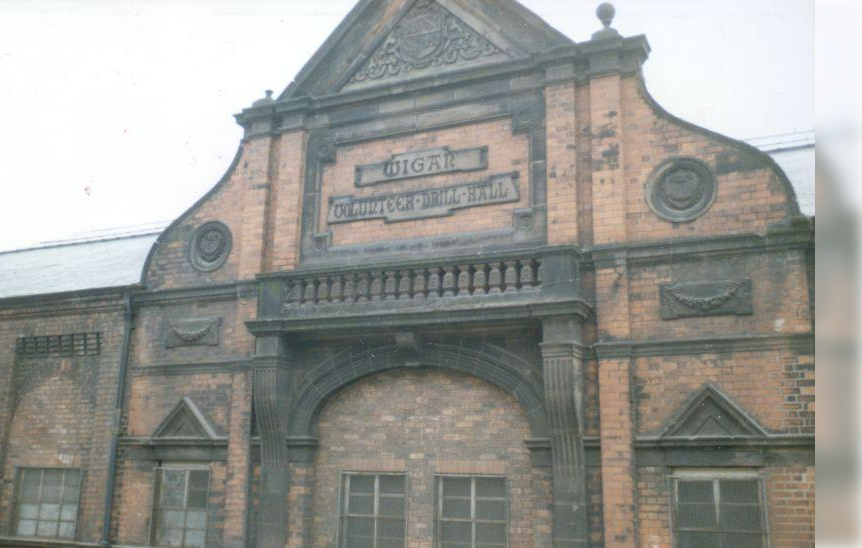 Volunteer Drill Hall, Powell St, Wigan
Volunteer Drill Hall, Powell St, Wigan
For the first couple of weeks after war being declared, the officers and other ranks remained within easy reach of their headquarters. Originally the Manchester Brigade’s War Station was to be in Ireland, but due to the political and military situation at the time the intended move did not materialise.
The Commanding Officer was Lieutenant Colonel W. S France whose headquarters was at Bank Chambers, located at the junction of Wallgate and Library Street in Wigan. The battalion had eight rifle companies in total. Five of the companies, ‘A’ to’ E’ were based at the Drill Hall in Powell Street in Wigan. ‘F’ Company was based in Eccles,’ G’ Company in Leigh and ‘H’ Company in Atherton.
On the morning of 7 August ‘G’ Company paraded in Leigh then marched to Wigan to muster with the rest of the battalion, ‘F’ and ‘H’ Company's arrived that evening. Apart from the Drill Hall, the troops were billeted in the Wesleyan, St. John’s & St. Mary’s and St. George’s schools.
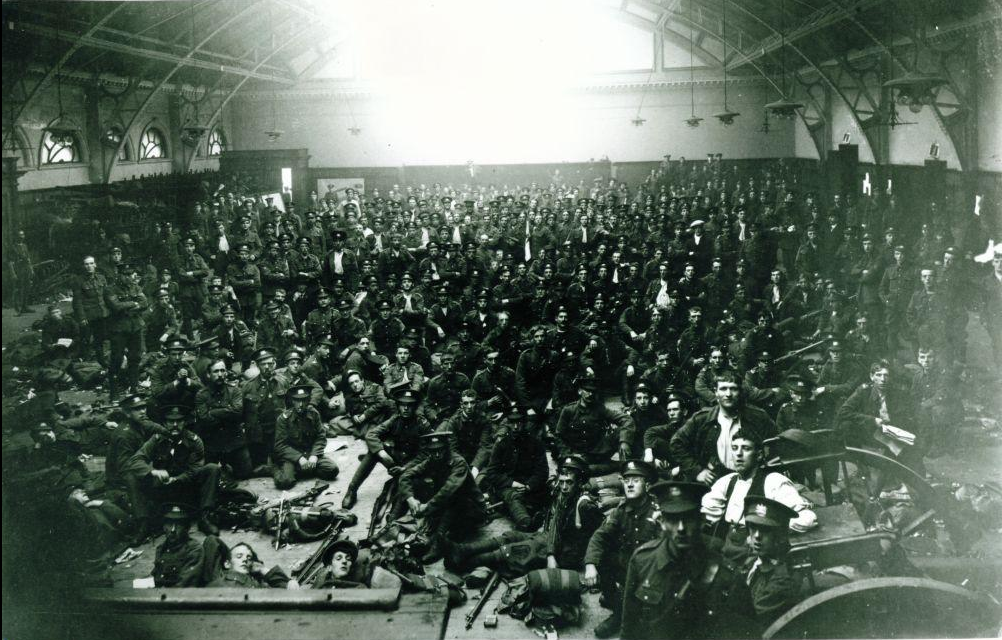 Troops in Wigan Volunteer Drill Hall, August 1914
Troops in Wigan Volunteer Drill Hall, August 1914
Frank and George along with hundreds of other part time soldiers marched out of Wigan Drill Hall on 20 August 1914, sadly many of them were never to return. The battalion moved to their allotted war station, a tented camp at Hollingworth Lake near Littleborough, to the north east of Rochdale, to await further orders.
On 10 August Lord Kitchener the Secretary of State for War, invited the Territorial Force to volunteer for foreign service. Within a few days the vast majority of the Manchester Brigade had done so. The unit was designated with the number one before the battalion number to indicate that it was now a First Line or Foreign Service unit and thus the Wigan Territorials became 1/5th Battalion Manchester Regiment.
(From now on in the narrative, unless out of necessity, 1/5th Battalion will be referred to as the 5th Manchester's, 5th Battalion, or simply the battalion.
On 2 September, Colonel France was appointed by the War Office to be a General Staff Officer 1st Grade and posted as Assistant Adjutant and Quarter Master General to the East Lancashire Division. His replacement, Major Henry Clayton Darlington was promoted to Lieutenant Colonel and took command of the battalion.
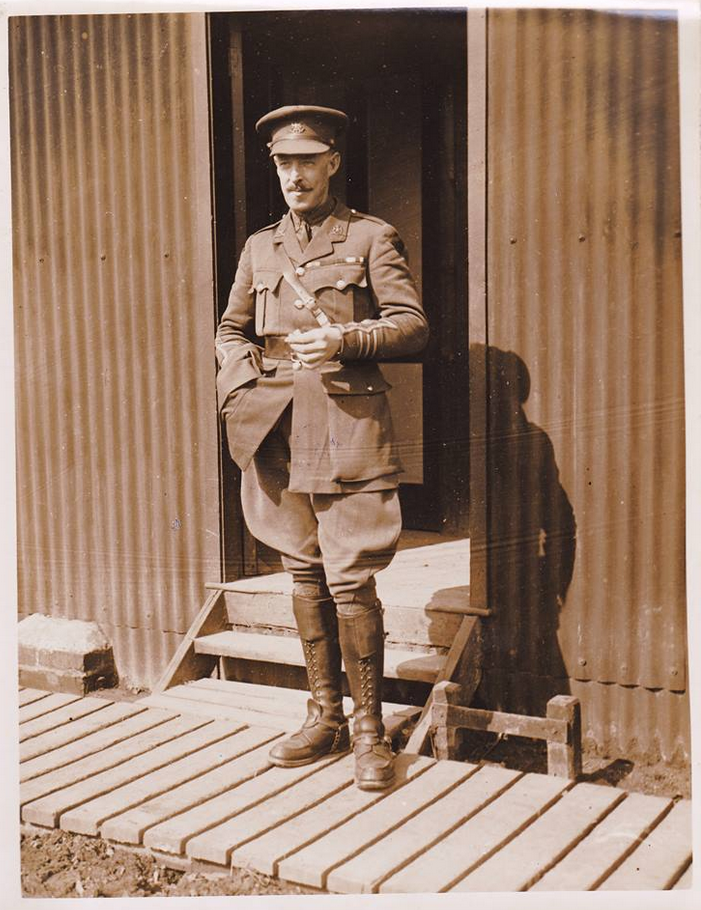 Lt. Col Henry Clayton Darlington C.O. 1/5th Manchester's
Lt. Col Henry Clayton Darlington C.O. 1/5th Manchester's
East Lancashire Infantry Division Order of Battle
The East Lancashire Division (later to become 42nd Division) was made up of three infantry brigades, the 125th (Lancashire Fusilier) Brigade, 126th (East Lancashire) Brigade, and the 127th (Manchester) Brigade.
Each brigade consisted of four infantry battalions. 125th Brigade consisted of 1/5th, 1/6th, 1/7th and 1/8th Battalions of the Lancashire Fusiliers. 126th Brigade consisted of 1/4th and 1/5th Battalions of the East Lancashire Regiments, and 1/9th and 1/10th Battalions of the Manchester Regiment. 127th Brigade had under its command, 1/5th, 1/6th, 1/7th, and 1/8th Battalions of the Manchester Regiment. Each brigade headquarters had under its command a machine gun company.
At the start of the war the British army didn't have any mortars but as these were developed a trench mortar battery was allocated to each brigade.
The East Lancashire Division Headquarters had under its command mounted troops in the form of 'A' Squadron, The Duke of Lancaster's Own Yeomanry, divisional artillery of two Royal Field Artillery batteries, and a battery from the Royal Garrison Artillery who had four 4.7 inch heavy guns. Also under its command was a machine gun company, eventually a heavy trench Mortar battery and three medium mortar batteries were allocated as divisional troops to be used at the discretion of the commander.
An Infantry Division just does not consist of infantry soldiers, but is supplemented by many hundreds of support troops, without whom the division would not function as a fighting force. Eventually the division had under its command three field companies of Royal Engineers, a divisional employment company from the Labour Corps, a Royal Engineers company of signallers, and a divisional train from the Army Service Corps who provided the transport and supply column.
Medical facilities were provided by three Field Ambulances, a mobile veterinary section and a sanitary section. Later in the war as tactics changed the number of battalions in each brigade was reduced from four to three. In February 1918, a pioneer battalion was attached, in the form of 1/7th Battalion Northumberland Fusiliers.
Middle East Expeditionary Force
Lord Kitchener had a low opinion of the Territorials and was more concerned with raising a new army. He described the divisions and regiments of the Territorial Force as "a town clerk's army." and thought these amateur soldiers might not be able to hold their own against the German Army. So he decided to send these forces to the peripheral campaigns; to India, the Sudan, Mesopotamia, Egypt, Aden, Malta and Gibraltar therefore releasing regular British Army soldiers for duty on the Western Front. It is estimated that five regular army divisions were created from troops released by Territorial Force deployments.
The East Lancashire Division was warned for movement on 5 September 1914 and on the 9th entrained for Southampton. About forty trains were required to transport men, horses, guns and all the materiel of war. The next day 20,000 Lancastrians, the vast majority of whom had never before left the shores of Britain, embarked on the great adventure. As part of the Middle East Expeditionary Force (MEF) they were the first Territorial Division to volunteer for foreign service and the first ever to leave England’s shores.
The convoy, escorted by HMS Ocean and HMS Minerva consisted of fifteen troop vessels with the Manchester Brigade on board the troopship SS Caledonia. (The Caledonia was later sunk by a German submarine, U65, 125 miles off Malta in December 1916 on route from Salonika to Marseilles).
The division arrived at Alexandria in Egypt on 25 September 1914, before moving to the Cairo area for acclimatisation and training and act as a deterrent to Turkish aggression. One battalion from the division was sent to Khartoum in the Sudan and half a battalion to Cyprus to guard key military installations.
The Manchester Brigade remained in Alexandria as garrison troops and to guard civilians of enemy nationality before their internment in Malta, 5th Battalion was quartered in Mustapha Barracks in the city. On 24 December 1914 Lieutenant Colonel Darlington received a telegram from the Mayor of Wigan, Councillor John Thomas Grimshaw, sending the battalion Christmas greetings.
 Telegram from the Mayor of Wigan received 24 December 1914
Telegram from the Mayor of Wigan received 24 December 1914
George didn’t travel to Egypt with Frank and the main body of men but arrived later on 5 November, the same day that Britain declared war on Turkey, turning Egypt into a war zone. On 19th January 1915 the Manchester Brigade moved from Alexandria to Cairo to take over garrison duties.
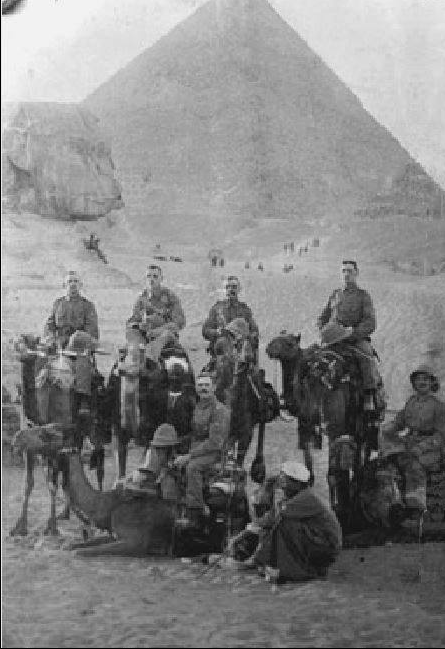 The Manchester's in Cairo
The Manchester's in Cairo
Dardanelles Campaign
The Dardanelles Campaign was an attempt by the Allies to force Turkey out of the war and relieve the deadlock on the Western Front in France and Belgium by opening a supply route to Russia through the 38 miles long Dardanelles Straits at Gallipoli, which divides Europe and Asia. Then on through the Sea of Marmara and into the Black Sea via the 18 miles long Bosporus Strait which divided the city of Constantinople (modern day Istanbul).
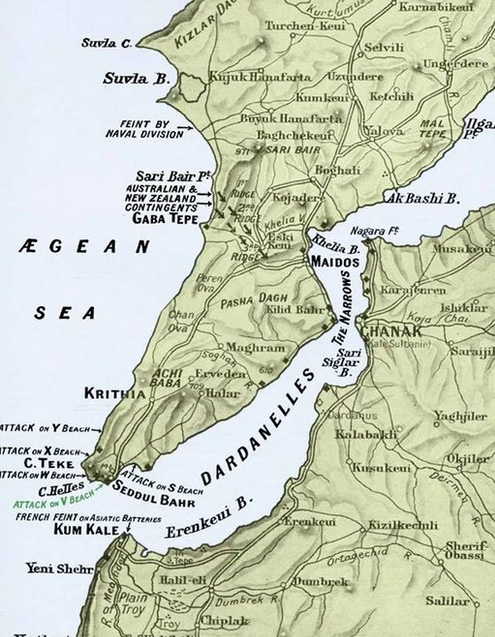 The Dardanelles, Turkey
The Dardanelles, Turkey
With the bulk of the British Army fighting on the Western Front it was originally meant as a naval only operation. On 17 February 1915 a British seaplane from HMS Ark Royal flew a sortie over the Straits. The next day the first attack on the Dardanelles began when a strong Anglo-French task force, began a long-range bombardment of the numerous Ottoman artillery forts along the coast.
However the Allies suffered badly, losing many ships to sea mines and artillery fire, so a decision was made for the army to invade the Gallipoli Peninsula. The invasion force was a hotchpotch of units, British regiments were brought back from India along with Indian troops and Gurkhas. The Anzacs from Australia and New Zealand sailed to the Middle East to join the campaign, also a French contingent joined the Force.
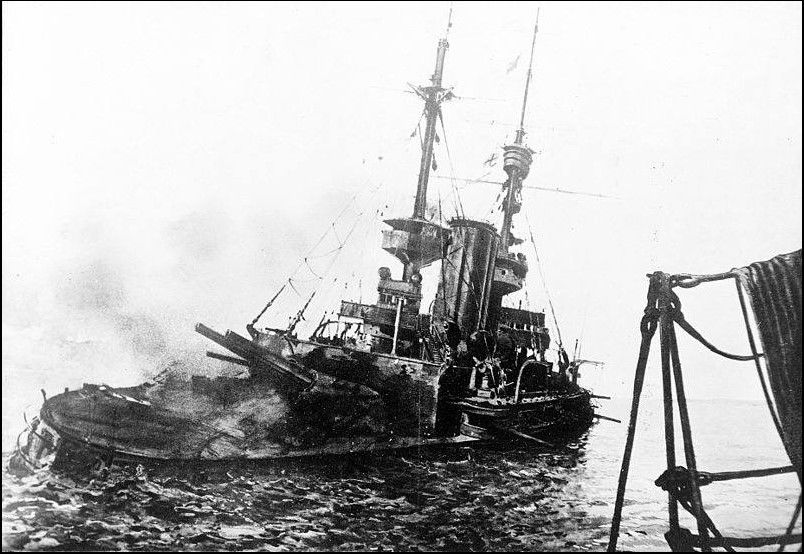 The last moments of HMS Irresistible, sunk in the Dardanelles Straits 18 March 1915
The last moments of HMS Irresistible, sunk in the Dardanelles Straits 18 March 1915
At the beginning of May 1915, the 5th Manchester's were at Abbassia Barracks in Cairo where they received orders for their move to Gallipoli. Frank and George were among thirty two officers and 816 other ranks who embarked aboard the Derfflinger (a German passenger ship belonging to the Norddeutscher shipping line that was captured at Port Said in August 1914). It had just arrived with casualties from the initial landings on Gallipoli.
They departed Alexandria at 1700 hours on 3 May. Whilst en route to Gallipoli Frank made out his will which was on the back page of his pay book. Completed in the standard format recommended, and written in pencil, it simply said:
‘In the event of my death I give all of my property and estate to Mrs Alice Taylor, 367 Warrington Rd, Wigan. Signed Cpl F. Taylor 5th Manch Reg. Dated 4/5/15’.
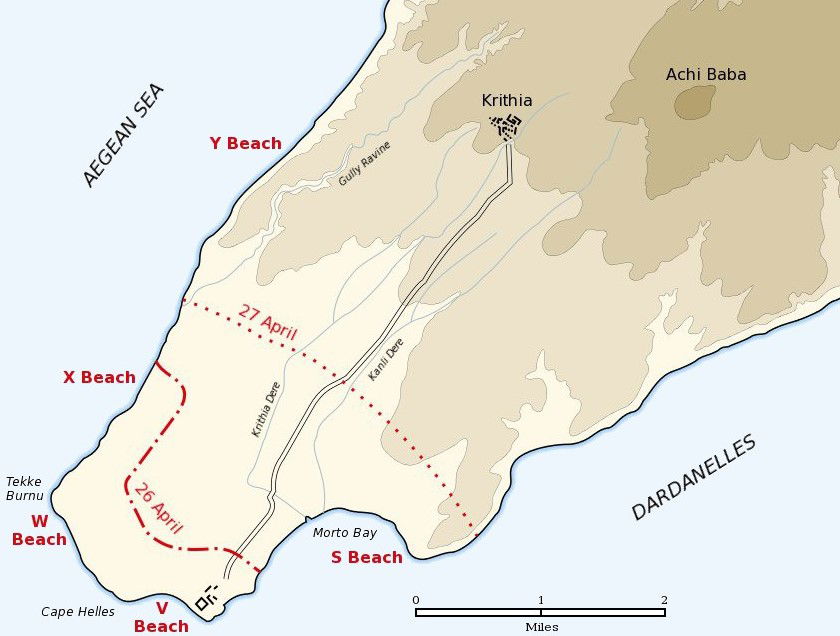 The locations of the five landing beaches at Cape Helles, Gallipoli
The locations of the five landing beaches at Cape Helles, Gallipoli
The Derfflinger arrived off the Dardanelles at 0530 hours on 6 May, disembarkation commenced on 'V' and 'W' Beaches at 1645 hrs and was completed at 2315 hrs. The General Officer Commanding, Sir Ian Hamilton had the beaches renamed 'Lancashire Landing' after the heroic efforts of the Lancashire Fusiliers who won six Victoria Crosses in the initial landings.
The Manchester’s spent the first night bivouacking on the bitterly cold beach. The blankets, stores and equipment had been left on board until the following day.
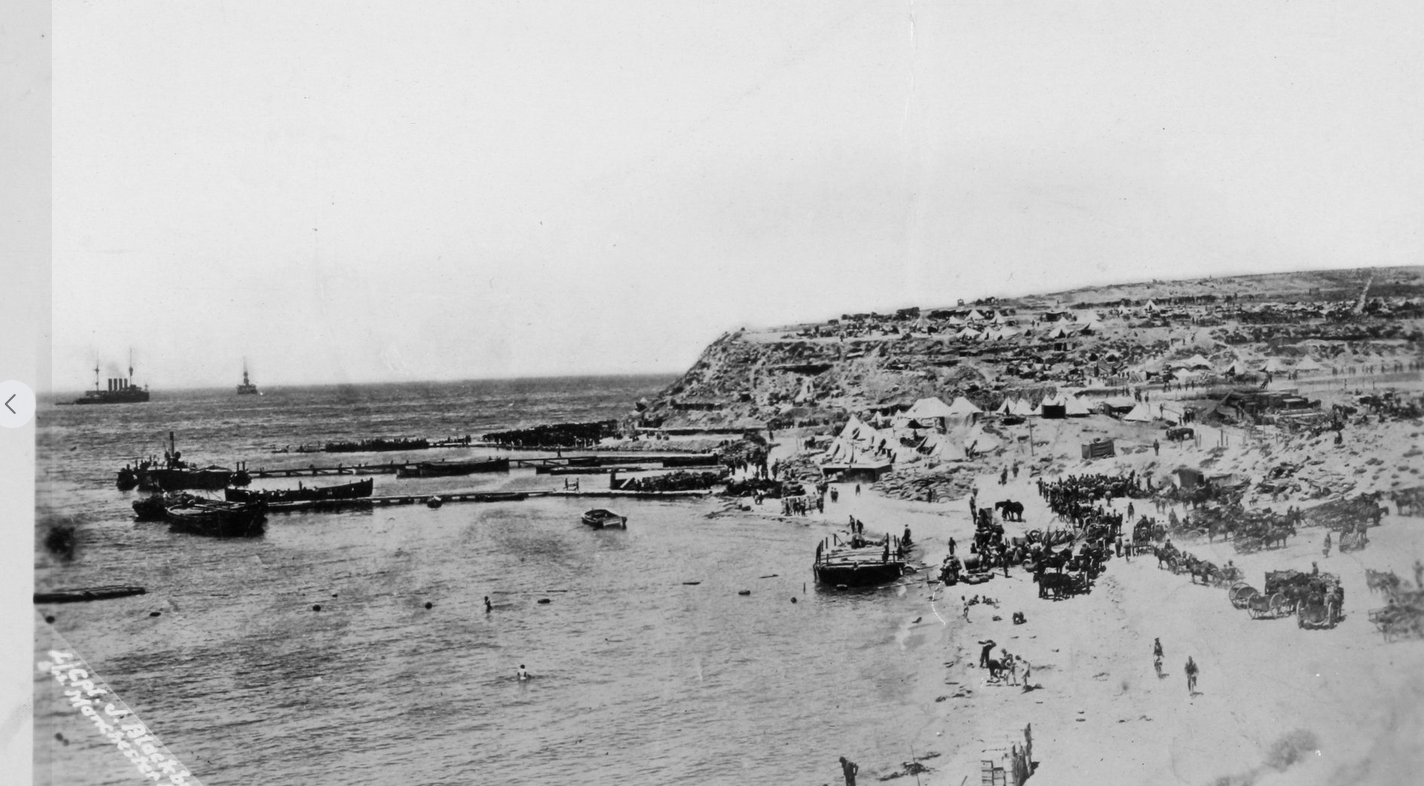 Lancashire Landing, Cape Helles, Gallipoli
Lancashire Landing, Cape Helles, Gallipoli
At 1900 hours on 7 May the Manchester's moved to the west of Krithia Bridge into reserve dug outs, before occupying reserve trenches the following day. On the 11th they moved up in to the support trenches, the next day the brigade made a feint attack to distract attention from movement elsewhere. On 16 May they occupied the front line trenches for the very first time.
The division was involved in three notable attempts to break out of the Helles bridgehead to capture the dominating heights around the village of Krithia. For the first attack, which took place between 6th and 8th May, only the Lancashire Fusiliers Brigade from the Division took part.
The troops soon learnt to take the threat from Turkish snipers seriously. They shot many men, officers and leaders being the prize target. Lieutenant Colonel Darlington wore webbing equipment, removed his badges of rank, and Sam Browne belt and pistol holster, replacing the latter with a rifle in an attempt to make himself a less conspicuous target for snipers. He wrote in his diary on 14th May 1915.
'The weather is perfect again. We had one day's rain and our trenches were a quagmire. We are still in the firing line reserve trenches and have to be careful showing up. Their snipers are very good and they now shell the trenches. They hit my dugout three times with shrapnel the night before last and my last dugout twice'.
'Young Walker was hit slightly in the head. Cyril Ainscough got a spent bullet in his foot and Cunningham was hit slightly in the face. They are all nothing and only Cunningham went to hospital. He was up here to see us to-day'.
'We have still no kits and I want a bath badly. I have a ground sheet and one blanket and no change, but it is much nicer having no luggage to bother about. The men take it very well, but of course have not faced much yet'.
'We had rather a bad time coming up, but it was more frightening than dangerous'.
'We have had one man killed and 20 wounded. The Turk aeroplane guns are beastly. The pieces fall and you can hear them coming for age, also sometimes you can see them falling in the sunlight, very slowly like a penny through water'.
'The Turks have a big gun up. They killed Frank James' horse with it yesterday. I am perfectly filthy with mud and want of a bath and change, but I am shaving. Archie Brook looks like a Turk himself with his beard'.
'I have stripped my badges, wear putties and a web kit and carry a short rifle'.
Here comes Archie. He wants leave to go out and bury 20 dead Turks just in front of his Trench. He is now with the Machine Guns. The aero is right over me now, I hope they won't shell it. It is a very good life this and makes you feel so fit.
5.15 p.m. I have been up and down the trenches all day driving people to deepen and improve. One gets sniped all the way. The country is a mass of furze and the snipers lie out in it for weeks with tinned food and snipe all day.
“They are apparently behind the lines and in between and are almost impossible to spot, the scrub is so thick.”
Third Battle of Krithia
On 25 May, the same day that the formation was re-designated as 127th Brigade, 42nd Division, the brigade moved up from the reserve trenches into the firing line. On 4 June the Manchester's finally received their baptism of fire when they took part in the Third Battle of Krithia.
The day started with a preliminary bombardment at 0800 hours, followed by a heavy bombardment three hours later. At 1120 hours there was a feint attack in an effort to divert the attention of the Turks away from the Manchester's. For the main attack 5th Battalion were in the centre with 8th Battalion to their left, 7th Battalion on the right and 6th Battalion in reserve.
 Shell landing on the Krithia Road
Shell landing on the Krithia Road
‘C’ and ‘D’ Companies from the 5th were the advance companies and captured the first line of trenches, where fierce hand to hand fighting took place. ‘A’ and ‘B’ Companies then leapfrogged them and by 1215 hours had secured the second line of enemy trenches 500 yards further on, and only 500 yards from the village of Krithia.
The Commander-in-Chief, General Sir Ian Hamilton, observing the attack on HMS Wolverine wrote in his diary:
' ..... the boldest and most brilliant exploit of the lot was the charge by the Manchester Brigade in the centre, who wrestled two lines of trenches from the Turks; and then carrying right on; on to the lower slopes of Achi Baba, having nothing between them and it's summit but the clear untrenched hillside. Then lay there - the line of our brave lads, plainly visible on a pair of good glasses - there they actually lay.'
The withdrawal of French troops and the Royal Naval Division forced the 7th Manchester’s on their right flank to pull back leaving ‘A’ and ‘B’ Companies of the 5th Battalion isolated and in a dangerous position in a salient ahead of all other allied troops. The Turks started to work round their right flank in an effort to cut the Manchester's off.
The two companies held on for six hours but with no reinforcements or support and in danger of being cut off they were ordered to withdraw back to the first objective, held by 'C' and 'D' Companies. On the first day of the battle Frank was given a battlefield promotion from Corporal to Sergeant after the battalion had suffered thirty eight killed in action and 137 wounded. The trenches were held during the first night despite two Turkish counter attacks.
The Manchester's still continued to hold the first objective during the next day despite receiving heavy enfilade fire and suffering casualties from the Turks who had entered their trenches on both flanks. They were unable to clear the enemy out due to a lack of bombs (Mills grenades), giving the four companies no choice but to withdraw back to their own front line trenches.
Despite artillery support which fired 1,700 rounds, shell fire from battleships and close support from four Rolls Royce armoured cars belonging to the Royal Naval Air Service the attack had been a failure.
A Turkish counter attack in the early hours of 6 June was repulsed, and for the next two days they remained in the front line trenches. The war diary entry for 7 June reported that the men were frightfully tired and suffering from want of sleep, but that morale was excellent. That day an attack by the 9th Manchester's on the left flank was successful, but owing to an unsuccessful assault by the Royal Marine Light Infantry they had to retire suffering heavy casualties in the process.
Finally at 1630 hours on 8 June they were relieved by the 9th Manchester's, the survivors of the battle moved back into Corps Reserve trenches. However no area of the Peninsula was safe from Turkish fire so troops who had just come out of the line were sent to the Greek islands for rest and reorganisation .
On 10 June the battalion received orders to stand by for embarkation to Imbros for reorganisation, but poor weather delayed their departure. Finally at 2000 hrs on 13 June the battalion left the reserve trenches. At 0300 hours the next morning they embarked aboard trawlers which transferred them to HMS Carron for the ninety minute journey to the island of Imbros.
Because of high winds and rough seas the disembarkation was delayed by six hours. The exhausted men finally pitched camp at 1530 hours. They spent a week on Imbros resting before returning to the peninsula.
The casualties over the four day battle were 56 killed in action and 178 wounded. These included the 127th Brigade Commander, Brigadier Noel Lee who was killed, and his replacement Lieutenant Colonel Heys who died shortly after.
 A surgeon from 2/2nd East Lancashire Field Ambulance of the 42nd Division removes a bullet from a wounded soldier in a makeshift Field Hospital at Cape Helles, Gallipoli.
A surgeon from 2/2nd East Lancashire Field Ambulance of the 42nd Division removes a bullet from a wounded soldier in a makeshift Field Hospital at Cape Helles, Gallipoli.
After the battle Lieutenant Colonel Darlington recommended four officers and two other ranks for awards for gallantry. These were Captain Woods and Lieutenant G. S James from 'D' Company, Second Lieutenant M. K Burrows, Captain Reddick of the Royal Engineers, Sergeant Whittle of 'D' Company and Lance Corporal Catterall.
Lieutenant George Sydney James who had been killed in action on the first day of the battle did not receive an award. He was buried in Redoubt Cemetery at Helles, Plot XE, Grave 20. He was 22 years of age. His older brother Captain Francis Arthur James was also serving with the 5th Manchester's. He was seriously wounded by a Turkish grenade on 16 September and died of his wounds two days later, aged 29.
The pair had two other brothers serving with 13th Battalion Middlesex Regiment in France. Charles who was killed in action ten days after Francis on 28 September, and Henry who died the following year on 18 August 1916.
Their father Charles was Vicar of St. David CE church in Haigh near Wigan, tragically he and his wife Emily had to suffer the loss of all their four sons within fourteen months.
Home to England
Great Uncle George was wounded on two separate occasions at Gallipoli. He first suffered a facial wound from shrapnel, losing all his teeth and was evacuated to Alexandria. On his return from Egypt he injured his leg on barbed wire carrying ammo up to the firing line. The wound became seriously infected and he was eventually evacuated back to the England on a hospital ship.
On his return George was admitted to a hospital in Manchester, then transferred to Wigan to recuperate at Woodlands No 1 Auxiliary Hospital in Wigan Lane run by the British Red Cross. The building was loaned by Lord and Lady Crawford of Haigh Hall in October 1914 and was the first Red Cross Hospital in the region to receive wounded soldiers. Lord Crawford himself served in the Royal Army Medical Corps on the Western Front as a medical orderly. Whilst home in Wigan George got to meet his son Frederick for the first time, who had been born in February 1915 while he was in Egypt.
On 9 August 1916, following his recovery, he transferred from the Manchester Regiment to the Royal Flying Corps, putting his carpentry skills to good use as an aircraft rigger. (The Royal Flying Corps was eventually merged with the Royal Naval Air Service on 1 April 1918 to create the Royal Air Force).
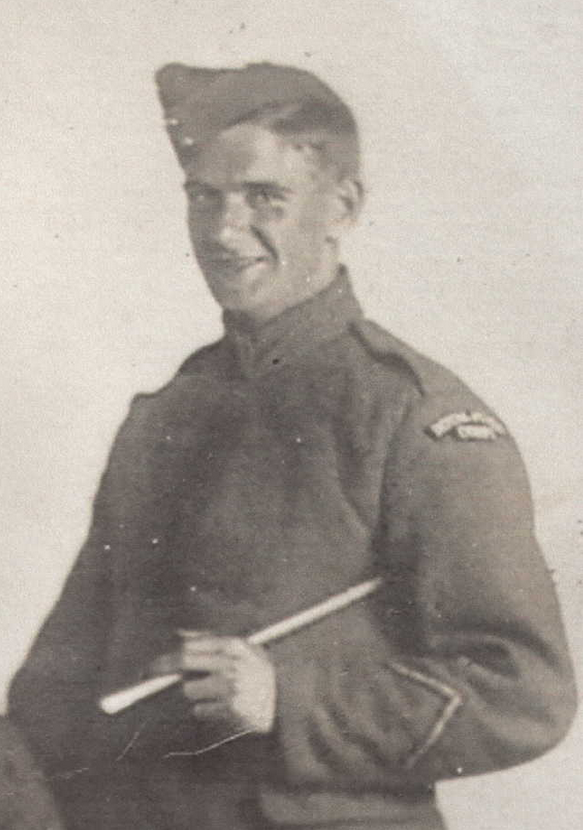 Airman George Taylor Royal Flying Corps
Airman George Taylor Royal Flying Corps
Battle of Krithia Vineyard
The Battle of Krithia Vineyard was planned to divert attention away from the landing at Suvla Bay and the break out from Anzac Cove, and would consist of two separate attacks over two days, the 6th and 7th of August, with a follow up action dependent on the success of these initial assaults.
The width of no-man's-land was shortened by a series of night digs that sapped the line forward. This brought the jumping off point for the attack to within 250 yards of the Turks. Two brigades from 42nd Division and a brigade from 29th Division took part in the operation but faced overwhelming Ottoman Forces consisting of four divisions with two more in reserve.
The 5th Manchester's took part in the first day's action and were attached to 88th Brigade from the 29th Division. The three battalions from 88th Brigade were 1st Battalion Essex Regiment, 2nd Battalion Hampshire Regiment and 4th Battalion Worcester Regiment. Their mission was the capture of 'H' Trench.
The 5th Manchester's were on the Worcester's right, their task was to attack two Turkish trenches, which were being used as bomb stations, 'A' and 'D' Companies were to attack trench H 11a with 'B' and 'C' Companies to assault trench H 11b, both of which overlooked the deep ravine of Krithia Nullah. Neutralising these bomb stations was important as they would pose a threat to 42nd Division's attack the following day. The preliminary bombardment to the attack started at 1400 hours but failed entirely to neutralise the enemy trench line.
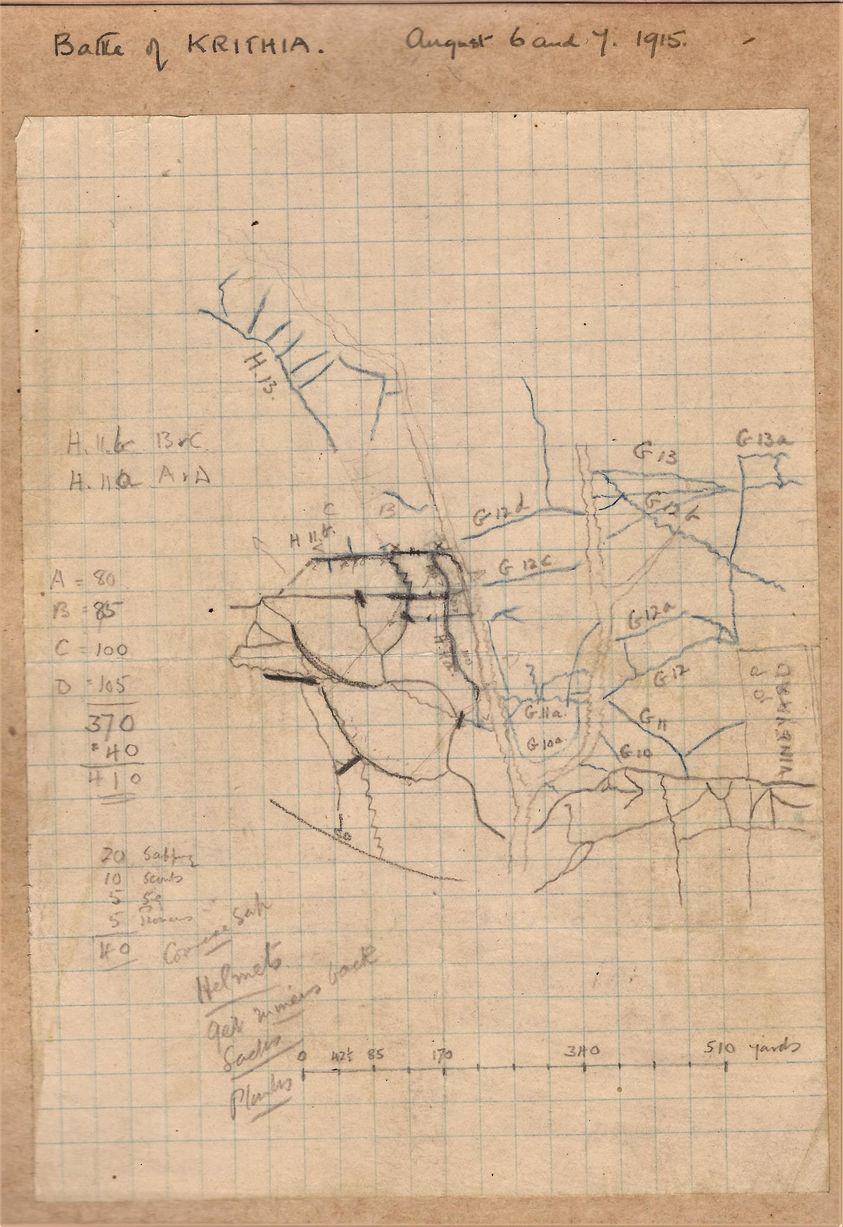 A sketch by Lieutenant Colonel Darlington showing the battalion's objectives at Krithia Vineyard on 6 June 1915.
A sketch by Lieutenant Colonel Darlington showing the battalion's objectives at Krithia Vineyard on 6 June 1915.
On leaving their trenches at 1540 hours all the battalions came under murderous rifle and machine gun fire and shrapnel from artillery shells. The Essex captured their part of 'H' Trench but were later pushed out by counter attack. The Hampshire's were cut down by machine guns before they even reached their objective.
The Worcester's managed to reach the enemy trenches, a group of thirty men led by a Sergeant managed to occupy a section of 'H 13' trench thirty or forty yards in length. They remained there all day against overwhelming odds; just twelve survivors returned to their original line after midnight.
The 5th Manchester's on the right flank also took heavy casualties during the assault. They got in amongst trenches H11a and H11b but failed to hold them. The battalion war diary notes that 'our own artillery dropped some shells in our own trench. No counter attack'.
The attack had been a complete failure, largely in part to the failure of artillery support. The Worcester's came off worse, losing sixteen officers and 752 other ranks in the attack, at least three officers and sixty-eight other ranks, mostly from 'X' Company were captured and spent the remainder of the war in a Turkish Prisoner of War Camp. This was the worst single day's casualties of any battalion at Gallipoli.
It's 768 casualties in one day amounted to 93 percent casualties, killed, wounded or missing. These were shocking statistics in the context that it was supposed to be merely a diversionary attack in support of the Anzac and Suvla operations.
At 0900 hours the next morning the preparatory artillery bombardment for the second phase of the operation started, with the attack going in at 0940 hours. 42nd Division less 5th battalion were ordered to attack H 11a and H 11b trenches again. The infantry attack failed and the battalion war diary was once again critical of the artillery. Noting that the preliminary bombardment was ineffective and they had been badly shelled by their own artillery causing at least thirty casualties. That night they received 100 reinforcements from the 9th Manchester's.
Over the two day period of the battle, 5th Battalion suffered twenty killed in action, 158 wounded and 51 missing, a total of 229 casualties.
Frank was wounded on 6 August, receiving a bullet wound to his back. He was evacuated to 19th General Hospital in Alexandria for treatment, followed by a spell in the nearby Mustapha Convalescent Camp which had been set up by Lady Haig, the wife of Field Marshall Haig.
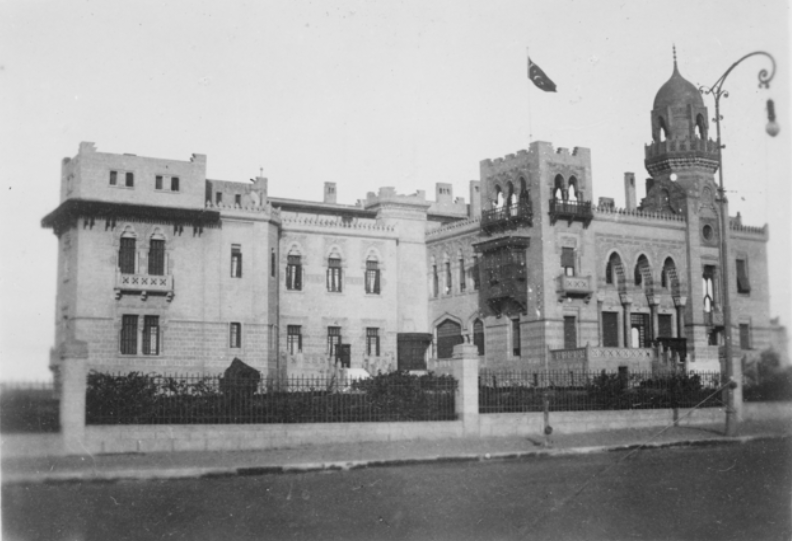 No. 19 General Hospital, Alexandria, Egypt
No. 19 General Hospital, Alexandria, Egypt
Sergeant Thomas McCarty won the Distinguished Medal for bravery that day for rescuing some of his men trapped in a trench. An account from the Wigan Military Chronicle held at the Imperial War Museum tells the story.
'Sgt. T. McCarty twice rushed the enemy bomb pit under heavy rifle fire and although men from neighbouring platoons found their way into the position, they were all casualties. After about an hour, as there were not enough men to offer an effective resistance, Sgt. McCarty, again working under a hot and accurate rifle fire, tore away a sandbagged barricade and extracted the whole of the party including all of the wounded. A survivor wrote shortly afterwards, "All the time he was working they were shooting at us down the trenches, every shot hit, and if he had not made the road none of us would have got out'.
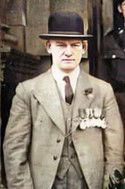 Sgt. Major Thomas McCarty DCM
Sgt. Major Thomas McCarty DCM
(Thomas who later became a Sergeant Major was a well-known Wigan wrestler. In 1919 he was appointed trainer for Wigan Rugby League Club, a position he held for twenty years. He was trainer when Wigan won the Challenge Cup for the first time in the 1923-24 season beating Oldham 21-4. Also when the final was played at the Empire Stadium, Wembley for the first time in the 1928-29 season when Wigan beat Dewsbury 13-2. Thomas died in 1954 aged 71, at the time he was living in Orchard Street, Scholes. He is buried in Gidlow Cemetery, plot 19, grave 469 RC.)
Killed in action on 6 August was Captain Cyril Ainscough, the Officer Commanding 'A' Company. Despite being ordered by Lieutenant Colonel Darlington not to go in the first wave, he never the less led his men in charging the enemy positions. He had already been wounded three times at Gallipoli and had recently returned from hospital in Alexandria. Twenty two years old Cyril was from a prominent local family and lived at Fairhurst Hall in Parbold. He has no known grave and is commemorated on the Cape Helles Memorial, stone number 158A. There is also a stone tablet to his memory in Our Lady & All Saints RC church in Lancaster Lane, Parbold.
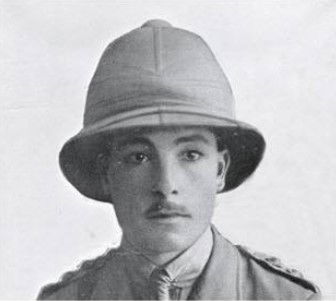 Captain Cyril Ainscough, killed in action 6 August 1915 at the Battle of Krithia Vineyard, Gallipoli.
Captain Cyril Ainscough, killed in action 6 August 1915 at the Battle of Krithia Vineyard, Gallipoli.
Trench Warfare
From September onward there were few offensive operations and Helles settled down to trench warfare. The troops were employed sniping, bombing, carrying parties up to the front line, trench improvements, and salvage duties day and night.
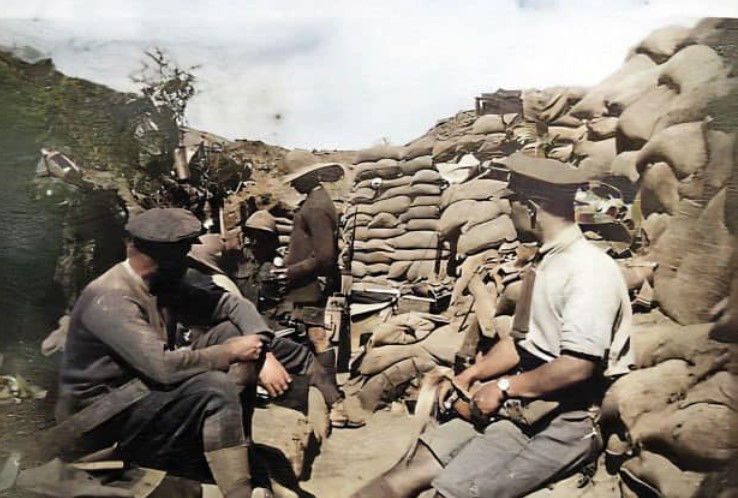 5th Manchester's in reserve trenches
5th Manchester's in reserve trenches
After three months recuperating in Egypt Frank had recovered enough to re-join his battalion in the Dardanelles, his pay book shows that he was paid in Mudros, Greece in November and that he received £2 pay at Gallipoli on 13 December. Four days later he was promoted to Acting Company Quartermaster Sergeant (CQMS).
His role as CQMS of ‘B’ Company made him the second most senior Non Commissioned Officer in the company and deputy to the Company Sergeant Major. His day to day job entailed being in charge of the company’s general stores, including the horses and wagons, and for the issue of weapons, ammunition, equipment, clothing, rations and provisions.
Inhospitable Conditions
Gallipoli had been an inhospitable place to fight a war, characterised by rocky ground with little vegetation and hilly land with steep ravines. During the summer months, it was blisteringly hot and 100 degrees in the shade was registered.
The heat, putrefying bodies left in no-man's-land and unsanitary conditions led to huge swarms of flies and mosquitos which made life almost unbearable for the men there. The flies plagued them all the time, covering any food they opened, which helped the spread of disease such as jaundice and dysentery.
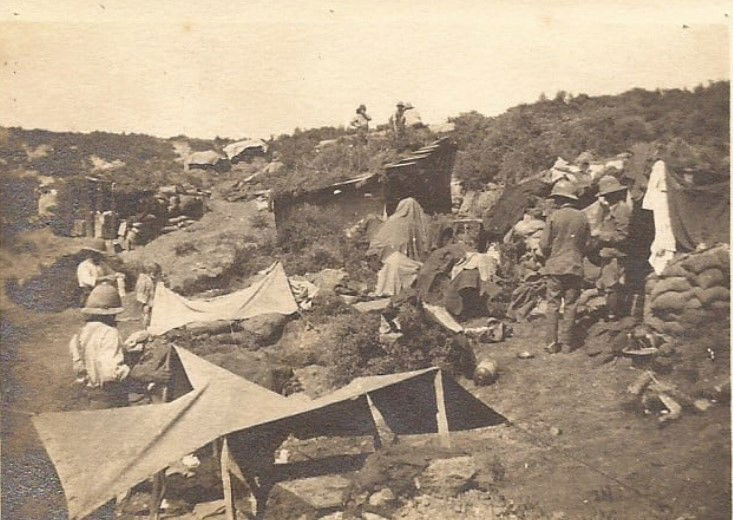 Bivouac in Gully Ravine
Bivouac in Gully Ravine
By the end of July all members of the battalion had been given the Cholera inoculation but the war diary entry for 18 August states that Veldt Sores (the symptoms of infectious cutaneous Diphtheria) was now prevalent.
Despite several truces arranged to recover and bury the dead there was a constant smell of a mix of human excrement (diarrhoea was a major problem and troops could not leave their trenches for proper field latrines) and that from bodies decomposing in the heat.
The extreme weather conditions on the peninsula meant that the temperatures could also plummet, and in the autumn and winter of 1915, large numbers of troops suffered from trench foot and frostbite. In November the weather deteriorated rapidly with heavy rain and snow flooding trenches and dugouts, the former becoming canals forcing men to stand precariously on the narrow fire-steps and risking becoming targets for snipers.
There were reports of British soldiers dying of exposure or drowning in the torrential downpours and flooded areas. Over 5,000 more had to be evacuated, suffering from frostbite and hypothermia. One particularly violent storm, with hurricane force winds, rain, sleet and snow, swept the Peninsula from the 26th to 28th November, destroying the piers and lighters on the beaches upon which the Force was entirely dependent for its supplies.
Every drop of water on the Allied side had to be brought to the peninsula by sea. Consequently it was mostly used for cooking. There was never enough for drinking especially in the heat of the summer. Even less was available for personal hygiene which made the troops more susceptible to sickness, disease and the ever present lice.
The rations supplied to the troops consisted mainly of tinned salted bully beef, Maconochies stew, bacon, cheese, hard tack biscuits, and apricot jam, the sparse amounts available was a source of much complaint. Many men became malnourished and suffered from ulcers.
The Evacuation
In October 1915 the overall commander at Gallipoli General Sir Ian Hamilton was recalled to London, effectively ending his military career. His replacement, Lieutenant General Sir Charles Munro arrived on 28 October to take charge. Two days later he had visited all three sectors of the front line and quickly concluded that the campaign had been a failure and that there was no realistic chance of capturing the peninsula. He recommended that a phased withdrawal from Gallipoli be undertaken.
Winston Churchill on learning of the suggestion criticised Munro saying: He came, he saw, he capitulated'.
Lord Kitchener decided to see Gallipoli for himself and sailed for Gallipoli in early November. He was shocked by what he saw. On 15 November he cabled the Dardanelles Committee that he had reached the same decision as Munro.
Churchill, the architect of the ill-fated campaign was on the receiving end of much criticism, forced out of office and demoted. He resigned from the government and elected to become an infantry officer on the Western Front. He became Commanding Officer of the 6th Battalion Royal Scots Fusiliers in France until April 1916, after which he returned to government.
On 7 December the Committee finally decided to evacuate the peninsula. Because of the obvious dangers of a fighting withdrawal it was decided to devise a deception plan. The Allies needed to evacuate around a quarter of a million men. Firstly the French troops were taken off to simplify the command structure.
Because of a lack of available shipping a two stage evacuation plan was devised, Anzac Cove and Suvla Bay would be first, followed by the Helles bridgehead. The main architect of the Anzac and Suvla evacuation plan was Lieutenant Colonel Cyril Brudenell White, the ANZAC Chief of Staff.
The Anzac evacuation was to be in three stages, the first two were kept on a 'need to know basis'. Troops were told they were going to Lemnos for a rest.
Firstly all non-essential troops were evacuated along with the horses and mules, artillery pieces, vehicles and equipment. Anything that was to be left behind was either dumped in the sea, destroyed or buried.
To lull the Turks into a false sense of security rifle and artillery fire was reduced to minimum to get them used to quiet spells. In an appearance of normality cricket and football matches were played in the rear areas that were overlooked by the Turks.
At night, from the positions north of Walker's Ridge stretching through the ranges to Hill 60, mule columns looked after by men of the Indian Mule Corps took supplies up to the front line troops as normal. Unbeknown to the Turks they returned to William's Pier on North Beach heavily laden with material for evacuation.
To maintain the appearance of normal operations though, some material was still brought ashore at the Anzac Cove and North Beach piers during the day. On the beaches the illusion of stacks of wooden ration crates was created by means of constructing an outer framework only, making it appear the massive piles were solid.
During the next phase the number of fighting units were gradually thinned out leaving enough on the front line to withstand a Turkish attack. So as not to be picked up by aerial observation their presence in the trenches was supplemented by uniformed, scarecrow like dummies made out of straw filled old jackets and hats.
 Straw dummies used as part of the deception plan in the evacuation of Gallipoli
Straw dummies used as part of the deception plan in the evacuation of Gallipoli
When the troops realised that they were being evacuated many paid visits to the little graveyards scattered all around to tidy them up and pay their last respects to fallen comrades.
An ingenious invention by Lance Corporal William Scurry of 7th Battalion, Australian Infantry Force was the 'drip' rifle, a self-firing rifle. This was to play an important part in the success of the operation.
Firstly a rifle was wedged into position on the parapets of the front line trenches. An empty ration can or kerosene tin was hung from the trigger by a string, another tin higher up with a hole in the bottom was filled with water. The water in the top tin dripped into the bottom one, eventually the weight pulled the trigger firing a round off. The holes in the top tins were of different sizes, ensuring that rifles would fire at intermittent intervals, from twenty minutes to an hour.
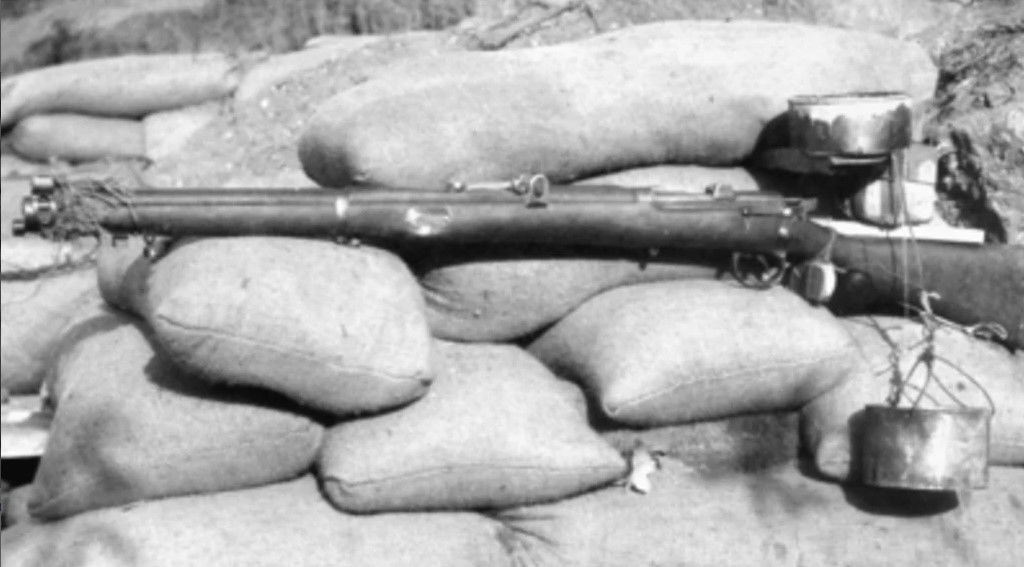 The drip rifle invented by Australian William Scurry
The drip rifle invented by Australian William Scurry
By 19 December only 10,000 soldiers were left to be evacuated, and on that day the British at Helles launched feint attacks in an effort to divert attention away from Anzac.
On the last night little presents were left in the trenches for the Turks to find in the form of booby trapped watches, hats, boots and personal equipment. At 0230 hours on the morning of the 20th the last remaining 300 troops of the rear parties set their drip rifles which would keep firing long after they had departed.
With hessian sacks wrapped round their boots they crept away for the 35 minute walk to the beach and on to HMS Cornwallis, the last ship to leave Anzac North Beach. The plan worked perfectly with no incidents or casualties.
The same plan and tactics that had been employed at Anzac and Suvla so successfully were used at Helles. At 2130 hours on 29 December 1915 it was the turn of the 5th Manchester's, the remnants of the battalion embarked at ‘V’ Beach onto SS Hibernia and then transported to Mudros on the Greek Island of Lemnos.
By 9 January 1916 the last of the Allied troops had been taken off the peninsula with hardly any casualties. Although the campaign on the peninsula had been a disastrous failure, the overall evacuation was a brilliant success.
The Cost
It is no understatement to say that Gallipoli was one of the worst fronts to serve on in World War One. During the eight month campaign 559,000 allied troops took part, 420,000 from Britain and the Empire, 80,000 French, 50,000 Australian, 9,000 from New Zealand and 1,000 Newfoundlander's. (Newfoundland was a British Dominion and wasn't to unite with Canada until 1949).
In 1913 the Germans established a military mission in Constantinople led by General Otto Liman von Sanders and by the outbreak of World War One all land, sea and air forces, were commanded by German officers, as was weapons and ammunition production.
It is estimated that between 1,600 to 1,700 German military personnel were directly involved in the fighting at Gallipoli. These included 400 navy gunners manning the coastal artillery, 150 field artillery gunners, 300 marines made up machine gun teams using the infamous Maxim machine gun, 250 pilots and technicians from the navy and air force, 400 pioneers, and a field hospital containing 50 doctors and nurses. Also there was 100 command, communications, and logistics personnel.
The allies suffered over a quarter of a million casualties, 58,000 killed in action and 196,000 wounded or sick. Disease and sickness produced considerably more casualties than the fighting itself. The Ottomans, including some Germans suffered a third of a million casualties, including 87,000 dead.
The 5th Manchester's had suffered a total of 686 casualties, comprising of 151 dead, 478 wounded and 57 missing. Men also died of sickness and disease. Six separate drafts had arrived, bringing in 361 replacement troops for the battle casualties.
On withdrawal the effective strength of the battalion was 239 all ranks from a total of 1,179 who had fought in the campaign. From the original 818 members of the battalion that started the campaign only 152 remained and from the 361 replacements, only 87. A costly attrition rate of eighty per cent casualties. 42nd Division's casualties at Gallipoli were 395 officers and 8152 other ranks killed, wounded or missing.
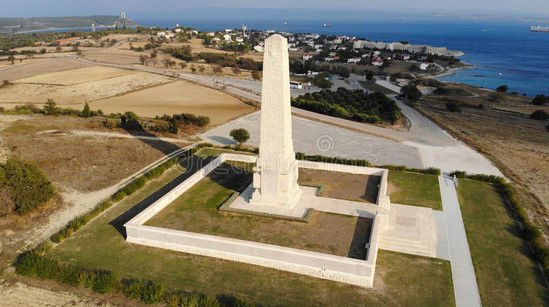 Helles Memorial, Gallipoli
Helles Memorial, Gallipoli
The Helles Memorial to the Missing stands at the tip of the Gallipoli peninsula and contains 20,960 names. It takes the form of an obelisk 30 metres high and can be seen by ships passing through the Dardanelles Straits. There are four more memorials to the missing on the peninsula and thirty one Commonwealth War Graves cemeteries,
The Sinai Campaign
On 18 January 1916, after sitting out a violent storm for five days, 5th Battalion left their tented Camp at Sarpi and returned to Egypt. After disembarking in Alexandria they travelled by train to Cairo and then by road to another tented camp at Mena adjacent to the Great Pyramids of Giza. On 10 March 1916 42nd Division became part of the newly formed Egyptian Defence Force for the upcoming Sinai and Palestine Campaigns.
Although the Turkish Army had suffered heavy losses in the Gallipoli campaign the threat to the security of the Suez Canal from the Ottoman Empire still remained. The importance of the canal to the British Empire cannot be underestimated and it was vital that it was kept open as a gateway through the Red Sea to India and the Far East.
The Canal Zone stretched 120 miles from Port Said on the Mediterranean coast to the Gulf of Suez. There are three routes by which a hostile force might approach the canal. The northern Caravan route along the coast through El Arish to Kantara, the route by which Joseph’s brethren, and later the Holy Family, and in more recent times Napoleon and his army in 1798 had travelled from Palestine to Egypt. The central Hassana to Ismalia route and the southern Akaba to Suez route. It was Akaba that Lawrence of Arabia was to attack and capture the following year with a force of Arab tribesmen.
Up to present the Canal defences had been on the West Bank, close to the canal. It was now recognised that it had to be defended from the eastern side, so it was decided that a line of outposts was to be constructed in the desert, far enough out to prevent the enemy from bringing guns into action within seven miles of the waterway. These posts were to be garrisoned by a battalion of Infantry, a battery of Royal Artillery, a troop of Yeomanry Cavalry and a section of Royal Engineers.
After a couple of weeks in Cairo resting, refitting and absorbing much needed reinforcements into the various battalions, 42nd Division was assigned to cover the southern Akaba to Suez route. They moved to Jabal ash Shallufa, at the southern end of the Great Bitter Lake and twelve miles or so north of Suez, concentrating in a camp in the desert east of the Suez Canal.
Miles of barbed wire entanglements were put up and trenches were dug and revetted with wooden frames and hurdles backed with canvas in an effort to stop the sand from refilling the trenches. In due course roads and light railways were run out to the posts, and three inch water pipes were laid. Each post was named after the depot towns of the battalions, Manchester, Salford, Ashton, Wigan etc.
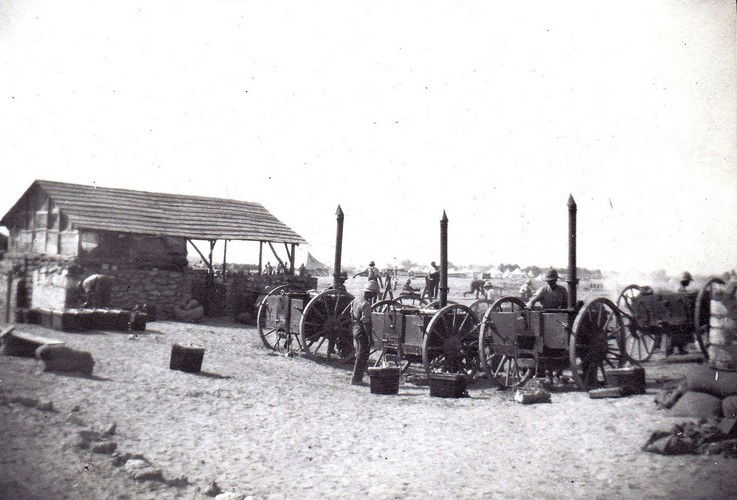 Field kitchens at Suez 1916
Field kitchens at Suez 1916
At the beginning of April, after a two month stint manning the outposts, the division left Shallufa to camp in the desert about two miles north west of Suez. Engineers erected a large number of huts and a macadam road was made through the camp. In this more permanent camp conventional military and physical training was undertaken in earnest, relieved by games and sports such as rugby, football, wrestling and hockey. Donkey polo and camel racing brought a welcome distraction and entertainment for the troops.
As was to be expected the rugby team from the 5th Manchester’s based around the Wigan area won great acclaim and beat all comers. As did the famous wrestlers from the battalion such as Thomas McCarty. Canteens were set up to provide the troops with cigarettes, biscuits, chocolate and other sundries. A Dramatic Society was formed and plays put on at the ‘Theatre Royal’.
The Battle of Romani
On 19 June, 42nd Division was ordered to relieve 11th Division in the El Ferdan sector in the central section of the Canal Zone, midway between Ismalia and Kantara, the 5th and 7th Manchester’s were attached to the 52nd Lowland Division further to the north. The heat was unbearable with temperatures of 120 degrees in the shade normal, and temperatures of 105 degrees at midnight registered on two occasions.
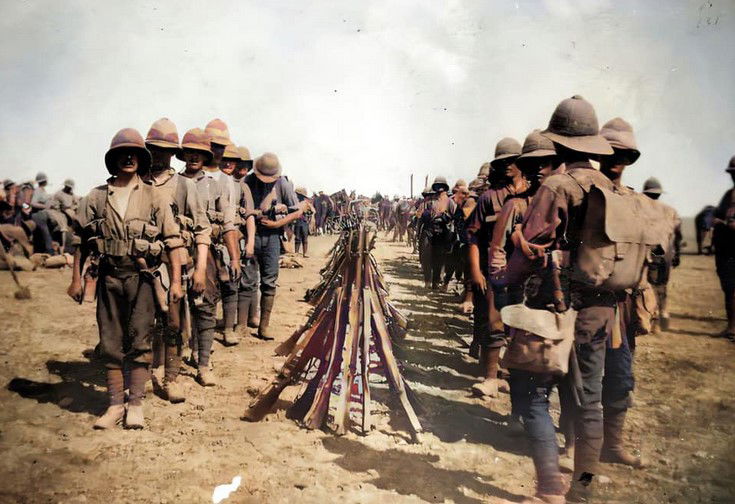 Troops falling in and collecting weapons
Troops falling in and collecting weapons
Towards the end of July information was received that the 18,000 strong Ottoman 4th Army led by German General Frederich Kress Von Kressenstein, was moving swiftly westwards along the Mediterranean coastal route towards El Arish. 42nd Division was hurriedly ordered north to Kantara, the 6th Manchester’s based at Pelusium heard artillery fire from the direction of Romani announcing that the Turkish attack had begun. The remainder of 127th Brigade was ordered to Pelusium and just as the last battalion was detraining Brigadier General Ormsby received the order to march at once in support of the Anzacs who were heavily engaged in the area of Mount Royston, to the south of Romani.
Within three minutes of receiving the order the 5th, 7th and 8th Manchester’s moved off into the desert leaving 6th Battalion to await the arrival of the supplies and transport. As the Brigade neared the Anzac positions with the 5th and 7th battalions leading they could see the Turkish shrapnel bursting overhead. At about 2,000 yards from the enemy positions the two leading battalions extended into lines, the 7th on the left, the 5th on the right and attacked the ridge of Mount Royston.
With the arrival of 127th Brigade the enemy fell back, some surrendering. The Anzacs then went on the attack from defence, their cavalry sweeping behind the hill to cut off the fleeing Turks. Seven officers and 335 enemy soldiers were captured.
127th Brigade had marched across three miles of deep loose sand, suffering under a blazing sun, in the hottest season of the year and came into action less than 1 hour 33 minutes after receiving orders to move.
The action prompted a congratulatory telegram from King George V himself which read: ‘Please convey to all ranks engaged in the Battle of Romani my appreciation of the efforts which have been brought about the brilliant success they have won at the height of the hot season and in desert country’.
The Battle of Romani was the first large-scale mounted and infantry victory by the British Empire in the First World War. It occurred at a time when the Allied nations had experienced nothing but defeat, in France, at Salonika and in Mesopotamia. British casualties in the battle were 70 killed in action, 27 later dying of their wounds and 259 wounded, a total of 365.
Following the victory at Romani, which had effectively ended the immediate threat to the Suez Canal, Commonwealth Forces pursued the Turks through the desert, defeating them two days later at Katia. This series of successful British infantry and mounted operations resulted in the complete defeat of the Ottoman force, which suffered an estimated 9,000 casualties and nearly 4,000 taken prisoner.
Also captured were a mountain gun battery of four heavy guns, nine machine guns, a complete camel-pack machine gun Company, 2,300 rifles, a million rounds of ammunition, and two fully equipped field hospitals. While a large quantity of stores in the supply depot at Bir el Abd was destroyed. All the captured arms and equipment were made in Germany, and the camel-pack machine gun company's equipment had been especially designed for desert warfare.
On 9 January 1917 a desert column of the Mounted Anzac Division, attacked and defeated an entrenched 2,000 strong Ottoman Army at El Magruntein to the south of Rafah, close to the frontier between Egypt and the Ottoman Empire to the north and east of Sheikh Zowaid. The Battle of Sinai was over.
In early February 1917 the soldiers of 42nd Division discovered they would not be remaining in Egypt to take part in the Palestinian campaign, which would culminate in the capture of the Holy City of Jerusalem. Instead they were scheduled to depart Egypt for France and join the war on the Western Front. Now their experience and reputation gained as a fighting force would be put to a greater test.
The 42nd Division had proved the doubters, including Lord Kitchener, wrong. The part time soldiers from Lancashire had built up an enviable reputation in Gallipoli and Egypt which won praise from all quarters. On 20 February 1917, before their departure the Commander in Chief of the Egyptian Expeditionary Force, General A. J Murray wrote to Major General Sir William Douglas KCMG, CB, DSC, the Commander of 42nd Division.
'Dear Sir William Douglas
It is always a grief to a Commander to lose any of his troops and I am very grieved at having to part with the magnificent Division under your Command.
The 42nd Division is going where the greatest call is being made on the Empire and I have not the least doubt that it will add in France further credit to that it has already gained on the Canal and in Gallipoli in 1915, and in the Sinai Desert in 1916. It is a record to be proud of. The appearance of the Division on parade today, it’s steady marching, smartness and fit of equipment reflects the greatest credit on you, your Brigade Commanders and all ranks.
I wish you and the whole 42nd Division God speed in your new adventure and feel sure that one and all will do their duty to the utmost of their power and that after the arduous training of desert campaigning, hardships will have no terrors for the Division.
Goodbye and good luck to you all.'
The rising casualty rates of front line units meant an increasing number of soldiers transferring between regiments. The Territorial Force four digit regimental numbering system tended to cause confusion, so on 1 March 1917 a new system was introduced where each battalion was allocated a block of 6 digit numbers. The 5th Battalion was allocated numbers 200001 to 250000. Frank’s new number was to be 200036. From now on casualty replacements would come from various regiments and depots and from all parts of the country. The headquarters was still Wigan and at its core were local soldiers but it would cease to be an all Lancashire battalion.
The Western Front
At 0900 hours on 2 March 1917, Frank was among thirty one Officers and 919 other ranks of the 5th Manchester’s who left Egypt after two and half years active service in the Middle East. They departed Alexandria onboard the Troop Transport ship ‘Corsican’ and sailing via Malta they arrived at Marseilles on the 8th. The sea was too rough to enter harbour so disembarkation only commenced at 1400 hours the next day.
After their trials and tribulations on the Gallipoli Peninsula and the deserts of Egypt and Sinai the Territorials from Lancashire were about to experience trench warfare in France and Flanders for the first time. The Western Front stretched 440 miles from the Swiss Frontier to the North Sea in Belgium. For the next two years they were to lead a nomadic life, marching hundreds of miles up and down the front line, from Peronne in the Somme Valley to Nieuwpoort Bains on the Belgian coast.
From the docks at Marseilles they were transported 590 miles by train to Pont Remy, near Abbeville in Northern France, followed by an eleven miles march to billets in Cerisy-Buleux. 42nd Division were now part of 3rd Corps of the 4th Army under the command of General Henry Rawlinson.
The next two weeks were spent training and refitting, they handed in their obsolescent Long Magazine Lee Enfield rifles and were equipped with the modern Short Magazine versions. On 28 March the battalion left Cerisy-Buluex and started the slow inexorable journey east to the front line and whatever fate awaited them.
They travelled via Hallencourt, Pont Remy and Chuignolles to Villers Carbonnel, where from 31 March to 21 April the battalion was in Corps Reserve employed on road-making, with the exception of ‘B’ Company which was employed in the erection of the new Fourth Army Headquarters. From Villers Carbonnel the battalion moved via Peronne to Flaucourt where they underwent four more days training prior to going in the line.
The weather during this period was very poor with rain and even snow falling. After being in the Middle East for the last couple of years the battalion suffered badly from the weather conditions and during the month of April a total of 53 men were admitted to hospital. However the Commanding Officer reported that the battalion was still in good shape.
Whenever possible new divisions to the Western front were assigned to a quiet sector of the line in order to gain experience of life in the trenches. They would be used as defensive troops holding the line, until they were deemed capable enough to be used as offensive attacking troops.
On 30 April the battalion relieved their sister unit the 7th Manchester’s for their first spell in the trenches at Epehy, halfway between Cambrai and Saint-Quentin. ‘B’ Company occupied the left sub-sector, ‘D’ Company on the right, ‘C’ Company were in support, with ‘A’ Company in reserve. Epehy proved to be a quiet sector apart from the daily shelling.
That day the war diary noted that the strength of the battalion was 1008 all ranks, broken down as follows:
There were twenty seven officers & 787 other ranks with the battalion. Five officers and 55 other ranks were on courses of instruction. Eight officers and 106 other ranks were on leave. Two officers and 20 other ranks were sick and three officers and 40 other ranks were detached on other duties.
On 1 May 1917 the battalion suffered their first casualty in France, who was wounded from shellfire. The next day the Commander of 127th Brigade, Brigadier Ormsby was killed by artillery fire whilst touring the front line. Lt. Colonel Darlington took over temporary command of the brigade, the command of the 5th Manchester's being entrusted to Major E. Fletcher.
The next day the battalion handed the trenches over to the 7th Manchester’s and came out of the front line into reserve positions. Whilst in reserve two companies had to be ready to move up to the front line at 30 minutes notice.
The Brigade now fell into a routine, consisting of tours of duty in the front line trenches, a move back to the reserve trenches, followed by a short periods as Brigade Reserve, then rotating back into the front line.
Intermittently, when the tactical situation allowed it, the battalion would go into Divisional Reserve, or even Corps Reserve, moving to a safe rear area for rest and refitting. There would be a visit to the divisional showers, reissue of kit and equipment and integration of draft replacements from depots in France and England. There would be regular church parades and visits by senior officers awarding gallantry medals, training programmes would then start.
These included route marches, weapon training, musketry on the ranges and instruction in gas warfare, not forgetting the more mundane tasks of guard duties or fire piquet. As well there would be recreational activities and sports which relieved the stress of war and the monotony of soldiering. The army saw sports as good for morale, fitness, and keeping soldiers out of trouble.
In their spare time, soldiers gathered in the YMCA hut, the centre of their social life, and wrote letters and diaries, read books and magazines, pursued hobbies, played cards or gambled. The cycle would then continue with a move back into Brigade Reserve. This system of rotation, along with occasional leave to England, prevented many soldiers from breaking down.
Brigade Reserve invariably involved work details, such as moving ammo and stores up to the firing line or helping the Royal Engineers digging and repairing trenches, wiring and road making. Sometimes they acted as labourers for the tunnelling Companies.
The Trench System
It was widely acknowledged that German trenches and defensive positions with deep reinforced dugouts were far superior to that of the British. When hostilities stalled after the Battle of Marne in September 1914, the Germans withdrew to a fortified trench line. By the end of 1914, both sides had dug in for a long war of attrition.
In contrast to the British trenches, the German trenches were defensive structures, sophisticated and elaborate, with some of the living quarters almost 50 ft. below the surface. Some German trenches had electricity, beds, toilets, and other necessities that differed from the open-air trenches of the Allies.
However the British Army discouraged making trenches too fortress like as they were considered only temporary structures from which to dominate ‘No Man’s Land’, conduct offensive operations and gain ground.
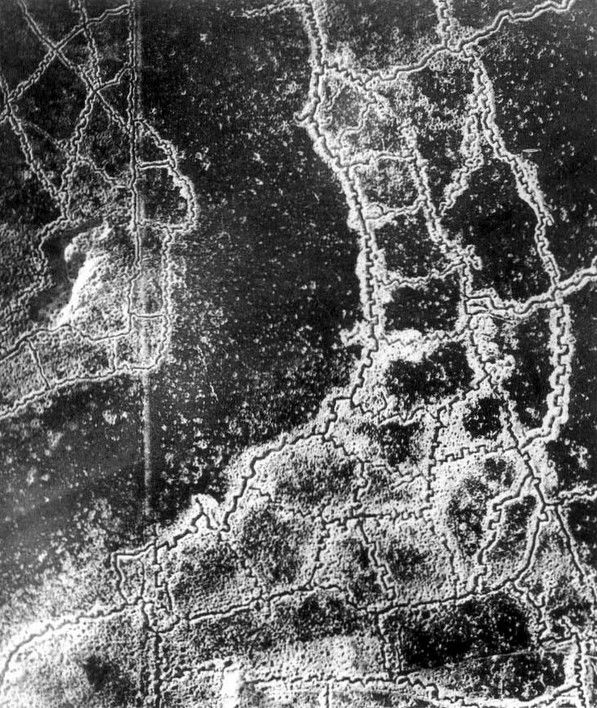 Aerial view of the trench network on the Western Front showing the area of No-Man's-Land in between the opposing trenches
Aerial view of the trench network on the Western Front showing the area of No-Man's-Land in between the opposing trenches
Trenches weren't dug in straight lines but in a zig zag or castellated pattern to prevent the enemy firing along the trenches and to limit the blast effect from artillery and mortar shells. Sometimes the trenches were just dug straight into the ground. This method was called entrenching. It was fast, but left the soldiers open to enemy fire while they were digging. Sometimes they would build the trenches by extending a trench on one end. This method was called sapping. It was safer, but took longer. The safest way to make trenches without enemy interference was tunnelling but it was the most difficult method. When the tunnel was complete the roof was removed.
The Allies used four types of trenches. The first was the front-line trench (firing trench) which would be at varying distances from the enemy front line depending on the terrain or tactical situation.
Behind the front line was the support trench which, as its name implies, supported the front line trenches with reinforcements and supplies.
After the support trench lay the reserve trench which was an emergency for the soldiers if they were ever overrun. Connecting these trenches were the communication trenches which allowed the soldiers to send messages, men and supplies between the trenches without going overground.
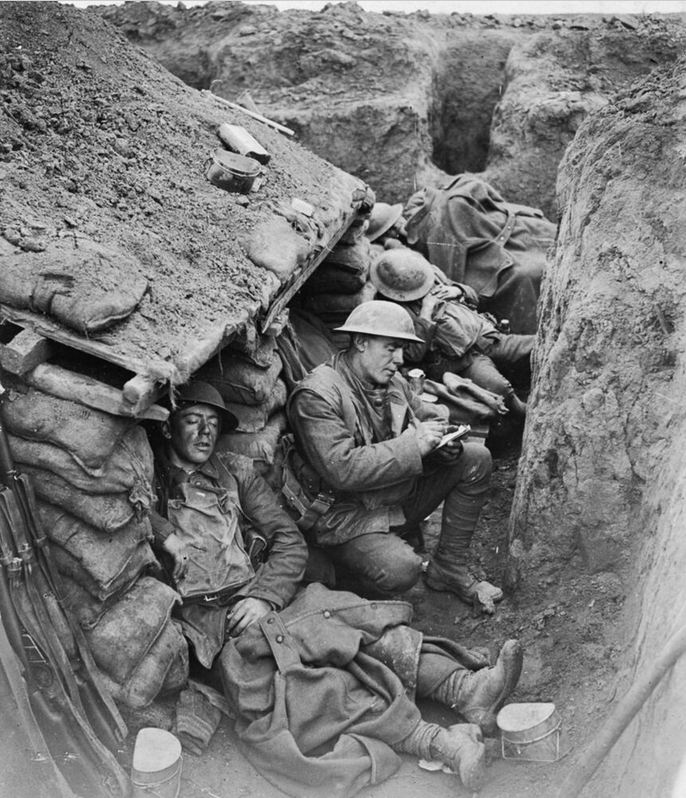 Life in the trenches
Life in the trenches
A typical trench was about six feet wide and eight or nine feet in depth with a rampart of soil on the lip. Along the lip was a line of wire connected to pickets called an apron. Further out were lines of thick barbed wire entanglements or concertina wire. A tactic used was to set up barbed-wire entanglements in a way that channelled attacking infantry into the killing zones of machine gun fire.
Being a member of a wiring party was a very common task for every infantryman. This work, carried out at night, involved carrying out steel pickets six feet in length and rolls of wire. The pickets were knocked into place by mallets muffled with sandbags. Later a spiral shaped picket was used that could be screwed into the ground without making a noise.
Because flooding was a problem, especially in the Flanders area with its high water table, sandbags covered with soil had to be built up at the side of the trenches to give height to the trench and protect the occupants from incoming fire. Also wooden duckboards were laid across the floor of the trench to aid movement and in an effort to keep feet dry. However in bad weather trenches still flooded and soldiers found themselves wading through knee deep water. Prolonged immersion in water led to the dangerous condition of trench foot which incapacitated many soldiers.
Time Expired
On 5 May 1917 my grandfather, now with the rank of Colour Sergeant and holding the appointment of Company Quarter Master Sergeant proceeded on a month’s leave to the UK, his first home leave for two and half years.
On enlistment Territorial Force recruits were engaged for up to four years. After this period the soldier would ‘Time Expire’ and could leave the service or extend it in further blocks of four years. On 1 January 1916 this was to change; the Military Service Act (MSA) came into force imposing conscription for the first time. It also meant that any ‘Time Served’ Territorial soldiers could be compulsory re-enlisted if they filled the criteria of the MSA Act. They would then be required to serve for the duration of the war.
This is exactly what happened to Frank, whilst in the UK he was re-engaged into the colours at Preston and was paid a bounty of £5 before returning to his unit in France.
On 16 May whilst Frank was on home leave in England 127th Brigade Headquarters issued Order No. 15 advising all units that the brigade and attached troops consisting of 1/2nd (East Lancashire) Field Ambulance, 427th Field Company Royal Engineers and 431st Company Divisional Train, would move to the Ytres, Neuville-Bourjonval, Ruyaulcourt and Bertincourt areas preparatory to taking over a brigade front east of that area on the 19th.
The next day the brigade handed over Epehy and 5th Battalion marched 16 miles via Villers Faucon to billets at Bertincourt. On the night of the 19/20th May, 127th Brigade took over the front line from 61st Brigade. At 2030 hrs the 5th Manchester's left Bertincourt and relieved 7th Battalion Kings Own Yorkshire Light Infantry in the front line just to the east of Ruyaulcourt. The positions were in the Havrincourt Woods area but the Germans had felled all the trees and left them on the ground.
The brigades left flank was a bend in the Canal du Nord, which was still under construction. (Work had started on the canal in 1908 but stopped at the beginning of hostilities. It was to be 46 years before construction recommenced and the waterway finally opened to the public in 1965).
During the handover/changeover process each Company signed for all the paraphernalia that went with occupying the trenches. Small arms ammunition, gas gongs, rattles, and rockets, SOS grenades, trench stores, water tins, trench maps, aeroplane photos, defence schemes and papers relative to their sub sector. Both 61st and 127th Infantry Brigade Headquarters were notified that the relief was complete by wiring of the code-word ‘Daisy’.
That night a patrol led by an NCO reconnoitered a feature ahead of their positions shown on trench maps as Yorkshire Bank, this was in fact a chalk spoil heap from the construction of the nearby canal. The enemy was heard working with spades but their position was not pin pointed.
On the 21st the war diary notes that during the day a great number of enemy observation balloons were up. It then rained for 24 hours and the trenches became waterlogged. During the night of the 22nd/23rd an officer led a reconnaissance patrol to Yorkshire Bank. They spotted an enemy patrol of nine men on the northern edge of the spoil heap and heard work being carried out in the German trenches.
For the next five weeks the brigade was employed with improving the existing trench network and pushing the front line trenches forward in the area to the west of the German held town of Havrincourt. The town was heavily defended with a triple belt of barbed wire entanglements.
The brigade scheme called for two battalions to be in the front line with two in reserve. The 5th and 7th battalions worked together and the 6th with the 8th in their sector of the line. Digging trenches was no problem for 5th Battalion, the majority of them being miners and used to working with pick and shovel. They weren’t known as the ‘Colliers Battalion’ for nothing..
Work started with the draining and improvement of trenches and extending the reserve line during the night. On the 26th Lieutenant Colonel Darlington proceeded on a ten day Commanding Officers conference, Captain A. L Bryham assumed command. On the night of the 27th/28th a junior NCO, Lance Corporal Burrows went missing. He went forward from his listening post, contrary to orders and failed to return.
The battalion war diary entry for 30 June 1917 signed by Captain (Temporary Major) A. L. Bryham gives a detailed and fascinating insight into the administrative workings of the battalion and life on the front line for the previous month.
The battalion suffered their first fatality in France on 2 June when one soldier was killed by shellfire, along with three others wounded.
Working in conjunction with their sister battalion, the 7th Manchester’s, the two units worked day and night, relieving each other in the left sub sector of the front line, and providing work parties when in reserve. Concertina wire was made and carried up to forward dumps along with material and stores belonging to the Royal Engineers, also tea, water and rations was taken to the companies in the front line.
A new intermediate line was dug, the reserve line was improved and a support trench was completed. On 5 June work was started on a new communication trench across 'Yorkshire Bank'.
During the night of the 8th/9th work on the new front line continued, covering parties were sent forward about 150 yards in advance of the working parties. The new line established across Yorkshire Bank was made continuous for about 160 yards, 50 yards to a depth of four feet six inches, the remainder to a depth of two feet six inches.
There was opposition from small parties of the enemy and during one encounter Private Thompson from ‘A’ Company went missing with his Lewis machine gun. The next evening a patrol led by an NCO went out in search of the missing soldier, his dead body was found still holding the machine gun in his hands. At the same time a party of four or five Germans was seen heading in their direction, so the patrol withdrew back to their own lines with the body of their 19 year-old comrade and his recovered weapon. He was buried in Ruyaulcourt Military Cemetery, Row 'A', Grave 15.
201508 Private Albert Thompson was born in Salford in 1896, one of nine children to William Thompson, a railway clerk and his wife Alice. The 1911 census finds them living at 6 Tolson Street, Lower Broughton, Salford, later moving to 8 Mildred Street in Lower Broughton. Albert is shown as working for a provisions merchant as a messenger boy.
He enlisted into the Manchester Regiment at Eccles in October 1915, aged 18, and was posted to 3/5th Battalion, the reserve and training unit. On completion of his military training he was sent to 42nd Division Infantry Base Depot located in Etaples, France, then posted to 1/5th Battalion.
Work continued throughout June on the new front line, on the 27th work proceeded on the communication trench adjacent to the canal, shown on trench maps as 'Henley Lane', which connected the reserve and support lines. Also the fire steps and parapets on the new front line on Yorkshire Bank were improved.
On the night of the 28th/29th the battalion was relieved by the 7th Manchester’s in the left sub-sector of the front. The following morning they went into billets at Ruyaulcourt, all except ‘C’ Company. They remained in position in a sunken road to the west of Yorkshire Bank on the south bank of the canal. It faced the village of Hermies which was in ruins, the bridge over the canal leading to it had been destroyed, as had all the bridges. All sub units were under orders to be in 30 minutes state of readiness.
Whilst in reserve at Ruyaulcourt 210 other ranks were inoculated with the TAB (Typhoid) vaccine. The troops underwent training under Company arrangements with special attention being made to smartening up and rapid fire practice, meanwhile the Company signallers trained under the battalion Signals Officer.
 Trench map corrected to 3 January 1918 showing the line of outposts along Yorkshire Bank facing Wigan Copse, constructed by the 5th Manchester's in June 1917
Trench map corrected to 3 January 1918 showing the line of outposts along Yorkshire Bank facing Wigan Copse, constructed by the 5th Manchester's in June 1917
Subsequent trench maps, updated after the work was completed show that the line of outposts established along the Yorkshire Bank feature facing Wigan Copse were named ‘Wigan Post, ‘Yorkshire Post’ and ‘Antrim Post’.
(Today the A2 Autoroute that travels 47 miles from the A1 near the commune of Combles in Picardy to Mons on the Belgium border cuts through the middle of the old trench system and Wigan Copse).
The diary entry dated 30 June 1917 shows the battalion in good shape with nearly a thousand men under its command. However, after deducting the soldiers on home leave in England, in hospital or on courses or various attachments away from the unit, the battalion’s fighting strength was 24 officers and 718 other ranks, a total of 742 men.
During June the battalion had suffered seven killed in action. One officer and 15 other ranks had been wounded, one later dying of his wounds, three were classed as 'NYDN' (Not Yet Diagnosed Nervous), a medical term for shell shock. Two officers and 63 other ranks had been admitted to hospital sick during June, including one kicked by a mule. One officer and 69 other ranks had returned to the battalion from hospital.
The strength returns of the unit showed a total of 40 officers and 947 other ranks but of these 16 officers and 229 other ranks were detached from the unit for various reasons leaving an effective strength of 24 officers and 718 other ranks. This meant that 60 per cent of the officers and 25 per cent of other ranks were non effective.
At the time three officers and 38 other ranks were on leave in England, 38 other ranks were sick in Field Ambulances and four were having dental treatment. Seven officers and sixty other ranks were on various courses and one officer and 40 other ranks were at 127th Brigade school. Two other ranks were working for the town mayor.
Every battalion had to provide personnel that would be employed at brigade, division, corps or even army level. Three officers and nine other ranks were working for Brigade Head Quarters, another three on traffic control, two at brigade workshops and one with brigade signals.
At divisional level one officer and one other rank were at headquarters, four were working at the laundry, two in the soup kitchen, one at the divisional baths, six at the hay making company and one with the divisional burial company.
Five soldiers were attached to Third Corps Light Railway and three to the Commandant Royal Engineers 1st Division, whilst another three were at the Ammunition Ordnance Department. A Sergeant was a musketry instructor at Pont- Remy, near Abbeville on the Somme.
Five soldiers were awaiting joining instructions at the Infantry Base Depot at Etaples, and one NCO was an instructor there. Whilst Calais was used mainly for stores, and ammunition, etc. the most important base for the British Army and Imperial soldiers was Etaples on the coast, most of the Infantry Base Depots were located here using Boulogne as its port for personnel. Sixteen military hospitals were also located in the area.
(The camps at Etaples held up to 100,000 men. In theory, the base held a ten percent reserve for every front line battalion, but these figures fluctuated significantly depending on the levels of casualties at the front and the supply of fresh troops from England. Etaples had a notorious reputation where troops held at the base were ‘toughened up’ while waiting dispatch to the front. The instructors, most of whom had not seen active service were nicknamed 'Canaries' by the troops. Conditions were so bad that a series of mutinies involving thousand of soldiers occurred in September 1917. The rebellion was put down with severe punishments being meted out. Some ringleaders were executed and long prison sentences handed out to others).
The Casualty Evacuation Chain
Daily life on the front line was monotonous but very perilous. Apart from the dangers from artillery, trench mortars, gas shells or snipers the unhygienic conditions of the trenches soon depleted the effective combat strengths of infantry regiments. The battalion war diary shows a constant trickle of men admitted to hospital sick.
Apart from the rats the scourge of trench life was the infestation of lice which led to soldiers coming down with trench fever, which could keep them out of action for a month or more. Another common complaint was scabies, a rash caused by mites. In the winter months, standing in mud and water for long periods of time led to trench foot, a very painful condition which could result in gangrene and amputation of toes or even feet.
By the time of the Manchester’s arrival in France the casualty evacuation chain run by the Royal Army Medical Corps for wounded and sick soldiers was an efficient, tried and tested procedure that stretched from the front line all the way back to hospitals in Britain.
Casualties were first attended to at a rudimentary care point within a few hundred yards of the front line. Regimental Aid Posts run by the Regimental Medical Officer were set up in small spaces such as communication trenches, ruined buildings, dug outs or deep shell holes. The walking wounded struggled to make their way to these whilst more serious cases were carried by comrades or sometimes stretcher bearers. The Aid Posts had no holding capacity and here, often in appalling conditions, wounds would be cleaned and dressed, pain relief administered and basic first aid given.
If possible men were returned to their duties but the more seriously wounded were carried by Royal Army Medical Corps stretcher bearers often over muddy and shell-pocked ground, and under shell fire, to the Advanced Dressing Station, sometimes via a collecting post or relay post to avoid congestion.
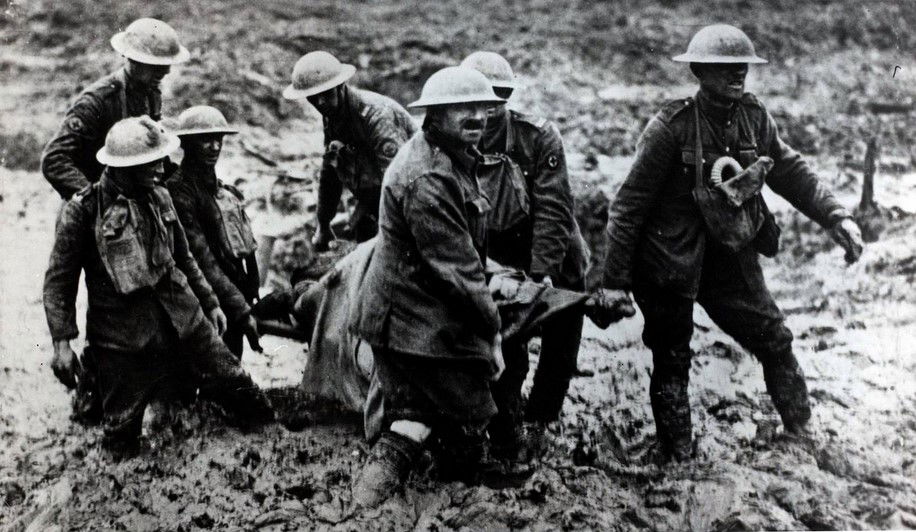 Stretcher bearers carrying a wounded soldier through the Passchendaele mud in 1917
Stretcher bearers carrying a wounded soldier through the Passchendaele mud in 1917
The dressing stations would be sited four or five hundred yards behind the Aid Posts in ruined buildings, underground dug outs and bunkers, in fact anywhere that offered some protection from shellfire and air attack. They did not have holding capacity and though better equipped than the aid posts’ could still only provide limited medical care.
In times of heavy fighting the dressing stations would be overwhelmed by the sheer number of casualties arriving and often wounded men had to lie in the open on stretchers until attended to by the medics. Here the sick and wounded were further treated so that they could be returned to their units or, alternatively, were taken by horse drawn or motor transport to a Field Ambulance.
Field Ambulances were mobile front-line medical units for treating the wounded before they were transferred back along the casualty chain. Each army division would have three Field Ambulances which were made up of ten officers and 224 men and were divided into three sections which in turn comprised stretcher-bearers, an operating tent, tented wards, nursing orderlies, cookhouse, wash rooms and a horse drawn or motor ambulance.
In these early stages men were assessed and then labelled with information about their injury and treatments. Medical officers had to prioritize using the triage procedure. Many of the wounded were beyond help; morphia and other pain killing drugs being the only treatment.
Casualty Clearing Stations were the next step in the evacuation chain, situated several miles behind the front line usually near railway lines and waterways so that the wounded could be evacuated easily to base hospitals. A Casualty Clearing Station often had to move at short notice as the front line changed and although some were situated in permanent buildings such as schools, convents, factories or sheds many consisted of large areas of tents, marquees and wooden huts often covering half a square mile.
Facilities included medical and surgical wards, operating theatres, a dispensary, medical stores, kitchens, sanitation, incineration plant, a mortuary, ablution and sleeping quarters for the nurses, officers and soldiers of the unit. There were six mobile X-ray units serving in the British Expeditionary Force and these were sent to assist the Clearing Stations during the great battles.
From the Casualty Clearing Stations men were transported en masse by road convoys or by canal barges or in ambulance trains to one of the large base area hospitals near the French coast.
Ambulance trains were essentially hospitals on wheels, trains converted to accommodate wards for injured soldiers, pharmacies, operating rooms, and medical staff quarters. They could carry around 500 casualties, along with fifty crew members including orderlies, nurses and medical officers.
In the early days of the war, casualties arriving back in Britain were taken from hospital ships at Southampton to the nearby military hospital at Netley. However, as more and more casualties began to arrive at British ports the wounded were transferred to home service ambulance trains and taken on to Military and War Hospitals which were part of nine Command areas across the country.
 RAMC personnel loading casualties on Hospital Train No 7
RAMC personnel loading casualties on Hospital Train No 7
By 1918, the railway companies had built 20 ambulance trains for use in Britain and 31 for the continent. The continental trains had three-tiered bunk beds making conditions very cramped and uncomfortable for the patients. They were carefully designed to carry more passengers over longer distances and could be a third of a mile in length.
Under the Royal Army Medical Corps were two categories of base hospital serving the wounded from the Western Front. There were two Stationary Hospitals to every division and despite their name they were moved at times, each one designed to hold 400 casualties, and sometimes specialising in for instance the sick, gas victims, neurasthenia (neurotic disorders) cases and epidemics. They normally occupied civilian hospitals in large cities and towns but were equipped for field work if necessary.
General Hospitals were located near railway lines to facilitate movement of casualties from the clearing stations on to the coastal ports. Large numbers were concentrated at Boulogne and Etaples, with a capacity of up to 1,200 beds. In the base areas such as Etaples, Boulogne, Rouen, and Havre, the general hospitals operated as normal civilian hospitals with X-ray units and bacteriological laboratories etc. The holding capacity was such that a patient could remain until fit to be returned to his unit or sent across the channel in hospital ships for specialist treatment or discharge from the forces.
Most hospital ships were requisitioned and converted passenger liners. Despite the excellent nursing and medical care many patients died aboard because of their extreme wounds. Also the risk of attack was very real, thirteen hospital ships were sunk either by torpedo, mine or surface attack.
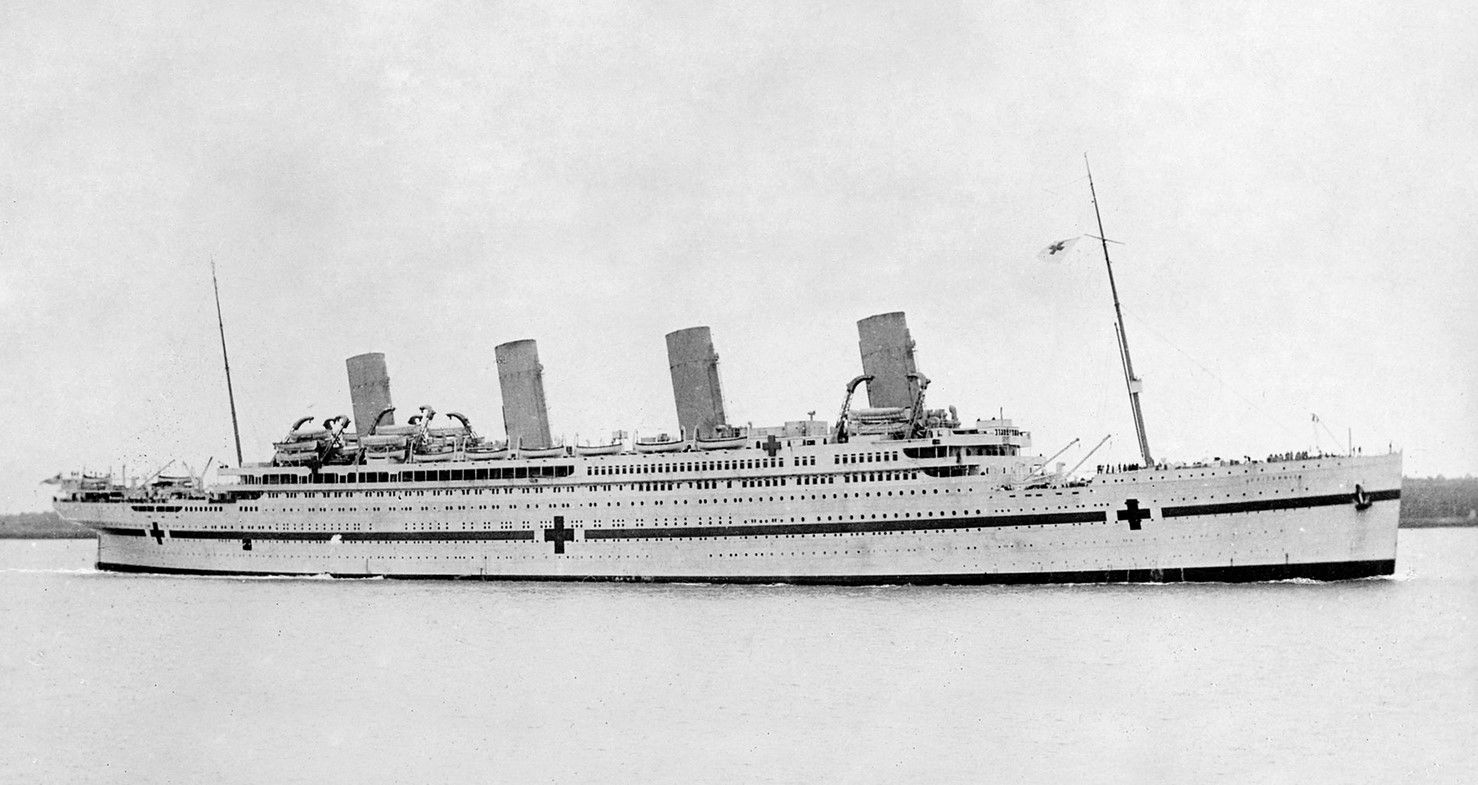
July 1917
On 10 July after being relieved by 2/12th Battalion London Regiment, the 5th Manchester's moved seventeen miles to billets at Henham Camp South at Aichet Le Petit, to the north west of the strategic town of Bapaume.
After so far being defensive troops holding the line, 127th Brigade now embarked upon a program of offensive warfare training. First starting off with low level tactics, then building up to company, battalion and finally a brigade strength exercise. On 13 August Lieutenant Colonel Darlington took over temporary command of the brigade, the command of the battalion being passed to Major A. L Bryham.
Flanders
The battalion war diary states that at exactly 1411 hrs on 23 August, 127th Brigade left Aveluy railway station near La-Boiselle, just north of Albert and travelled north 90 miles across the border into Belgium, arriving at Hop Outre rail head sidings in Poperinghe at 0400 hrs the next morning. They then marched to billets at Clyde Camp to the west of the town for training. They were now under the command of 19th Corps of the 5th Army, commanded by General Herbert Gough.
Throughout the war Poperinghe, or 'Pops' as the British soldiers called it was used by the British Army as a gateway to the battlefields of the northern Ypres Salient. It was an important rail centre behind the front line and was used as Divisional Headquarters, for the distribution of supplies, for billeting troops, for casualty clearing stations and for troops at rest from duty in the forward trench areas.
Hundreds of thousands of troops passed through this small town at some time or other and there was generally at least one division billeted in the town. The population before the war was about 12,000, but in 1917 there were as many as 250,000 soldiers billeted in the countryside around it.
A week later on the 31st the battalion marched to the east of Poperinghe to St. Lawrence Camp for a further weeks training in readiness for joining the war in Flanders.
On the evening of 7 September the Manchester’s arrived in Ypres by train. The area of the railway station was referred to by the troops as the 'Asylum', as a large building adjacent to the station was once a women's asylum. It was used by the military as a billeting area and assembly point prior to troop movements by train.
They marched through the ruined town up to the Menin Gate (the famous arched memorial wasn't completed until 1927), through the ramparts of the old town fortifications that straddled the Kasteelgracht waterway and on into the Ypres Salient. There the Manchester's joined the 3rd Battle of Ypres, more commonly known as the Battle of Passchendaele.
The terrible terrain conditions in the Ypres salient, more than any other place, with it's high water table and high rainfall, meant that trenches were largely impractical. Coupled with the need for protection from the heavy artillery bombardments from both sides, which churned the ground into a sea of mud, pillboxes and dug outs were the only practical solution.
The need arose to protect troops within deeper and deeper shelters close to the Allied front line. The tunnelling companies of the Royal Engineers supported by thousands of infantry men acting as labourers, constructed hundreds of dug outs. What started out as simple blast shelters developed over time in to large dug outs, some accommodating many hundreds of men. They consisted of subterranean hospitals, mess rooms, chapels, kitchens, workshops, as well as sleeping quarters where exhausted soldiers could rest.
The level of these World War I underground activities can be gauged by the fact that by March 1918, more people lived beneath the surface in the Ypres area than reside above ground in the town today.
Four miles away at Frezenberg the battalion relieved 1/5th Battalion Lancashire Fusiliers and two companies of the 6th Manchester’s on the front line. The positions straddled the main Ypres to Zonnebeke road. Facing them was a line of German pillboxes named Beck House Farm, Borry Farm, Vampir, and Potsdam, sited to provide mutually supporting crossfire. Immediately behind Beck House and Borry Farms was the heavily protected German strong point shown on trench maps as the Bremen Redoubt.
'D' Company occupied the right sector of the front line with their left flank on the Ypres road and their right flank hard up against the Ypres to Roulers railway line, facing the Potsdam pillbox. 'B' Company was in the left sector, their right flank on the road and their left flank at Low Farm which faced Borry Farm pillbox. 'A' and 'C' Companies were in reserve at Bill Cottage, with Battalion HQ at nearby Wilde Wood. The front line at this time was just three and three quarters of a mile from the strategically important ridge on which stood the village of Passchendaele.
On the evening of the 8th verbal orders were received that the battalion would be relieved on the night of the 9th/10th in in order to go back and practice for an assault on fortified Borry Farm. The concrete emplacement on the site of the ruined farmhouse had resisted attacks for several weeks.
On the 9th British heavy artillery engaged Borry Farm and Beck House Farm in preparation for the attack. The Germans responded by shelling the British front line, in particularly the left flank company positions that faced Borry Farm. The war diary notes that they also received friendly fire with shells from their own heavy guns falling short onto the Manchester's positions, wryly commenting that 'artillery observation seems to have been poor'.
At mid-day a German aeroplane dropped bombs on the transport lines injuring thirteen soldiers. At 2100 hours that evening the assembly trench was taped out on the left front line in readiness for the attack.
At 0305 hours on the 10th the battalion was relieved by 7th Manchester's, the companies marched independently to the Asylum in Ypres and from there were transported by motor lorries to a tented camp on the southern outskirts of Vlamertinghe, where for the next two days they trained for the attack on Borry farm.
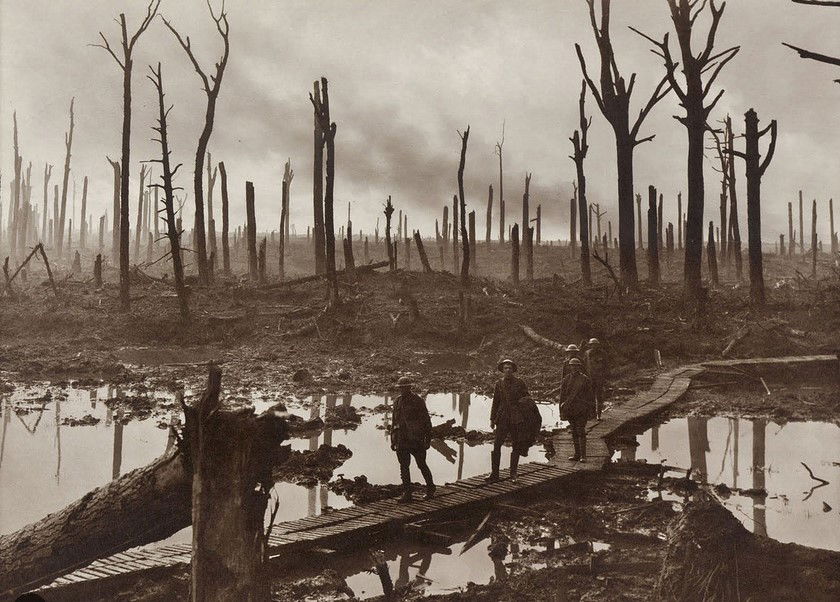 The devastated Passchendaele battlefield
The devastated Passchendaele battlefield
On the morning of the 12th the battalion once again practiced for the attack but fate intervened. At 1300 hours word came through that the assault on Borry Farm had been cancelled due to the division on the Manchester’s left having failed to take Hill 35, half a mile to the north. This would have left the Manchester’s vulnerable to enfilade fire from machine guns. The Germans had also spotted the Manchester’s jumping off trenches for the attack and shelled them heavily. It would no doubt have been a very costly affair with many casualties had the attack gone ahead as planned.
At 0030 hours the next morning the battalion returned to the trenches to relieve the 7th Manchester's, this time with 'B' and 'D' Companies in the front line and 'A' and 'C' Companies in reserve. They stayed in position on the front line for the next two days and during this time the Frezenberg ridge was heavily shelled with explosive and gas shells.
On the evening of the 14th, 2nd Lieutenant Fox led a three hour patrol and on return reported that the enemy advanced posts had been withdrawn 100 to 150 yards. At 0130 hours the next morning 1/7th Battalion Lancashire Fusiliers relieved the battalion who then marched to the Asylum in Ypres and entrained for Toronto Camp, located about five miles west of Ypres on the Busseboom to Vlamertinghe road.
On the 17th the sector was taken over by the South African Brigade and 1/7th Lancashire Fusiliers handed over to 4th Infantry Regiment (The South African Scottish). 'C' Company of the 4th Regiment with 'D' Company in support were facing Borrry Farm manned by the German 77th Infantry Regiment from the 2nd Guards Reserve Division.
At 1540 hours on 20 September 9th Division artillery unleashed a massive bombardment on Beck Farm and Borry Farm. The South African troops speedily exited their trenches before the German counter fire engulfed their trenches.
The German defenders of Borry Farm were so overwhelmed by the speed and ferocity of the assault that it took the South African troops just thirty minutes to capture the pillbox. The neighbouring Beck House Farm was also successfully over run. Of the 532 officers and men who went over the top that morning 252 were recorded as being killed, wounded or were missing.
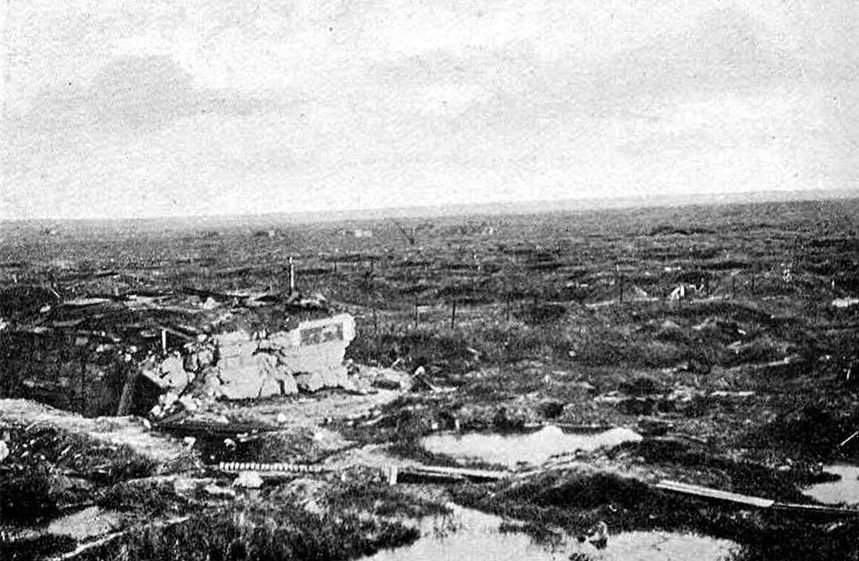 The devastation around Borry Farm pillbox after it was over run on by the South African Brigade on 20 September 1917
The devastation around Borry Farm pillbox after it was over run on by the South African Brigade on 20 September 1917
During their time on the front line at Frezenberg between 7th and 15th September the 5th Manchester's suffered three killed in action and 54 wounded from shell fire, snipers, gas, and attack from aircraft. Also 22 sick cases had been transferred to hospital.
At Toronto Camp a work party of 300 men under the command of Lieutenant Blair spent the night of the 15th/16th burying telephone cables in the eastern suburbs of Poperinghe for the 5th Corps Signals Officer. On the 17th another working party of 120 men were employed burying cables to the east of Ypres, and early the next morning a party of 63 men worked as a carrying party for the Commander Royal Engineers 6th Division.
The Manchester's time in the Ypres Salient was destined to be short, two days later 127th Brigade was on the move again, they marched west to Clyde Camp, then the next day they marched via Watou and over the border into France to Winnizeele. On the 22nd they were bussed via Burgues and Dunkerque to Canada Camp at Coxyde in Belgium.
Here the battalion received orders that they would relieve 2nd Battalion Manchester Regiment of the 97th Brigade, in the right sub sector of the brigade front, located on the coast at Nieuwpoort Bains between Dunkerque and Ostend. These orders were cancelled the next day and they were informed they would instead be relieving their sister battalion from Wigan, the 2/5th Manchester's of 199th Brigade in the left sub sector of the front. It was the only time the two battalions were to meet up during the war.
The relief was complete by midnight of the 24th, ‘A’ Company was detached from the battalion and detailed to work under the 2nd Australian Tunnelling Company. The remainder of the battalion occupied the front line positions, ‘D’ Company on the left, ‘C’ Company the right and ‘B’ Company in support.
The troops were employed repairing trenches, manning listening posts and sending out reconnaissance patrols. As well as high explosive shells they were also on the receiving end of gas shells fired from trench mortars. The war diary records that fifty gas shells exploded in the area on 29 September.
Poison Gas as a Weapon
Invented by a German chemist, Professor Fritz Haber, chlorine gas was to become a new and terrifying weapon on the battlefield, psychologically as well as physically. As Director of the Kaiser Wilhelm Institute for Chemistry in Berlin, Haber personally oversaw it’s research, development and experiments as a weapon of war.
The first gas attack occurred on 22 April 1915 in the Ypres Salient in Belgium. As soon as the winds shifted in Germany’s favour specially trained troops crept forward in the trenches and turned on the valves of more than 5,700 canisters of chlorine gas. A green cloud fifty feet high and four miles long drifted towards the French lines.
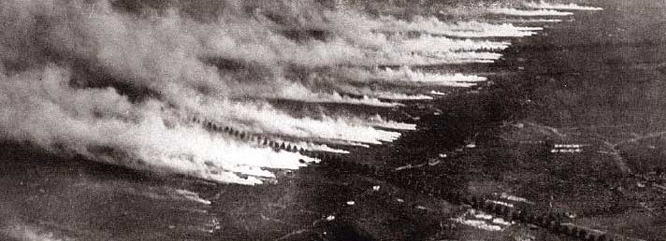 Poisonous gas clouds drifting over the front line trenches
Poisonous gas clouds drifting over the front line trenches
It is estimated there were over 10,000 casualties amongst the French and Algerian troops from the attack and they had no option but to abandon their positions and fall back. The German High Command had doubts that the attack would be successful and didn’t have enough troops in place to occupy the enemy’s trenches, therefore the plan failed tactically and little ground was gained. After the success of his experiment Haber was feted by the military and he was granted a commission with the rank of Hauptmann (Captain) by the Kaiser.
The introduction of gas onto the battlefield led to all the protagonists developing their own gas warfare programs. Soon more deadlier gases were being used such as Phosgene, which was eighteen times more powerful than Chlorine, and then Mustard Gas which didn’t just attack the lungs of the victims but burnt and blistered the skin. It is estimated that over 100,000 troops on all sided were killed by poisonous gas, and hundreds of thousands incapacitated with lifelong disabilities.
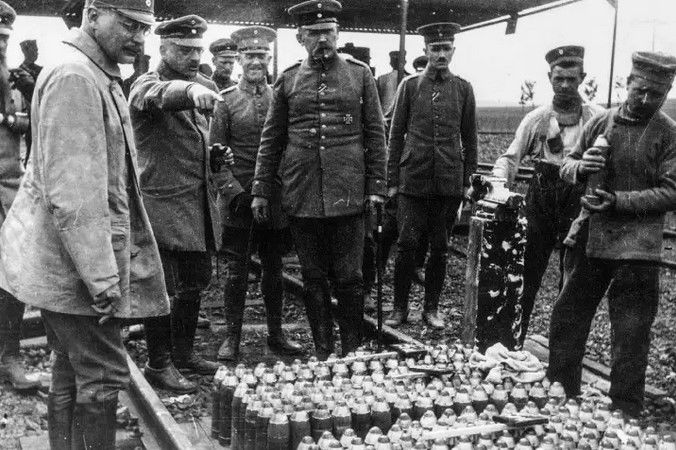 Hauptmann Fritz Haber (2nd left) overseeing deployment of gas shells
Hauptmann Fritz Haber (2nd left) overseeing deployment of gas shells
Haber’s development was to have unforeseen and tragic consequences. Ten days after the gas attack at Ypres. Haber’s wife Clara committed suicide by shooting herself in the chest using his service revolver. A renowned chemist herself, she had been the first woman to be awarded a doctorate in Germany. She was a women’s rights activist and a pacifist and it is thought this was the reason she took her own life.
Although being condemned as a war criminal by the wider scientific community Haber won the Nobel Prize in Chemistry in 1919 for pre-war research. He married for a second time to Charlotte Nathan in October 1917 and they had two children, a boy and a girl. The marriage lasted ten years, ending in divorce in 1927.
When the Nazis came to power in the 1930’s Jews like Haber were shunned and persecuted. In 1933 he was forced into exile, and with the help of British scientists he came to Cambridge. Whilst in England he accepted the role of Director of the Sieff Research Institute in Palestine. Although suffering increasingly bad health Haber left for the Middle East, but died of heart failure mid journey in Basle Switzerland on 29 January 1934, aged 65.
Haber’s legacy continued to haunt him, in his early career some chemists under his watch were working on an insecticide called Zyklon. Just before World War Two a company tinkered with the formula and produced a second generation of the gas. This became known as Zyklon B and Nazi concentration camps used it to gas millions of Jews, including Haber’s own relatives. After the war Fritz and Clara’s son Hermann emigrated to America, only to commit suicide in New York in 1946, aged 44. His eldest daughter Claire, also a chemist committed suicide in 1949 after her research into an antidote for chlorine gas poisoning was set aside in favour of the atomic bomb.
October 1917
On 7th October 1917 the battalion, minus the Lewis machine gun sections from ‘A’ Company who were on anti-aircraft duties at Ave Capelle and at St. Idesbalde railway station, marched from the front line at Nieuwpoort Bains to Canada Camp at Coxyde. Here they underwent training and also provided work details for the Royal Engineers. The camp, which was approximately six miles from the front line was considered relatively safe but within range of German heavy artillery and was occasionally shelled.
Three days later on the 10th a salvo of shells caused eight casualties, three other ranks were killed and three others were wounded along with two officers, Captain W. G. E Johnson and 2nd Lieutenant J. B Wood. Captain Johnson who had just returned from leave in England a few days previously, was transferred to No. 36 Casualty Clearing Station at Zuydcoote, just over the French border near Dunkirk. He died there of his wounds on the 13th Oct 1917, aged 24. He is buried in Grave No. I.F.19 in Zuydcoote Military Cemetery along with 326 other Commonwealth servicemen.
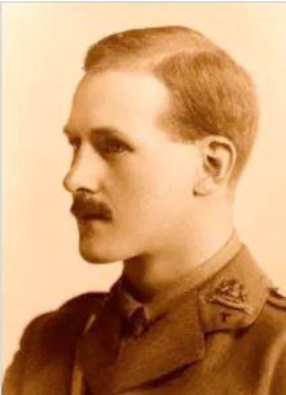 Capt William Godfrey Earlam Johnson. Died of wounds 13 October 1917
Capt William Godfrey Earlam Johnson. Died of wounds 13 October 1917
Captain William Godfrey Earlam Johnson
William was from a prominent family in the Bickershaw and Abram areas, his father Alfred was managing director of the Abram Coal Co. Ltd and their home was Bickershaw Hall on Bickershaw Lane. William had four brothers and a sister. The youngest James was too young to serve but the four older brothers all gained commissions in the army.
Two of William's brothers had already been killed in action; the eldest, Henry was killed by shellfire on 4 June 1916 whilst serving with 2nd Battalion Kings Royal Rifle Corps. Younger brother Pieter, a pilot serving with No. 4 Squadron, Royal Flying Corps died on 28 January 1917 when his aircraft was hit and brought down by artillery fire over enemy lines. The bodies of Pieter and his observer were never found. Their names are commemorated on the Arras Memorial in France along with 990 other Commonwealth airmen who have no known grave.
William's other brother Alfred who also gained a commission in the 5th Manchester's, suffered a gunshot wound to his chest on 4 June 1915 at the Third Battle of Krithia In Gallipoli. He was medically discharged from the army and took no further part in the war. He was however to be recommissioned in WW2, initially becoming the recruiting officer in Wigan before transferring to the Border Regiment in Carlisle.
Serving alongside William when he was killed was his cousin, Lieutenant Henry Johnson of 'B' Company who had joined the battalion in Egypt in April 1915.
On 22 October 5th Battalion relieved 1/7th Battalion Lancashire Fusiliers on the extreme left flank of the line, on the coast at Lombartzyde just to the north of Nieuwpoort. The section of front line allocated to the battalion was squeezed between the sea and large basin of water off the Yser Canal.
The area was 'polder', low lying land reclaimed from the sea and criss crossed with canals and dykes. It wasn’t a continuous trench line but a series of outposts, each manned with a Non Commissioned Officer, six men and a Lewis machine gunner. The German front line marked as ‘Lorry Trench’ on trench maps was just 100 yards away.
On the evening of 2 November just two weeks after the death of his cousin at Coxyde, Lieutenant Henry Johnson was part of a patrol that left the support trench and passed through No. 10 Post to reconnoitre the dyke in no-man's-land in front of the Post. He was accompanied by 2nd Lt D. Mather, Sergeant Dempsey and Private Webb from his own Company and Captain W. Sivewright and a sergeant, both from the 7th Manchester's.
The battalion war diary describes their fate. About 30 yards out they were attacked with bombs (hand grenades) by an enemy covering party. The Manchester soldiers scattered, Sgt Dempsey and Pte Webb who were both wounded managed to get back to No. 10 Post along with the Sergeant from 7th Battalion. A short time later a wounded 2nd Lieutenant Mather reached the post but was killed on the parapet as he entered the trenches. A patrol was sent out later but found no trace of Henry Johnson and Captain Sivewright.
As no letters arrived home and no news of their capture filtered through from the Red Cross the pair were officially reported as missing in action presumed dead. It was to be over a year later, after the war had ended that their bodies were eventually found by a battlefield clearance team and buried in Ostend. Lieutenant Henry Johnson, 5th Battalion Manchester Regt aged 23 and Capt William John Sivewright, 7th Battalion Manchester Regt, aged 22 now lay side by side in graves B4 and B5 in Oostende New Communal Cemetery.
Lieutenant Henry Norman Johnson
Henry was born in Bristol in 1894. By the time of the 1901 census his Wigan born father Robert had relocated his family back to his native Lancashire, where he become headmaster of Rivington Grammar School. The 1911 census finds young Henry at Abbey House Private Boarding School at St. Bees in Cumberland. In 1914 he gained a Commission into the 5th Manchester's where joined his cousins William and Alfred.
Henry, Pieter and William Johnson, along with their cousin Henry are commemorated on the War Memorial cross outside St. James & St. Elizabeth church on Bickershaw Lane, Bickershaw. A lasting tribute to the church that their grandfather James, the benefactor of Bickershaw had built in 1905.
Return to France
On 5 November 1917 the Manchester’s were relieved by the 1/7th Lancashire Fusiliers and marched nine miles along the coast and into billets at De Panne. On 16 November 42nd Division was on its travels again, they said goodbye to Belgium and marched over the border into France towards Dunkirk. 42nd Division was to join 4th Corps of the Third Army commanded by General Sir Julian Byng.
Over the next five days the battalion marched 55 miles to billets at Molinghem, to the north west of Bethune. On the 27th, after a week’s rest they relieved the 10th Cheshire's in the right sub-sector of the line near Givenchy-les-la-Bassee. They were relieved by the 7th Manchester's on the 3 December and reciprocated by relieving them on the 9th. Here they started work on the maintenance of trenches, wiring of the front line and making dug outs and accommodation under the supervision of the Royal Engineers.
In the early hours of 12 December a reconnaissance patrol consisting of a Non Commissioned Officer and two men left their own lines to gain intelligence. They moved east to the wire in front of the German front line trench line designated Mackensen Trench. They then turned south for about 100 yards where they located a German post. They reported that the post was strongly held and protected by wire to the front and rear.
At 0355 hours of the 13th another patrol set out to reconnoiter the post found by the previous patrol. It reported that it was actually a salient dug out in front of Mackensen Trench and that part of the line was strongly defended.
On the night of the 13th/14th another patrol consisting of an officer and seven other ranks from 'A' Company left the front line near Berkeley Street and proceeded out to the German line, south of the previous two patrol encounters. They came across an enemy post but it was unoccupied.
Moving seventy or eighty yards in a north west direction they came across an enemy trench. They got to within a few feet from a sentry before he saw them, one of the patrol motioned him to raise his hands but instead he gave a loud shout. Immediately about twenty enemy appeared coming along the trench.
The patrol commander fired and the enemy replied with stick bombs. At this point the patrol only consisted of four men as the remainder had been left as a covering party. The patrol withdrew to the covering party followed by the Germans, but they quickly stopped and returned to their own trench. The Germans then responded with rifle and machine gun fire and sent up flares into no-man's-land.
On reaching their own lines the Manchester's discovered that one man had been wounded and one man, Private J. Armstrong was officially posted as missing in action after the patrol action.
A search of the records held by the International Committee of the Red Cross in Geneva, Switzerland show that he had been taken prisoner by the Germans.
Worldwide, eight million soldiers fighting on the front and two million civilians, mainly those living abroad in enemy countries or areas under enemy occupation, were taken prisoner and interned in camps for several years. On the 21st August 1914, the International Committee of the Red Cross had established the International Prisoners of War Agency in Geneva, to which the warring nations submitted, more or less regularly, lists of prisoners. Until 1917 the USA acted as ‘protecting power’ for British interests. When it entered the war the Dutch, who remained neutral throughout the war took over.
The Agency received 400,000 pages of documents: lists of prisoners’ names and records of capture, of transfers between camps and of deaths in detention. For each name listed, the agency made out an index card. The cards were then classified by nationality and the detainee’s military or civilian status and filed alphabetically in twenty nine different card indexes.
These indexes also contain inquiry cards, drawn up on the basis of data taken from the thousands of written requests for information submitted daily by relatives of the missing, which the agency indexed before destroying the correspondence.
The agency’s archives hold five million index cards, containing data on over two million prisoners, primarily from the Western, Romanian and Serbian Fronts. Indexes relating to the vast Russian Front are kept in the archives of the Danish Red Cross in Copenhagen, as Denmark was a neutral State during the First World War.
Alongside its efforts to restore contact between relatives separated by war, the organization also sent delegates on missions to inspect 524 prisoner of war and internment camps in Europe, the French colonies in North Africa, India, and even as far afield as Japan. They interviewed prisoners and camp authorities, and inspected detention conditions in the camps: hygiene, food, working conditions, and whether prisoners were able to write to their families.
John Armstrong was first sent to Limburg Prisoner of War Camp, north west of Frankfurt in Germany, arriving on 21 December 1917. Limburg was a registration camp where prisoners were processed before being sent to a permanent camp. He was then moved to Ingolstadt, to the north of Munich in Bavaria, arriving on 7 February 1918. A week later he was admitted to a military hospital in the town, no further details are known other than he was treated for a complaint in relation to his lungs.
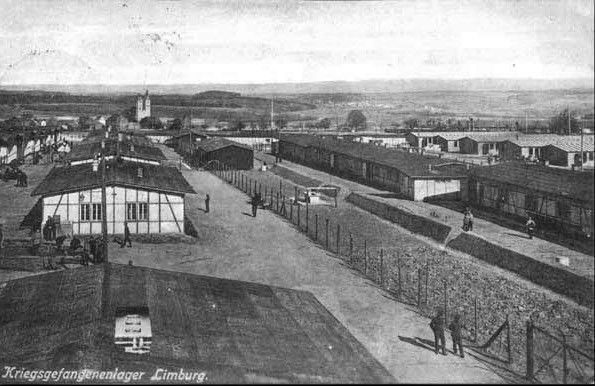 Limburg Prisoner of War Camp, Germany.Ingolstadt was known as 'the Colditz of WW1' as the fortress in the town was used as a 'Reprisal Camp' to house persistent officer escapers, high ranking officers, and VIP's etc. Charles De Gaulle the future President of France was detained there.
Limburg Prisoner of War Camp, Germany.Ingolstadt was known as 'the Colditz of WW1' as the fortress in the town was used as a 'Reprisal Camp' to house persistent officer escapers, high ranking officers, and VIP's etc. Charles De Gaulle the future President of France was detained there.
200358 Private John Armstrong
John was born in Seed Street, Scholes, Wigan, one of ten children to John Armstrong and his wife Sarah Ann (nee Strong). He married Ellen Gerrard at St. George CE church on 20 December 1913. On 7 August 1914 he enlisted into the 5th Manchester's and was one of the originals that landed at Gallipoli on 6 May 1915.
On his return from captivity he was medically discharged from the army on 13 April 1919 as no longer being physically fit for military service. He was issued the Silver War Badge to show that he had been honourably discharged due to wounds or sickness suffered during the war.
John was awarded the 1914-1915 Star, British War Medal and Victory Medal. His records show that these were returned to the issuing office because of a problem with their delivery. This was a common occurrence, it’s possible he had moved since being discharged and never notified anyone or he had deliberately returned the medals as 'unwanted'.
(Many ex soldiers returned their medals as a protest against post war conditions or were so sickened or traumatised by what they had seen and endured, they just wanted to forget. It is uncertain what happened to John's medals and if he might have claimed them at a later date. If they remained unclaimed for ten years they would have been returned to the Deputy Director of Ordnance Stores (Medal Branch), Royal Dockyard, Portsmouth to be destroyed).
After the war John settled down with his wife and two daughters at 2 Swan Terrace in Scholes, returning to his old job as a miner.
John died in Wigan Infirmary on January 1971 aged 77. At the time he was living at 370 Warrington Road, Spring View, Ince, and a near neighbour of my grandfather Frank who he served with. He was buried alongside his wife Ellen in Gidlow Cemetery on 8 January 1971, plot 21, grave 333 RC.
The Last year of the War
After a spell in Brigade Reserve at Gorre Chateau the battalion moved into billets at Hingette on 22 December 1917. Here in relative safety away from the front line they spent what was to be the last Christmas of the war.
On 2 January 1918 Brigade Order No. 58 was issued detailing the battalions move back to brigade support the following day. The advance party consisting of one officer per company, one Non Commissioned Officer per platoon, the Regimental Sergeant Major and three signallers proceeded to the front line.
The following day the battalion marched via Gorre to Le Preol and at 2130 hrs the they relieved the 10th Manchester's in brigade support on the right sector of the divisional front at Cuincy, to the west of Bethune on the banks of the Canal d’ Aire. The war diary notes that Lt. Colonel Darlington had been admitted to a field ambulance sick, Major T. Blatherwick MC from the 6th Manchester's took over command.
At Cuincy, due to the close proximity of the German positions on the other side of the canal they had to endure constant attack from mortar fire. On 6 January the Manchester's trench line received sustained fire from medium trench mortars. 2nd Lieutenant Toft and six other ranks became casualties when a shell from a trench mortar blocked both entrances to their dugout. They had to be dug out under fire by their comrades before they became asphyxiated.
Second Lieutenant Walter Toft was born in Monton, a suburb of Eccles near Manchester in 1894. The 1911 census finds him living at 16 Pine Grove, Monton with his parents and two younger brothers. Surprisingly he first enlisted into 1/4th Battalion Royal Scots, a Territorial Force unit in Edinburgh. After the war the 1921 census shows Walter's occupation as chartered accountant so it is possible that he was at university in Edinburgh when war was declared and he joined his local Scottish regiment.
The 4th Battalion Royal Scots embarked at Liverpool on 22 May 1915 on board HMT Empress of Britain bound for Alexandria in Egypt, then later sailed for Lemnos in Greece. Walter was among two companies that disembarked on 'W' Beach on the Gallipoli Peninsula on 12 June.
On 28 June 1915 the 4th Royal Scots led a brigade assault on Gully Ravine taking all its objectives and repulsing two immediate and major counter-attacks, but suffered 345 casualties in the process. However, the attack, across the whole front, failed in its main objective of securing Achi Baba.
The story of the 4th Royal Scots in Gallipoli is very similar to that of the 5th Manchester's. Their strength was slowly depleted with heavy casualties from enemy action, disease and sickness. Eventually the under strength companies had to make up composite battalions undermining their military effectiveness.
After withdrawal from Gallipoli, Walter and the 4th Scots found themselves in Cairo alongside the Manchester's as part of the Egypt Defence Force. At some point Walter transferred to the Army Service Corps, then on 24 January 1917 he gained a commission and was transferred back to the infantry with the 5th Manchester's, his local regiment who were still in Egypt.
Mortars
The Germans had started production of mortars (minenwerfers - literally translated as mine thrower) in 1908-09. By the start of the war they had three sizes of mortar available. Aside from the heavy 25 cm type (heavy mortar), they had a medium 17 cm and a light 7.58 cm mortar. They could fire a variety of ammunition including explosive, incendiary, smoke and gas shells. Eventually a very heavy 38 cm minenwerfer was produced.
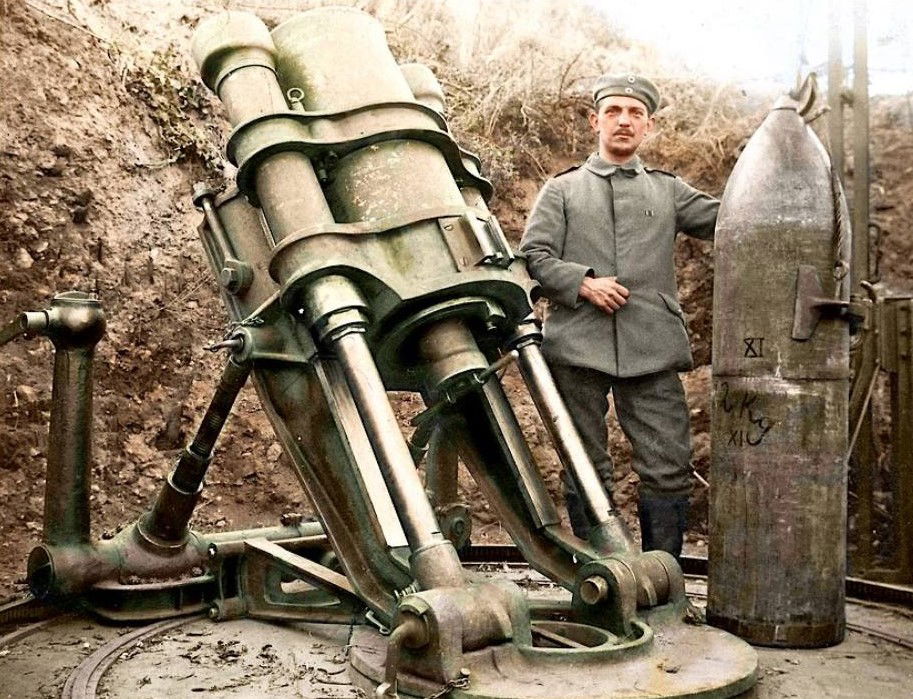 German heavy 38 cm Minenwerfen (Trench Mortar)
German heavy 38 cm Minenwerfen (Trench Mortar)
At the start of the war the British and French had no mortars at all but in 1915 the very efficient three inch portable Stokes Mortar had been produced, designed to be operated by a three man crew. Soon medium and heavy mortars were introduced. By December 1915, high command ordered that light mortar units would be manned by the infantry and the medium/heavy units by the Royal Field Artillery.
In March 1916, the medium trench mortar batteries formally came under the command of Divisional artillery, while the light Stokes batteries left battalion-level control and came under brigade command. At this time, each division was given a Divisional Trench Mortar officer, the batteries were numbered, and a badge was introduced to identify mortar personnel.
Soldiers had a deep respect for the mortar and soon learned to listen for the distinctive plop as the shell left the mortar tube, before heading for cover.
Calm before the Storm
Apart from a couple of spells in the left sub sector of the Brigade front the majority of the time over the early part of 1918 was spent in reserve. After being relieved by the 8th Manchester's on 29 January the battalion marched to Ferme du Roi in Divisional reserve, here they remained at one and quarter hours state of readiness. They spent their time training and providing working parties, interspersed with recreational training, church parades, medical inspections and baths.
On 12 February the battalion marched to billets in Lapugnoy, here they carried out musketry training, with specialist training for the snipers, scouts, signallers and stretcher bearers. On the 16th the battalion received a large contingent of replacements consisting of sixteen officers and 374 other ranks from the 9th Manchester's. The war diary makes note that on 18 February 1918 the Commanding Officer Lt. Colonel Darlington was ordered a Medical Board and taken off strength of the battalion, his replacement was the newly promoted Lieutenant Colonel T. Blatherwick MC.
The battalion remained at Lapugnoy until 4 March, before marching to billets at La Vallee near Busnettes, ten miles to the north west of Bethune, as General Headquarters Reserve. Here they continued training at company level. Suddenly at 1000 hours on 22 March they were ordered to be at thirty minutes notice to move.
German Spring Offensive
In the aftermath of the October Revolution of 1917 in Russia and the ensuing civil war, the new Bolshevik Government, led by Vladimir Lenin, negotiated a cease fire with Germany. Subsequently a peace treaty was signed on 3 March 1918 at Brest-Litovsk, bringing to an end Russia’s involvement in World War One.
This freed up 50 German divisions of approximately 900,000 men from the Eastern Front, these were immediately transferred to the west giving the Germans a numerical advantage over the Allies. On 21 March the German Army then launched a major offensive on the Western Front, known to the Allies as the ‘Spring Offensive’ and to the Germans as the ‘Ludendorff Offensive’. It’s aim was to drive a wedge between the British and the French armies, capture the Channel ports and deliver a knockout blow before the American Army could fully deploy it’s huge military resources and make an impact in the Allies favour.
The initial attack named ‘Operation Michael’ started with a creeping barrage, an artillery tactic, known by the Germans as the ‘fire waltz’. Over a 43 mile front 4,000 field guns, 2,600 heavy guns and 3,500 mortars bombarded the Allied lines with a mixture of shells, including high explosive, tear gas, smoke and poison gas. It took the Allies by complete surprise, pushing them back all along the Front, with the Germans quickly retaking the ground they had lost in 1916-1917.
At noon on 23 March the 5th Manchester's were bused 35 miles south, from Busnettes to Douchy-les-Ayettes, just to the north of Bapaume. From here they marched three miles to Courcelles-le-Comte Aerodrome in support of 40th Division, arriving at 1145 hours.
The next day the battalion marched from Courcelles-le-Comte, to relieve the 14th East Surreys, some four miles to the east in the Mory area, but in transit they were informed that the Germans had broken through at Behagnies, a couple of miles to the south east. They were ordered to form a defensive line and take up defensive positions, ready for the inevitable German onslaught. At 0200 hours the following morning the battalion successfully conducted a silent night withdrawal without interference from the enemy. The war diary notes that at the time the strength of the battalion was 563 all ranks.
42nd Division was facing the German 17th Army, mainly Bavarian troops formed in late 1917 and early 1918 with forces withdrawn from the Eastern Front. Over the next few days the 5th Manchester’s conducted a fighting withdrawal westwards, through Aichet-Le-Grand, Ablainzeville and Bucqouy to Gommercourt Park, a distance of about 10 miles, all the time repulsing constant attacks under enemy artillery bombardment. The war diary notes that on the 27th the battalion suffered 75 casualties killed or wounded.
By 29 March the battalion strength was down to 368 all ranks, having suffered 195 casualties. Gommercourt Park was shelled consistently so the battalion was ordered to move to a new location a couple of miles to the west, in support of the 4th Australian Brigade. Each night they sent out two companies to help dig trenches and link up with the New Zealand Division Reserve Line.
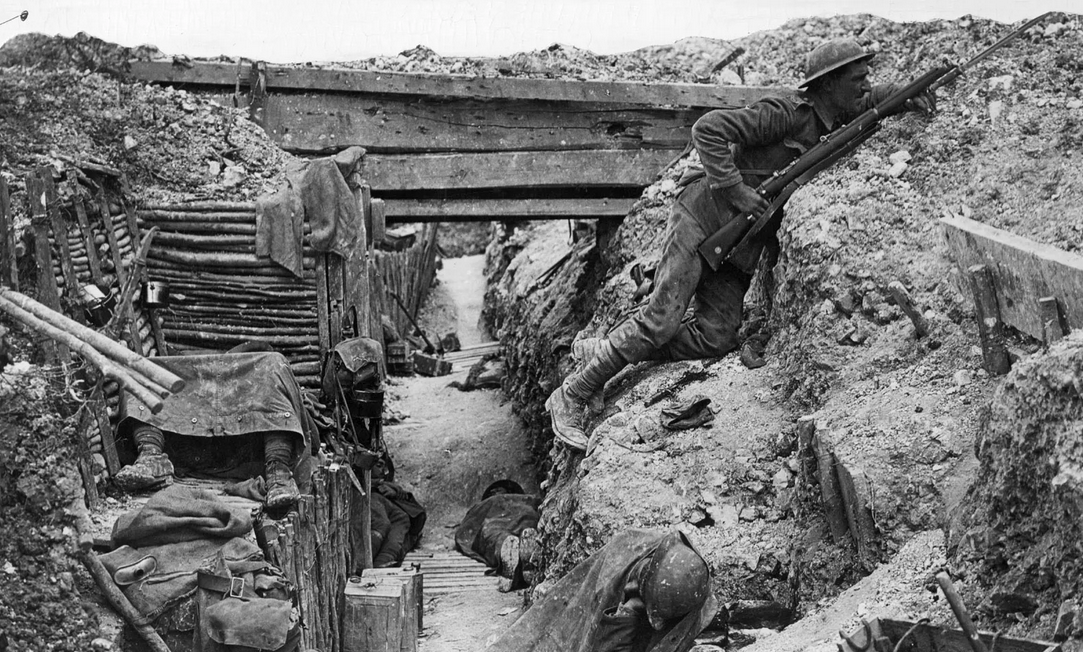 Sentry keeping watch whilst his comrades sleep.
Sentry keeping watch whilst his comrades sleep.
On 1 April the battalion relieved the 18th Battalion Kings Royal Rifle Corps in Divisional Reserve and on the 3rd moved into trenches on the front line to the west of Essarts Les Bucquoy. Two days later the area was subjected to heavy shelling with large amounts of mustard and phosgene shells. There were ten casualties from gassing and thirty other ranks were wounded. The battalion came out of the trenches the 6th of April, and in what the War Diary considered a quiet day, there had only been thirteen other ranks wounded.
The next day 42nd Division was notified that it was being taken out of the line and into Corps Reserve. It was to be replaced by the 62nd Division, the 5th Manchester's being relieved by 2/4th Battalion Duke of Wellington’s Regiment. On 8 April the division marched via Quesnoy Farm, Monchy-au-Bois and Bienvilers to Souastre, from where they were transported twelve miles by motor lorries to billets in Louvencourt, to the north west of Albert.
Here the time was spent resting, replenishing kit and equipment and absorbing the much needed replacements which arrived on 9 April. Thirteen officers and 127 other ranks came from various regiments including the 2/6th Battalion Gloucestershire Regiment, 14th Battalion Hampshire Regiment, 18th Manchester Regiment, 17th Entrenching Battalion, and its sister units, the 6th and 7th Manchester’s. The next day, 48 other ranks arrived as replacements from depots in England.
After ten days in Louvencourt the battalion marched nine miles to Hebuterne to relieve 16th Battalion Royal Fusiliers on the front line in the left sub sector of the Brigade Front. Every night fighting patrols were sent out in an effort to locate machine gun nests and enemy posts. These were then attacked and bombed by the patrol in an attempt to capture a prisoner to identify the regiment facing them.
On 20 April, Sergeant Stuart M.M of 'C' Company was accidentally shot and killed by a sentry as he returned to his own lines from a 17 man strong fighting patrol led by 2nd Lieutenant Platt, he was 27 years of age. He had been awarded the Military Medal for bravery in the field three months earlier on 28 January 1918, when his name appeared in the supplement to the London Gazette.
201122 Sergeant Thomas Stuart MM, a coal miner by profession, lived at 2 Regent Street, off Little Lane in Goose Green, Wigan, with his wife Hannah (nee Hilton), who he had married at St. Thomas CE church in 1910. They had five young daughters, Ellen the eldest was eight and Fanny the youngest was only seven weeks old so it is very unlikely he got to meet her.
A month after his death on 23 May his widow received an initial payment of £5, then a widows war pension of 40 shillings and five pence a week which came into effect on 11 November, Armistice Day. This pension reduced in increments as each child reached the age of 16. Thomas is buried in Couin Military Cemetery, half way between Bapaume and Doullens in the Pas de Calais region, grave number A29.
On 24 April 1918 the battalion was relieved, ‘A’ and ‘C’ Companies by two companies from the 2nd Auckland Battalion and ‘D’ Company by the 1st Auckland Battalion from the New Zealand Brigade. ‘B’ Company was relieved by 1/5th Battalion Lancashire Fusiliers. They then went into Divisional Reserve at Rosignal Farm until the 28th before moving to the Gommercourt sector.
A look at the casualty figures is required to appreciate the scale of the fighting during March and April, the first two months of the German Spring Offensive. The battalion suffered 228 killed or wounded, and in total the British Army suffered 316,889 casualties, nearly a third of a million men.
The Allied retreat westwards ended in April, the troops once again adopting a defensive posture in the trenches. On the evening of 3 May ‘A’ Coy in conjunction with 1st Battalion Wellington Regiment of the New Zealand Brigade successfully carried out an attack to capture and consolidate trenches to the east of Hebuterne. The Manchester's suffered eight killed, eleven wounded and one suffering from shell shock in the operation.
Two days later the battalion was relieved by 2nd/4th South Lancashire Regiment, 42nd Division then moved into Army Reserve, but at disposal of Fourth Corps in case of attack. They were to remain at one hours state of readiness to move between 0900 hrs and 2100 hrs and at two hours notice between 2100 hrs 0900 hrs. 127th Brigade were billeted at Henu Wood Camp some five miles to the west. Here they spent a month out of the line training.
On 7 May a draft of 80 reinforcements arrived from their sister battalion the 2/5th Battalion from Wigan, who had been broken up and reduced to a training cadre. The Commanding Officer also reviewed a draft of 48 new replacements who had arrived from the war surplus pool at Authie, a few miles to the rear.
The Americans
In 1914 when the Great War started, America adopted a policy of strict neutrality. They wanted to stay completely out of the conflict, but found this increasingly difficult due to Germany’s policy of unrestricted submarine warfare. In May 1915, when a German U-boat sank the RMS Lusitania, 128 American citizens lost their lives.
This was a key turning point in America’s attitude to the war. This, coupled with the news that Germany had proposed an alliance with Mexico to threaten American interests, finally brought America into the war. On 6 April 1917 President Woodrow Wilson informed the American public that their country was now at war with Germany.
America was not ready for war. The country had to mobilize, and prepare its armed forces for battle. The US Army was small in size, but conscription was soon introduced to expand it. Troops started to trickle into France by June 1917 and by the Spring of 1918 had started to arrive in large numbers, providing a much-needed morale boost for the war-weary Allied soldiers. Over two million Americans participated in the war and this tipped the numerical advantage in the Allies favour.
Before they were ready for combat though the Americans had to be trained in the art of trench warfare by the Allies. The usually brash and confident Americans soon learned the hard way how much of a formidable foe the vastly experienced German army was.
The British formed demonstration platoons with experienced instructors to instruct American units. Their officers were attached to British units to get a taste of life on the front line, and eventually American units were allocated quiet sectors of the line. The first American offensive of the First World War took place on 28 May 1918 at Cantigny near Montdidier, at the southern sector of the Somme.
The 5th Manchester's war diary records that on 15 May 1918 they prepared a new camp at Henu Wood in readiness for the arrival of the US 2nd Battalion, 307th Infantry Regiment who had been attached to 127th Brigade.
June 1918
On Sunday 2 June, in conjunction with the 7th Manchester's, a Church of England Service Parade was held to commemorate the part played by the brigade during the Battle of Krithia at Gallipoli on 4 June 1915, this was followed by a march past. 5th Battalion was led by their new commanding officer Lieutenant Colonel W. F Panton, his predecessor Lieutenant Colonel Blatherwick had moved to become commanding officer of the 6th Manchester's.
Four days later the battalion came out of reserve and relieved 1st Battalion Auckland Regiment of the New Zealand Brigade in the right sub-sector of the Hebuterne sector of the 4th Corps Front. That night each company sent out four patrols but nothing of significance was reported.
The whole of the battalion front was constantly patrolled each night. There was frequent artillery duels and Hebuterne was heavily shelled with high explosive and shrapnel.
At 2300 hours on the 11th a patrol consisting of Lieutenant Wellings, Corporal Riley and six men left their own lines. Whilst in no-mans-land they were fired on by the enemy with machine guns and grenades. When all was quiet again three men were found to be missing. The remainder of the patrol started a search for them and in the process Corporal Riley was seriously wounded.
Several efforts were made to bring the injured man back but all proved abortive, he was eventually left in a shell hole pending a more favourable opportunity to bring him in.
At 2230 hours the next night a fighting patrol of 23 men led by 2nd Lieutenant Aylward went out into no-mans-land to search for the missing Corporal, but without success. The following night another patrol consisting of nine men led by Lieutenant Wellings, with a covering party of 23 men led by 2nd Lieutenant Aylward again searched for him, but to no avail.
Nineteen years old Corporal Riley has no known grave. He is commemorated on the Memorial to the Missing at Pozieres Cemetery, Somme in France, panel 65B.
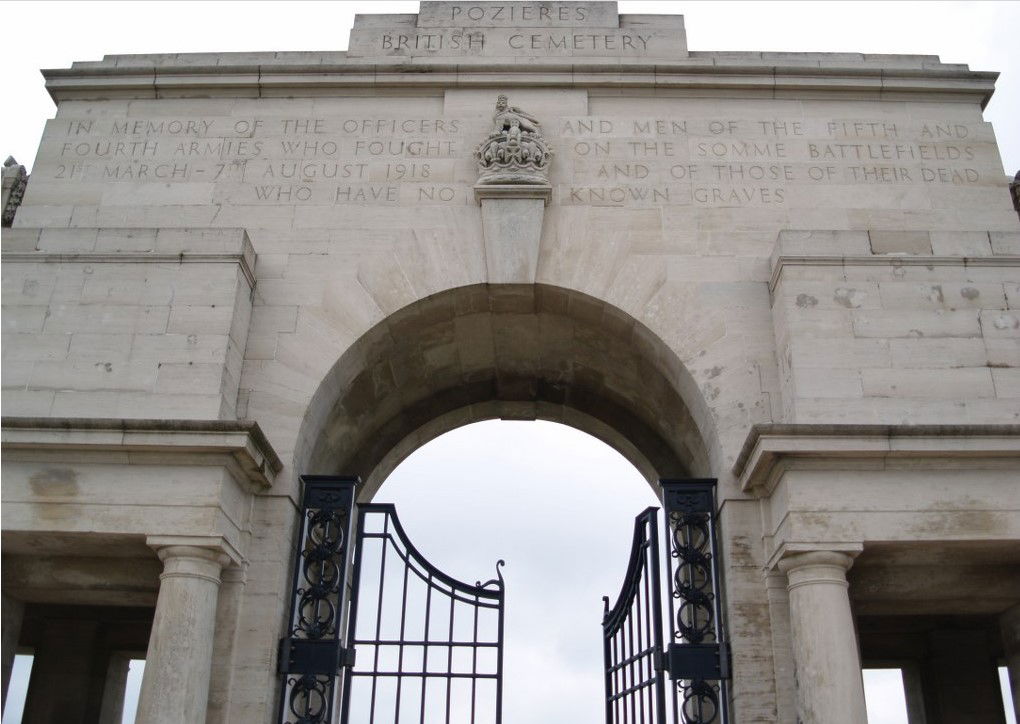 Pozieres Memorial, France
Pozieres Memorial, France
201818 Corporal Edward William Riley
Edward was born in Blackburn in 1898. The son of Thomas and Emma Riley (nee Chapman). The family moved to nearby Accrington but by the time of the 1911 census were living in Eccles near Manchester. They then returned to Accrington to live at 16 Queens Terrace. Edward enlisted at Preston in to the Loyal North Lancashire Regiment, then at some point transferred to the 5th Manchester's.
On 14 June after being relieved by 1/5th Battalion Lancashire Fusiliers the battalion moved into Divisional Reserve at Bus-les-Artois, three miles behind the front line, where they remained for a week, at fifteen minutes notice to move. Whist there they trained, provided work parties for the Royal Engineers, attended Devine Services for all ranks, held boxing matches and a battalion sports day. The companies took it in turns rotating through the Divisional Baths at Louvencourt.
On the 21st an honours and awards ceremony was held. Lieutenant J. Fox was awarded the Military Cross. Captain M. Bryham, Company Sergeant Major George Blyth, and Sergeant Charles Heyes were awarded oak leaves after being Mentioned in Dispatches on 7 April 1918.
Two days later, the battalion relieved the 10th Manchester's in the right sub sector of the brigade front at Colincamps, with two companies in the front line and two in support. Colincamps, seven miles north of the strategically important town of Albert was briefly in German hands towards the end of March 1918, when it marked the limit of the German advance, but the line was held and pushed forward by the New Zealand Division
On this tour of the line the emphasis was very much on patrolling, in the daytime allied aircraft flew over the German lines gathering intelligence. At night listening patrols were sent forward of the trenches to give early warning of enemy movements and most nights reconnaissance patrols entered no-man's-land to locate German positions. Fighting patrols would then be sent out to harass or attack the enemy positions.
On 25 June the war diary noted there was an epidemic of pyrexia (fever), which affected the sufferers for about four days. This accounted for the large amount of sickness being reported, in June 227 personnel were admitted to hospital sick.
On 2 July the companies readjusted their positions with 'C' Company on the front line and 'A' Company in close support, 'B' Company were behind them in support and 'D' Company in battalion reserve.
That night and the following night 2nd Lieutenant Rourke and one man went out on patrol, the first night they located an enemy post but were fired on by a sniper through a loop hole in a sniper plate, they withdrew but later returned and bombed the position.
The next night he located an enemy position behind barbed wire in front of Borden Avenue trench and just fifty yards from Post No. 10. On the 8th he was back out leading a nine man fighting patrol on a daylight raid but had to return due to heavy enemy resistance.
Daylight Raid
On 9 July 1918 the battalion was tasked with a surprise daylight raid on a German trench known as Watling Street, just to north of the town of Auchonvillers. The aim of the mission was to secure a prisoner for the purpose of identification and to kill any enemy encountered. The eight man raiding party consisted of 2nd Lieutenant Frost, Sgt Bevan, Sgt Walsh, Cpl Barker and Private’s Hewitt, Webb, Britton and Parrott.
The raid commenced at 1540 hours and was to last just fifteen minutes. The following is a copy of the report that was entered into the battalion war diary.
‘REPORT: Raiding party rushed out of N side of MOUNTJOY Trench at No 6 Post across the open and entered enemy trench at approximately K34.c. 85.30. Three of the enemy were found in the trench at this point – These men were all killed by 2/Lieut FROST. Three of our men had been previously detailed to make a block in the trench.
At the time of jumping into the trench a large number of Bosche without equipment or rifles, and wearing soft caps were seen running in all directions.
Raiding party were temporarily checked by bombs thrown by a man in a high sandbagged emplacement, 2/Lieut FROST shot at and presumably killed this man. Several of the enemy came out of shelters in the trench and cleared in an E direction. These men were shot at and bombed by 2/Lieut FROST and Pte HEWITT (who were leading our party along the trench) and several were seen to fall.
Enemy continued to bomb our party and they had to leave the trench and rush back to our line across the top. Immediately after they left the trench a Machine gun opened up on them but caused no casualties. Owing to the bombing by the enemy it was impossible for party to bring back any prisoners for identification. 2/Lieut FROST got hold of one Bosche but he resisted and was therefore shot. All of the raiding party returned to our lines. 2/Lt FROST, Sgt BEVAN and Pte HEWITT were slightly wounded.
Rough estimate of casualties inflicted on the enemy and remarks. I have interviewed all the men that went over and from all accounts the raid inflicted heavy losses on the Bosche as follows:-
2/Lt C E FROST MC jumped almost on the top of three men and shot them with his revolver, Pte HEWITT following close behind. At his point a bomb splinter hit 2/Lieut FROST making several small wounds on his face and breaking his glasses. They both fell into the bottom of the trench to avoid explosion, Pte HEWITT falling on a Bosche who had apparently just come out of a shelter and was also on the floor to avoid the bomb. Pte Hewitt shot the Bosche twice with his revolver at point blank range while in the bottom of the trench.
Another bomb was thrown at 2/Lieut FROST which hit him on the shoulder. He saw the man who threw it and shot him. Immediately after several men who had apparently been sleeping in shelters in the trench came out and shouted to men in the trench, 2/Lt FROST shot two of them, pulled off on a third and found his revolver unloaded. He then threw a bomb into a shelter and reloaded his revolver and again emptied it on the Bosche. The men who followed 2/Lieut FROST claimed that he killed 8 Bosche. 2/Lieut FROST has recently been on two revolver courses and is looked upon as an expert shot.
In the meantime the other men were firing on Bosche on the left and on top as they ran away. Sgt Bevan who was lower down the trench shot a Bosche through the neck at close range. Bombs were being thrown on the raiding party from all directions and they were unable to move any further. 2/Lt FROST having two men wounded and wounded himself then withdrew over the top.
Two Lewis Guns had been firing almost continuously from our front line on Bosche as they ran back over the top to a support line. I think we can honestly estimate the casualties at 15 killed and a good many wounded besides, the raiding party having had the luck to jump in where the Bosche was thick, working unharmed and without equipment. As soon as the raiding party got back I ordered the TM's (trench mortars) and rifle grenades to be turned onto this spot with the idea of catching his stretcher bearers, and other people helping with the dead and wounded. I have also ordered them to keep harassing this post on and off during the night’.
A message was received from Major General A. Solly-Flood Commanding Office of 42nd (East Lancs) Division which read.
‘Please convey to 1/5th Manchester Regt my heartiest congratulations for their successful raid this afternoon. Please congratulate 2/Lt Frost MC and all ranks concerned in the latest exhibition of Wigan fighting spirit. A thoroughly excellent and characteristic example of 1/5th Manchester methods’.
2nd Lt Frost was awarded the Military Cross, the three NCO's and four Privates were all awarded the Military Medal for their bravery during the raid. A couple of weeks later on the night of 30/31 July a patrol of the battalion came under sustained heavy fire and the officer was killed. Corporal Melling took command and withdrew the patrol successfully, and though under very heavy fire he managed to carry the body of his officer back, a distance of 600 yards in the open.
The next day the battalion was relieved by 1/7th Lancashire Fusiliers after sixteen days in the line and moved in to reserve dugouts. That day Lieutenant W. A Brewer, attached to the battalion from the U.S Marine Corps re-joined after a spell in hospital. After rotating through the baths at Bertrancourt the companies provided working parties for the Royal Engineers.
The war diary noted that the battalion salvage for the week up to 12 July 1918 was £5.088, for this the battalion received an extra leave allotment. War salvage was a crucial and important task in an effort to recoup some of the enormous costs that Britain spent on the war, estimated at nearly 1.9 billion pounds per day, a total of 693 billion pounds per year. An enormous industrial scale salvage operation was eventually set up that included every layer of the army.
As well as battlefield clearance teams that collected weapons, small arms ammunition, bullet clips, and shell casings, anything at all that could be recycled was sent back to divisional dumps. These included helmets, boots, greatcoats, water bottles, cutlery and even empty ration tins for the recovery of solder around the seams.
Troops were required to bring back a salvaged item every time they left the trenches, small salvage dumps were everywhere and sand bags for small items were hung up in trenches and rest areas etc. Total salvage for 1918 was estimated at 197 million pounds (equivalent in purchasing power to 14.3 billion today)
On 13 July a replacement draft of 41 other ranks arrived from base. Accompanying them was the new battalion Chaplain, Reverend G. A Studdert-Kennedy. His reputation preceded him as he was famously known on the Western Front as 'Woodbine Willie'. He always carried a supply of Woodbine cigarettes with him and gave them to any soldier he met.
He was also known as the 'Saint of no-mans-land' for going onto the battlefield to help evacuate wounded soldiers, give spiritual aid to dying soldiers and to light their last cigarette. He was awarded the Military Cross for gallantry and devotion to duty after running into no-mans-land to help the wounded during the Battle of Messines Ridge in 1917.
Captain Geoffrey Anktell Studdert-Kennedy
Geoffrey was born in Leeds in 1883, his Irish born father William, was Vicar of St. Mary's, Quarry Hill in Leeds. After the war he was given charge of St. Edmund, King & Martyr in Lombard Street, London. He wrote a number of poems about his experiences, and these appeared in the books 'Rough Rhymes of a Padre (1918)'.
 Rev. G. A Studdert-Kennedy 1883-1929
Rev. G. A Studdert-Kennedy 1883-1929
He became a socialist and a pacifist, speaking out against war, and began working for the Industrial Christian Fellowship, for whom he went on speaking tours of Britain. It was on one of these tours that he was taken ill with influenza, which was complicated by exhaustion and pneumonia. Studdert-Kennedy died in 1929 in Liverpool, aged 45.
King George V sent a telegram of condolence. His funeral took place in Worcester, to which First World War veterans and poor working people flocked to pay their respects. And, touchingly, former servicemen sent a wreath with a packet of Woodbine's at its heart.
The Dean of Westminster refused burial at Westminster Abbey because he said Studdert-Kennedy was a Socialist, even though he had distrusted most politicians and had refused to join any political party.
During the night of 30/31 July a 17 man patrol led by 2nd Lieutenant Smith left Nairn Post. They were ambushed by a German patrol who opened fire from a range of twenty yards killing 2nd Lieutenant Smith instantly. After a brief firefight the Sergeant in charge withdrew bringing his officers body back with him.
2nd Lieutenant William Cecil Smith
William was born in 1891 in Reading, Berkshire, one of six children to Elijah and Emma Smith (nee Lott). He married Ann Sophia Victoria Harwood in 1916, their daughter Betty being born the following year. At the time of his death. the family home was at 3 Blenheim Road in Reading.
William enlisted as a Gunner in to the Berkshire Royal Horse Artillery in 1914, entering the theatre of war in Egypt on 25 April 1915. He gained a commission to 2nd Lieutenant on 30 January 1918, before transferring to the 5th Manchester's.
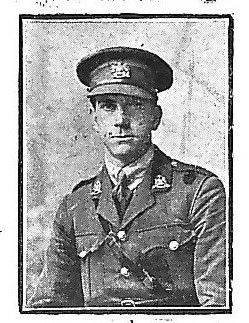 Second Lieutenant William. C. Smith, killed in action 31 July 1918.
Second Lieutenant William. C. Smith, killed in action 31 July 1918.
William was buried at 1430 hours on 31 July in Bertrancourt Military Cemetery, plot 2, row E, grave 41. The epitaph on his headstone reads 'THOU WILT KEEP HIM IN PERFECT PEACE'. His funeral was attended by a fellow officer from the battalion, 2nd Lieutenant J. W. Holmes
The Hundred Day Offensive
By July 1918 the German Spring Offensive had largely petered out, it had cost 178,000 British casualties, the Germans suffered 239,000 casualties and the French 77,000. In the early hours of 8 August 1918, the Allies launched a series of successful offensives, known collectively as the ‘Hundred Day Offensive’ starting with the Battle of Amiens. It began with an attack by more than ten Allied divisions—British, Australian, Canadian, and French. At their disposal were 1,386 field guns and howitzers, 684 heavy guns and 580 tanks.
Due to the surprise nature of the attack, Allied forces advanced by up to eight miles across a fifteen mile front in four days of fighting which resulted in 120,000 casualties across both sides. General Erich Ludendorff called the opening day of the offensive ‘The Black Day‘ in the History of the German Army.
This was to ultimately result in the Germans losing all of the ground that they had taken in the Spring Offensive, the collapse of the Hindenburg Line, the retreat back into the 'Homeland' and the inevitable capitulation of Germany that coming November.
August started quietly for the battalion, after being relieved by the 6th Manchester's on the night of the 1st/2nd they moved back into support. Whilst out of the line they received 37 replacements from the 2/5th Manchester's who had been disbanded.
Two days later after being relieved by 1/7th Battalion Lancashire Fusiliers they moved out of the line to Bus-les-Artois Wood to the west of Colincamps. Now the tactics were to change and the brigade started training for offensive operations. On 4th August Lieutenant Colonel Darlington returned to resume command but four days later he was admitted to hospital sick.
On the evening of the 12th/13th the battalion went back into the front line, relieving 1/5th Battalion East Lancashire Regiment in the right sub-sector of the brigade front. At noon on 14th August word came through from the New Zealand Division on the Manchester's left, that the enemy had withdrawn from their forward positions and that the Kiwis were now pursuing them eastwards towards Serre-les-Pusieux. The time for static trench warfare was over and the troops had to quickly adapt to open warfare in pursuit of the withdrawing enemy.
A patrol from 'C' Company consisting of Lieutenant E. D. Soulsby, 2nd Lieutenant F. R. Bootland plus eight men, left the front line from the Borden Avenue trench with the object of keeping in contact with the withdrawing enemy forces. They reached a point where Vallade Trench crossed Roman Road without opposition. They relayed this back to Battalion Headquarters who sent a platoon from 'C' Company forward. Then 'B' Company under Captain J E. Smart moved forward to the Beaumont Hamel to Serre road, reaching there at 1700 hours despite sustaining several casualties from sniper fire.
'A' Company then moved forward and reached the old front line trenches. 'D' Company stayed behind in the original support trenches until the other companies had consolidated their new positions, in which they stayed overnight.
The next morning 'B' Company attempted to push forward over a ridge line but was held up by an artillery barrage in which their officer in command, Captain Smart was wounded. A second attempt was made, this time successfully despite stiff opposition from machine gun fire and snipers. The enemy were found to be holding the Beaucourt to Puisieux road fairly strongly.
Over the next four days the battalion patrolled aggressively and probed the enemy positions on the Beaucourt to Puisieux road but were beaten back. Eventually on the 18th with the help of an artillery barrage and heavy machine gun fire the enemy withdrew. Identification of which regiments of the German 17th Army that were opposing the Manchester's was made, with the discovery of three dead Germans in a sunken road.
That night the battalion was relieved by the 6th Manchester's and moved in to Brigade Support. The casualty count over the four day period was two killed in action, one later died of his wounds and 29 wounded.
In what was becoming a fluid situation the companies and battalions and brigades were leapfrogging each other in an effort to keep pressure on the Germans who were now withdrawing all along the front, back to the defensive Hindenburg Line. Close contact had to be kept with the divisions on either flank to prevent any friendly fire incidents,
A successful operation was carried out on 21 August by 42nd Division in conjunction with 21st Division on their right and the New Zealand Division on their left. The 5th Manchester's attached a company to each of the 6th and 7th Manchester's, the remainder acting as brigade support.
At 0455 hours 21st Division attacked and captured Beaucourt sur Ancre. Then the 6th and 7th Manchester's with the two attached companies from the 5th Manchester's took their first objective which was a ridge to the south east of Colincamps in grid squares K32b and R2b. A number of prisoners were captured along with several machine guns and some war material.
The newly won positions were consolidated and the two support battalions were moved up closer to the two battalions in the front line. Between 0430 and 0530 hours on the 22nd the expected German counterattack started with a heavy barrage falling on the newly won positions.
The 7th Manchester's on the left were attacked and their outpost line penetrated but the enemy were driven out and the line restored. During the barrage the enemy shelled in the vicinity of Battalion Headquarters with gas shells, the concentration of gas becoming so great that the headquarters had to be relocated. The battalion casualty count for 22 August was one killed in action, two dying of their wounds, one missing believed wounded and 23 wounded.
There was little change to the situation during the following day, outposts were established in a line running through grid squares K33a and K33d. The German artillery continued their daily shelling of the Puisieux to Beaucourt road and grid squares K32c and R2b. That day thirteen other ranks were wounded.
On 24 August the enemy were again forced to withdraw. The front line battalions followed up immediately, crossed the Ancre river at Miraumont which had already been captured by the division, and took possession of the ridge in grid square R11b. The 5th Manchester's remained in brigade support but kept up with the forward battalions.
During the evening the battalion moved up to the front line, two companies moved to grid squares R3a and K33d. At 1900 hours orders were received to occupy the high ground in grid square R11b, two companies immediately moved forward, the remainder of the battalion moved out at 2100 hours, crossed the Ancre and were in their new positions by 0130 hours. Just prior to that two mines were exploded on the Pys to Miraumont road causing casualties to an artillery team.
The next day 42nd Division was moved back into Corps Reserve in positions to the east of Pys, but on the 26th the division was once again moved to new positions in Irles, to the east of Miraumont.
On the night of the 27th/28th 42nd Division relieved the 63rd Naval Division with the 5th Manchester's relieving two companies from the Anson Battalion and two companies from 2nd Battalion Royal Irish Regiment. All day during the 28th the battalion was on the receiving end of considerable machine gun fire and artillery barrages from the direction of Ligny-Thilley.
The next morning it was discovered that Ligny-Thilloy had been evacuated. Patrols were sent forward to reconnoiter, then the division started pursuing the Germans once again.
126th Brigade were point brigade and the 5th Manchester's were required to keep within 1,000 yards of their rear battalion, the 10th Manchester's. 126th Brigade were eventually held up by heavy shelling and machine gun fire on the Bapaume to Beaulencourt road. The rear areas were also heavily shelled causing casualties to men and animals in the transport lines.
At 0230 hours on 30 August oral orders were received that the division would resume the advance at 0500 hours. The 5th Manchester's were placed at the disposal of 126th Brigade and 'C' and 'D' Companies saw action protecting the brigades right flank. During the morning the New Zealand Division made good progress capturing Bancourt and Fremicourt to the east of Bapaume.
In the afternoon the 5th Manchester's were released back under the control of 127th Brigade. One Platoon from 'A' Company and patrols from 'C' Company were sent out on the right flank to make contact with the left flank of 21st Division who they located in trenches in grid square N.9.7.4, at a crossroads intersection facing the village of Beaulencourt.
At 1930 hours the 10th Manchester's attacked Riencourt-les-Bapaume and reached the western outskirts. That evening 127th Brigade became the leading brigade in the division. The 10th Manchester's continued as point battalion, with 6th Manchester's in support, 5th Manchester's protecting the right flank, and 7th Manchester's in reserve.
At 0500 hours on 31 August, with the help of artillery support, the German's counterattacked the New Zealand Division's positions pushing them back about 400 yards. At 1000 hours that morning the 10th Manchester's captured Riencourt-les-Bapaume, taking 20 prisoners.
A platoon from the 5th Manchester's on the right flank was sent out to patrol the north of Beaulencourt. It came under heavy machine gun and sniper fire and suffered eight casualties. Another patrol led by 2nd Lieutenant Gilbert was fired on by at least four machine guns.
At 1730 hours orders were received that after being relieved by the 7th Manchester's the battalion would move into Riencourt-les-Bapaume to relieve the 10th Manchester's, the relief was complete by 0130 hours on 1 September.
To ensure close co-ordination 'A' Company on the left shared trenches with the New Zealand Division, 'B' Company did the same with 21st Division on the right. 'D' Company was in the centre with 'C' Company in reserve to the west of Riencourt-les-Bapaume.
At 0200 hours 21st Division began the attack on Beaulencourt. At 0500 hours 'A' Company of the 5th Manchester's reconnoitered the ground in grid square N11b, they encountered no enemy but the ground was continually swept by machine gun fire. Four hours later 21st Division reported that Beaulencourt had been captured. During the afternoon hours the divisions consolidate their ground and joined their front lines once more.
At 1800 hours orders came through for the 127th Brigade attack on Villers-au-Flos, a village one and a quarter miles to the east of newly captured Beaulencourt.
The Battle of Villers-au-Flos
The battle plan for the attack on Villers-au-Flos called for a two battalion assault, 6th Manchester's on the left, with 5th Manchester's on the right. The 7th Manchester's were in reserve, less one company who were attached to the 5th Manchester's for protection on the right flank.
At 0506 hours on a cold and misty 2nd September the preliminary barrage opened up, at 0518 hours the barrage started creeping forward with the advancing battalions 400 yards behind. Immediately the Germans opened up with withering machine gun fire.
The 5th Manchester's point companies were 'A' Company on the left, and D' Company on the right, with a gap of fifty yards between them. B' Company were in close support 100 yards behind, with 'C' Company a further 200 yards behind them.
The village was entered by 'A' Company at 0550 hours and by 0600 the enemy were seen running away to the right of the village. After the first objective was reached 'C' Company passed through and moved onto the second objective which was reached at 0635 hours. The companies then went firm and consolidated their positions.
AT 0605 hours a message had been received from Captain J.M. Greer of 'D' Company that he was held up on the right and in need of support. The position on the right was obscure for a number of hours with pockets of the enemy holding out.
Sixty enemy in a sunken road were the cause of considerable trouble, two sections of field guns attached to the battalion were turned on them, as were two machine guns. An aircraft of 59th Squadron, Royal Flying Corps flew very low over the road firing his machine guns into the enemy. The pilot claimed to have caused their surrender as a white flag was hoisted as he flew over. It was not until 1100 hours that the situation on the right flank was finally cleared up.
The brigade had been allocated tank support for the attack but owing to the short notice of intention to attack given to them the tank officers were unable to liaise with the battalion. As a consequence they were of no value during the actual attack and were not seen until the objectives had been taken.
After the successful all arms attack a congratulatory telegram was received from the Divisional Commander at 1030 hours.
Heavy casualties in killed and wounded were inflicted on the enemy and also two officers and 114 other ranks were captured. It was observed that three prisoners who captured early in the attack had been ordered to tear their shoulder straps off in an effort to avoid identifying their regiment.
During the battle of Villers-au-Flos 5th Battalion suffered three officers and 23 other ranks killed in action, seven officers and 87 other ranks wounded, and one missing in action.
At 0430 hours the next morning the battalion was relieved and the brigade moved into divisional reserve on the outskirts of Thilloy. On 6 September the battalion moved into billets at Warlencourt-Eaucourt, some five miles in the rear.
The battalion remained at Warlencourt-Eaucourt for the next two weeks, following the usual routine when out of the line of resting, bathing, church services, weapon training, musketry on the ranges and route marches. On 8 September ten officer replacements arrived, all 2nd Lieutenants.
On 20 September the 5th Manchester's marched six miles to Beugny, to the east of Bapaume, under the command of 126th Brigade. The next day at 1740 hours the battalion relieved the 1st Battalion Hertfordshire Regiment who were in close support in the Havrincourt Wood sector. This relief was of particular interest as the battalion held the line in the same sector in June and July of 1917. During the night the area was heavily shelled with mustard gas.
During the morning the effects of the gas shell bombardment became apparent. A total of 104 men had become victim to the deadly poison. Although not immediately fatal, temporary blindness, chemical burns and respiratory problems meant long hospitalizations and those that recovered were thought to be at higher risk of developing lung and respiratory cancers during later life. During the day further artillery attacks targeted the Havrincourt Wood area, a small number of shells being gas.
On the 24th 'A' and 'B' Companies moved to Bertincourt where they were accommodated in tents. 'C' and 'D' Companies remained under the command of 126th Brigade. The battalion was warned that they would be taking part in a general attack in a few days time. The assault on the formidable Hindenburg Line was about to commence.
The Hindenburg Line
The Hindenburg Line, or 'Siegfried Stellung' as it was known to it's German defenders was constructed during the winter of 1916-1917 as a secondary defensive fall back position. The line, some seventy miles long ran from Arras in the north to Soissons in the French sector to the south. It was strategically sited making use of reverse-slope positions, defence in depth and camouflage. With its series of fortified redoubts, machine gun positions, and fields of thick wire entanglements it was considered impregnable.
A sequence of Allied offensives began on 26 September 1918 with attacks by American and French armies in the south from Rheims to the Meuse, the Third and Fourth British armies at Cambrai on 27 September, with British, Australian, Belgian and French armies in Flanders on 28 September; on 29 September the British Fourth Army (including the US 2nd Corps) attacked the Hindenburg Line from Holnon north to Vendhuille, while the French First Army attacked the area from St Quentin to the south.
The British Third Army with the battle hardened Canadian and New Zealand Corps attached, attacked further north and crossed the Canal du Nord at Masnières, broke through the Hindenburg Line and took 36,000 prisoners and 380 guns.
The battle at Masnieres began with a fifty six hour long bombardment, using 1,637 guns along a 10,000-yard-long front. In the last 24 hours the British artillery fired a record 945,052 shells, including 30,000 mustard gas shells. The St. Quentin Canal was captured with a creeping barrage of fire; 126 shells for each 500 yards of German trench over an eight-hour period.
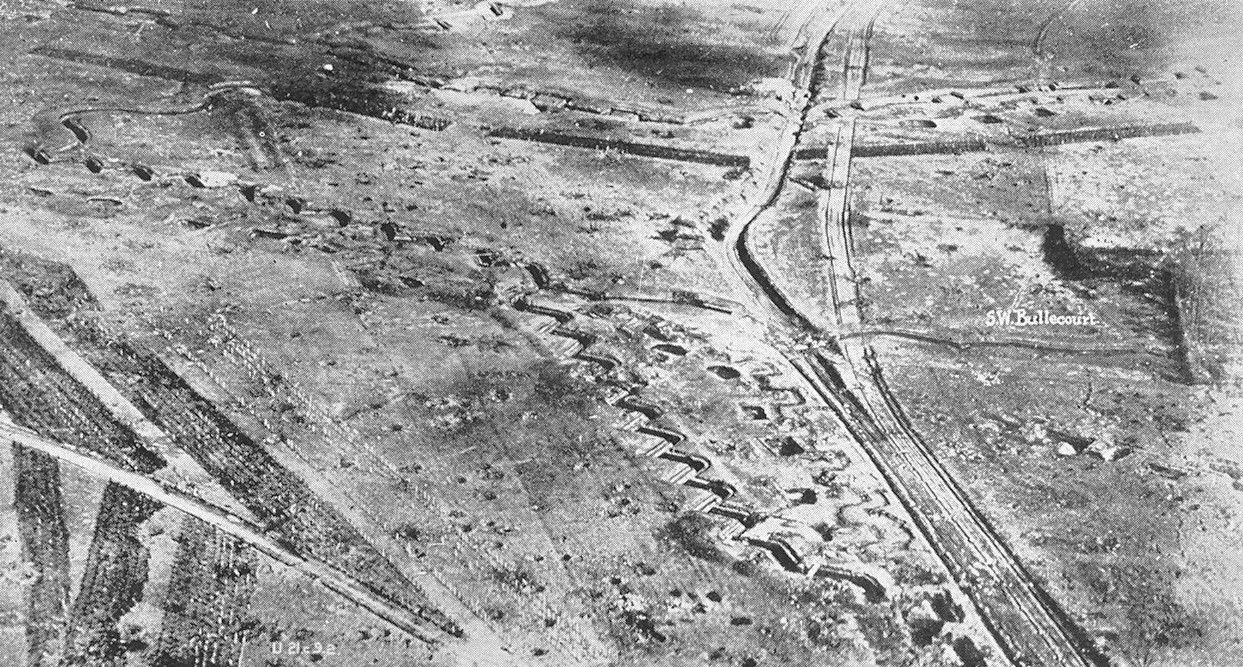 The Hindenburg Line photographed after the cessation of hostilities
The Hindenburg Line photographed after the cessation of hostilities
On 25 September a conference was held at 127th Brigade Headquarters in which details of the upcoming attack were settled. 'A' Company, plus an attached platoon from 'C' Company and 'B' Company of the 5th Manchester's would be in the centre, with the 6th Manchester's on the left and 7th Manchester's on the right flank. Also the brigade would have four tanks in support.
By 0100 hours on the 27th the companies were ready at the start point. At 0530 hours 3rd Division under a creeping artillery barrage advanced and captured Flesquires and the high ground. This resulted in a hostile retaliation from German Artillery all along the front line.
The brigades barrage started at 0800 hours and six minutes later 'A' Company were attacking their objective. 'B' Company were initially held up by machine gun fire but continued to assault and capture their objective. The 6th and 7th Manchester's came forward and contact was made on either flank. At 0915 hours the first German prisoners from the 64th Infantry Regiment of the 6th Division arrived at battalion headquarters.
The attack on the brigade front progressed well and by 0950 hours more prisoners started pouring back. However at mid-day Brigade Headquarters were informed that the situation on the right flank was obscure with the enemy still in possession of trenches that could endanger the 6th and 7th Manchester's positions. 'C' and 'D' Companies from the 5th Manchester's who were in reserve moved forward, one company reinforcing the 7th Manchester's, the other providing flank protection.
At 1800 hours the situation on the right flank was cleared up and contact was made between the 7th Manchester's and the Lancashire Fusiliers from 125th Brigade on their right. The Manchester's held the line for the night with 6th and 7th Battalions holding the newly captured ground with 5th Manchester's in support and 8th Manchester's in reserve.
At 0230 hours the next morning the 10th Manchester's and 1/5th Lancashire Fusiliers passed through the front line and carried on to the next objective. 127th Brigade was ordered to stand by ready to move forward at 1030 hours but this was cancelled and 126th Brigade took over the front instead.
On 29 September the New Zealand Division relieved 42nd Division who then came out of the line and moved back to the Havrincourt area.
The 5th Manchester's casualty count after the battle was one officer and 13 other ranks killed, another later died of his wounds, 51 other ranks were wounded and two other ranks were missing in action.
The fifteen dead from the 5th Manchester's were buried at Ribecourt Road Military Cemetery in Trescault. Rows B, C and D in Plot I contain graves of November 1917 to February 1918, mainly of the 51st (Highland) and 59th (North Midland) Divisions; but the remainder of the cemetery was made in October 1918, by the 42nd Division, who originally named it the Divisional Cemetery, Trescault.
Amongst those killed was twenty years old Edward Strike who enlisted at Atherton. He was one of eleven children of Harry and Martha Strike, who moved from Tunstall in Staffordshire to live at 17 Peace Street, Gin Pit village in Astley, near Leigh. The 1911 census shows that he working as a haulage hand underground at the age of thirteen.
Edward was buried in Plot 4, Row C, Grave 1. The inscription on his headstone reads, 'His Name Endureth For Ever'.
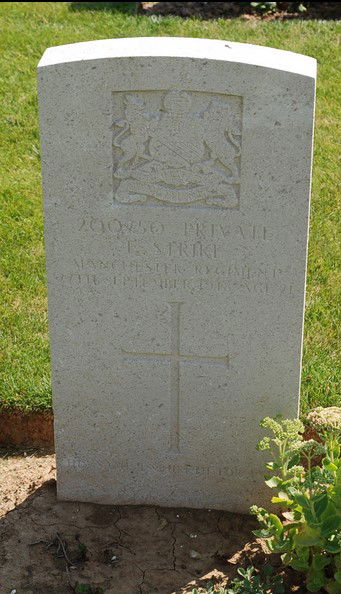 The grave of Private Edward Strike, killed in action in France, 27 September 1918
The grave of Private Edward Strike, killed in action in France, 27 September 1918
Also killed was twenty years old Private Thomas Moss from Wigan. The 1911 census shows Thomas living at 251 Woodhouse Lane with his parents George and Emma and his three brothers. At the time of his death the family were living at 65 Marsh Green, Wigan. Thomas is buried in Plot 4, Row B, Grave 8. The inscription on his headstone reads, 'In Affectionate Remembrance from Father Mother and family'.
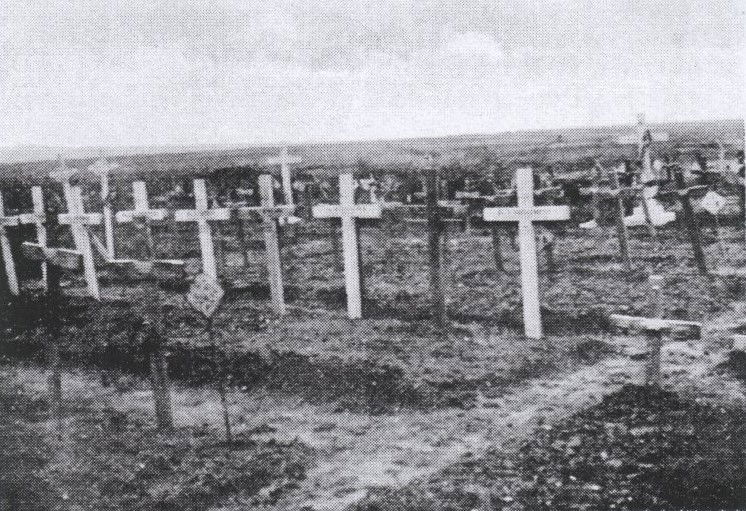
 Above: Ribecourt Road Cemetery, Trescault in October 1918: Below: the cemetery today, immaculately cared for by the gardeners of the Commonwealth War Graves Commission
Above: Ribecourt Road Cemetery, Trescault in October 1918: Below: the cemetery today, immaculately cared for by the gardeners of the Commonwealth War Graves Commission
At mid-day on 8 October, after nine days out of the line resting and reorganising at Ruyaulcourt, 42nd Division was on the move again. 127th Brigade marched via Metz-en-Coutre to Gouzeacourt, they reached the bivouac area at 1630 hours, only to find there was very little accommodation so the night was spent in the open. That evening orders were received that the division would be going back in the line and continuing the advance the following day.
The next day the battalion marched to Le Grand Pont, where they were given one hours notice to move to Fontaine-au-Pire. This was later cancelled and the division was told it would stay in position for the next two or three days.
On the 13th 127th Brigade marched to La Guisette Farm, on the western outskirts of Bethencourt, and about three miles from the River Selle. The next day the war diary notes that Lance Corporal J. Cunningham and Private R. Kane were awarded the Military Medal.
The next few days were spent training, on the 17th the battalion practiced the attack over open countryside under a rapidly moving barrage. The next day more gallantry awards were made, Privates H. Hooley, W. Radcliffe, H. Valentine, and J. Whitehead all receiving the Military Medal.
The Battle of the Selle
The next obstacle in the way of the Allied advance was the River Selle. Although not wide, a railway embankment on the eastern side of the river carrying the Le Cateau to Wassigny railway, and a ridge line behind that made it a natural defensive position for the Germans.
Fourth Army troops attacked at 0520 hours on Thursday 17 October. Infantry and tanks, preceded by a creeping barrage, moved forward on a 10 miles front south of Le Cateau. Eventually the River Selle was successfully crossed on the night of the 19th and La Cateau was captured.
North of Le Cateau the Third and First Armies were preparing to attack. At 1730 hours on 19 October a runner delivered a message marked 'Secret' from Brigade Headquarters to 5th Battalion Headquarters. It was 127th Brigade Order No. 12, informing that 42nd Division would be attacking the following day with 62nd Division on the north and 5th Division to the south.
127th Brigade was tasked with capturing and consolidating a line from a spur of land about one and half miles to the east of the village of Solesmes, which ran through the hamlet of Marou, along a sunken road to a crossroads on high ground.
On a wet and miserable evening the battalion moved out of La Guisette Farm on route to the assembly point which they reached about an hour later, the war diary notes that the Padre, 'Woodbine Willie', had been wounded that day.
126th Brigade attacked at 0200 hours on 20 October. 127th Brigade followed on with the 5th Manchester's as point battalion. 'B' and 'C' Companies moved off at 0415 hours, to be met by a barrage of enemy artillery fire on the western flanks of the Selle Valley. They crossed the River Selle 45 minutes later. 'A' and 'D' Companies following on 500 yards behind.
127th Brigade passed through the 126th Brigade’s positions, 5th Manchester’s on the right, 6th on the left and the 7th in support and by 0630 hours were in the jumping off positions for the assault on Marou. At 0700 hours the creeping barrage commenced but some field guns were firing over a thousand yards short inflicting many casualties on their own troops.
'A' and 'C' Companies on the left were able to get forward and captured about eighty Germans. However 'B' Company was held up by fire from a sunken road, and from the right flank where the 5th Division had failed to get forward, suffering many casualties.
Volunteers were asked for to go back to 'D' Company, who were in reserve to inform them of the situation. Four men, one after the other, went out with the request for reinforcements. All were killed as they tried to cross the 600 yards of open country which lay between them and their reserve line.
Although seeing four of his comrades killed and knowing his chances of survival were slight Pte Alfred Wilkinson volunteered to try himself. He took fifteen minutes to carefully cross the battlefield but somehow he got through and delivered his message. Then, again running the gauntlet of fire across the open land, he re-joined his company, once more without being hit. 'D' Company came forward to assist but arrived too late as 'B' Company was obliged to withdraw to a sunken road, where 'D' Company joined them.
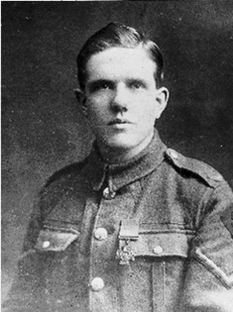 Lance Corporal Alfred Wilkinson wearing his Victoria Cross
Lance Corporal Alfred Wilkinson wearing his Victoria Cross
At 0830 hours, following 'B' Company's withdrawal, the Commanding Officer Lieutenant Colonel Panton took a small party forward to 'B' and 'D' Company's position in the sunken road to ascertain the situation. They included the Adjutant Captain G. G. Kershaw, and the the Intelligence Officer, 2nd Lieutenant A. G Heyhoe. Here the commanding officer was wounded and 2nd Lieutenant Heyhoe was killed.. Major W. M. Tickler MC who was in Brigade Headquarters as Liaison Officer was sent for to take over the command of the battalion.
An hour later 'A' and 'C' Company's reported that they were on their objectives in the sunken road, soon after the 7th Manchester's reported that they were also in the sunken road and were moving up to connect with 'A' and 'C' Companies.
At 1150 hours 'D' Company received verbal orders to move up to the sunken road and connect with 'A' Company on their right flank. 'B' Company moved to the high ground on the ridge line to the south of Marou to cover 'C' Company who was receiving fire from the north.
At 1330 hours a warning order was received that 5th Division would be attacking on the right flank and 62nd Division to the north of Marou. The battalion was to co-operate by taking the ridge overlooking Marou. The barrage commenced at 1600 hours, the attacks were successful and 'A' Company captured the ridge, along with two prisoners.
During the afternoon Captain S. Dickinson MC, the Officer in Command of 'C' Company was killed by shellfire, Lieutenant G. B. Wellings took over command. The 7th Manchester's moved up on the battalions right and at 1915 hours the companies were re-positioned. 'B' and 'D' Companies moved up to the ridge to relieve 'A' Company who moved to a position to the south of Marou. 'C' and 'HQ' Companies remained in their locations.
At 2100 hours the 6th Manchester's attacked and captured the final objectives. There was fairly heavy shelling of the forward areas all night and the companies were kept on high alert. During the next day enemy planes flew low over the brigade's positions, in the afternoon a patrol from 'C' Company went forward 500 yards towards the village of Ovillers but saw nothing.
That evening the brigade was relieved by 125th Brigade, the 5th Manchester's handing over to the 1/7th Lancashire Fusiliers. At 2130 hours, after two days in action the battalion marched back to La Guisette Farm.
For his bravery during the battle and good work during the rest of the day, Private A. Wilkinson was immediately recommended for the award of the Victoria Cross. The casualty figures after the battle show that the battalion had suffered three officers and 22 other ranks killed in action, two officers and 93 wounded, of which seven later died of their wounds. Three were suffering from shell shock and four were missing.
After the battle 42nd Division withdrew west of the river and on 22 October concentrated in the Beauvois-En-Cambresis area. Ten days were spent at Beauvois with company training usually occupying the mornings and specialist training classes in the afternoons. This came to an end on 3rd November when the Division began its move forward to relieve the New Zealand Division in the Mormal Forest .
The battalion marched north east via Viesly, and Pont a Pierres, arriving at Herbignes at 1700 hours on the 5th where billets awaited. The war diary states that the next day was exceedingly wet and while marching to their next objective Carrefour De Cheval Blanc they were ordered to halt. They spent most of the day in a wood until orders were received to return to billets at Le Quesnoy.
The troops were not to know it but they had fought their last battle of the war at Marou, there would be no more casualties. After spending a day at Le Quesnoy they marched ten miles to billets at Hargnies arriving at 1530 hours on the 8th.
The Armistice
The 9th of November was spent cleaning up and improving billets, there was even a football match in the afternoon. They were unaware of events that were unfolding at the time in Germany, civil unrest across the country and the threat of revolution led to the abdication of Kaiser Wilhelm II who was to go into exile in Holland. A parliamentary democracy was proclaimed and the Prussian monarchy and Germany's twenty two constituent monarchies were abolished.
Next day was a busy day with billet cleaning, medical inspections, working parties provided for the Royal Engineers, visits to the baths and a Devine Service for Roman Catholics. The war diary states that information had been received that the Kaiser had abdicated and his son the Crown Prince had renounced the throne. Also that the 1st French Army had reached the Franco-Belgian border.
On the morning of Monday 11 November 1918 the following general order was issued to all units:
‘Hostilities will cease at 11am today. Troops will stand fast on line reached at that hour. Defensive precautions will be maintained. There will be no intercourse of any description with the enemy’.
The battalion war diary simply states: '0900 Bn parade and C.O’s inspection. News received that armistice would commence at 1100 today. Massed bands of Brigade played ‘Cease Fire’ and ‘No Parade Today’ at Hargines Church at that time. Casualties 1 sick to hospital’.
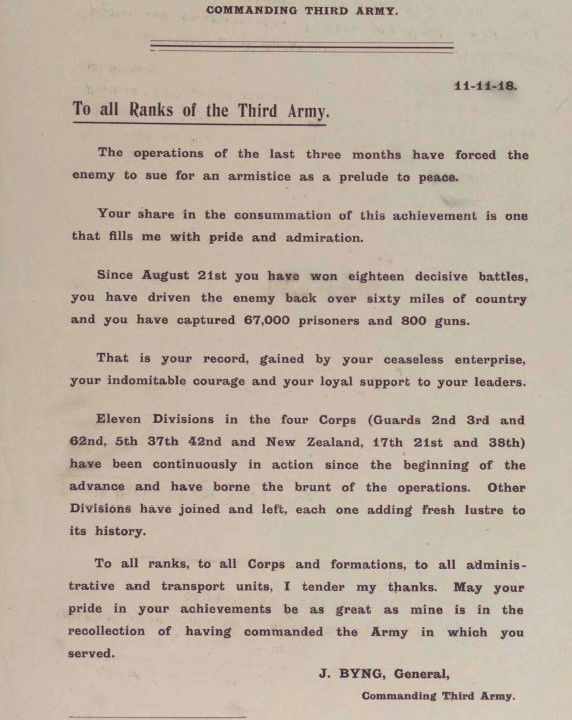 Directive from General Sir Julian Byng GOC 3rd Army During the 100 Day Offensive the 5th Manchester's casualty figures consisted of 50 killed in action (including six who died of their wounds), 377 wounded (including 126 by gas poisoning), eight missing in action, and 286 admitted to hospital sick.
Directive from General Sir Julian Byng GOC 3rd Army During the 100 Day Offensive the 5th Manchester's casualty figures consisted of 50 killed in action (including six who died of their wounds), 377 wounded (including 126 by gas poisoning), eight missing in action, and 286 admitted to hospital sick.
Two days later on 13 November the Battalion moved into more permanent barracks in the nearby town of Hautmont where they were to spend the next month. The Western Front was visited by King George V and his sons, the Prince of Wales, (future King Edward VIII), and Prince Albert, (future King George VI), on 1 December and passed through 42nd Division’s area. 5th Battalion was assigned to line the route along the Maubeuge to Avesgnes-Sur-Helpe road to salute the royal party.
On 14 December 127th Brigade marched out of Hautmont and on successive days marched to billets at Fort-De-Boussois, then across the Belgian border to Piesssant, then onward via Merber-St. Marie to billets at Trahegnies.
By 19 December 127th Brigade had settled into billets in Fleurus to the north east of Charleroi where they were to stay for the next eleven weeks. The war diary states that next day two subalterns arrived with the Battalion Colours and that orders were received for the demobilisation of coal miners.
Training carried on as usual with musketry, route marches, drill and physical fitness. There was plenty of recreation time as well though with church services, visits to the baths, football and boxing competitions. There was also educational classes in subjects such as elementary reading and writing, arithmetic, French, shorthand, book keeping and shoe making.
Not selected to join the Army of Occupation in Germany, demobilisation got under way, and over the period 22nd to 31st December 204 personnel returned to the UK.
The war diary recorded its last fatality on 9th January 1919 with the death of a soldier in hospital from sickness. On the 16th there was a lecture on ‘A Frenchman’s View on England’ and on the 18th there was a lecture on the ‘Naval Raid on Zeebrugge’. On the 22nd the Battalion paraded for the presentation of campaign medal ribbons by the Divisional Commander.
During February a draft of thirty men transferred to 2nd Battalion Manchester Regiment and 108 personnel returned home for demobilisation. On the 15th three officers and 82 other ranks travelled to Montigny-le-Tilleul, to the south of Charleroi to do guard duties on a supply depot, returning on the 25th.
Hero’s Return
On 22 January 1919 Major General A. Solly-Flood, Commanding 42nd (East Lancashire) Division issued a special order of the day informing the division of the award of the Victoria Cross to Pte Wilkinson.
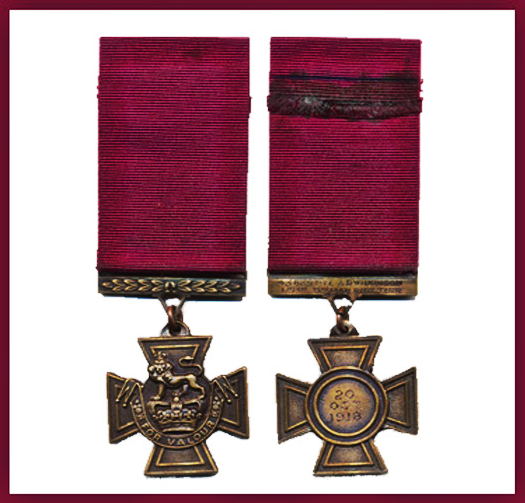 The Obverse and Reverse faces of the Wilkinson VC
The Obverse and Reverse faces of the Wilkinson VC
His citation from the London Gazette dated 6 January 1919 reads:
'On the 20th October 1918 at Maru, France, four runners in succession having been killed in an endeavour to deliver a message to a supporting company, Private Wilkinson volunteered for the duty. He succeeded in delivering the message, though the journey involved exposure to heavy machine-gun and shell fire for 600 yards. He showed magnificent courage and complete indifference to danger, thinking only of the needs of his company and entirely disregarding any consideration for personal safety.’
On 8 February Alfred was given 14 days special leave to return to the UK to receive his award. On arrival at Leigh railway station the Mayor Alderman J. Ashworth JP, his own family and crowds of people were there to give him a hero’s welcome home. He was driven in an open landau to the Town Hall escorted by mounted and foot police, a detachment of soldiers from the guard at the Leigh prisoner-of-war camp, and St John’s brass band together with a number of discharged soldiers and sailors.
At the reception that followed he was presented with an illuminated address and 500 War Savings certificates from the directors of the Mather Lane Spinning Company, and a gold watch from the members of the St Joseph’s Boys and Young Men’s Society.
 Illuminated address presented by Mather Lane Spinning Company
Illuminated address presented by Mather Lane Spinning Company
On 22 February 1919, now promoted to Lance Corporal, Alfred travelled to London with his Mother and brother Henry, then serving with the South Lancashire Regiment, to receive the Victoria Cross from King George V at Buckingham Palace. His eldest brother John and his youngest brother Francis had both been killed in action during the war. His father, also named Alfred, had died during the war on 19 October 1916.
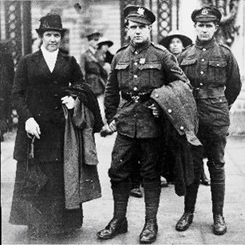 Alfred Wilkinson with his mother Sarah and brother Henry outside Buckingham Palace after receiving his VC in 1919
Alfred Wilkinson with his mother Sarah and brother Henry outside Buckingham Palace after receiving his VC in 1919
After the ceremony Alfred returned to Belgium to re-join what was left of his old battalion who were still billeted at Fleurus. Shortly after on 27 February Lt. Col Darlington arrived at Fleurus to take command of the battalion cadre.
1/5th Battalion Cadre Bringing the Colours Home to Wigan
On 6 March one officer and 54 other ranks departed for the UK and demobilisation. The next day all the battalion cadres of 127th Brigade marched the few miles to billets at Charleroi. The next few weeks were spent kicking their heels doing recreational training and church services, on 15th March Major General Solly Flood formally relinquished command of 42nd Infantry Division. On the 25th the cadre underwent a health inspection by the Medical Officer.
At 1645 hours on 28 March 1919, the cadre of the 1/5th Manchester’s together with the cadres of the other battalions of the brigade boarded a train at Haute Ville station in Charleroi, bound for Antwerp. The Wigan battalion consisted of Lieutenant Colonel H.C. Darlington, Captain W.O. Edwards, Captain Anderson, Lieutenants Holmes, Sobee and Lawton, together with Lance Corporal Wilkinson VC and 49 other ranks.
From Antwerp they sailed to Immingham Docks on the River Humber. They then travelled by train to the demobilisation depot at Oswestry in Shropshire where equipment was handed in and the demobilsation procedures were carried out.
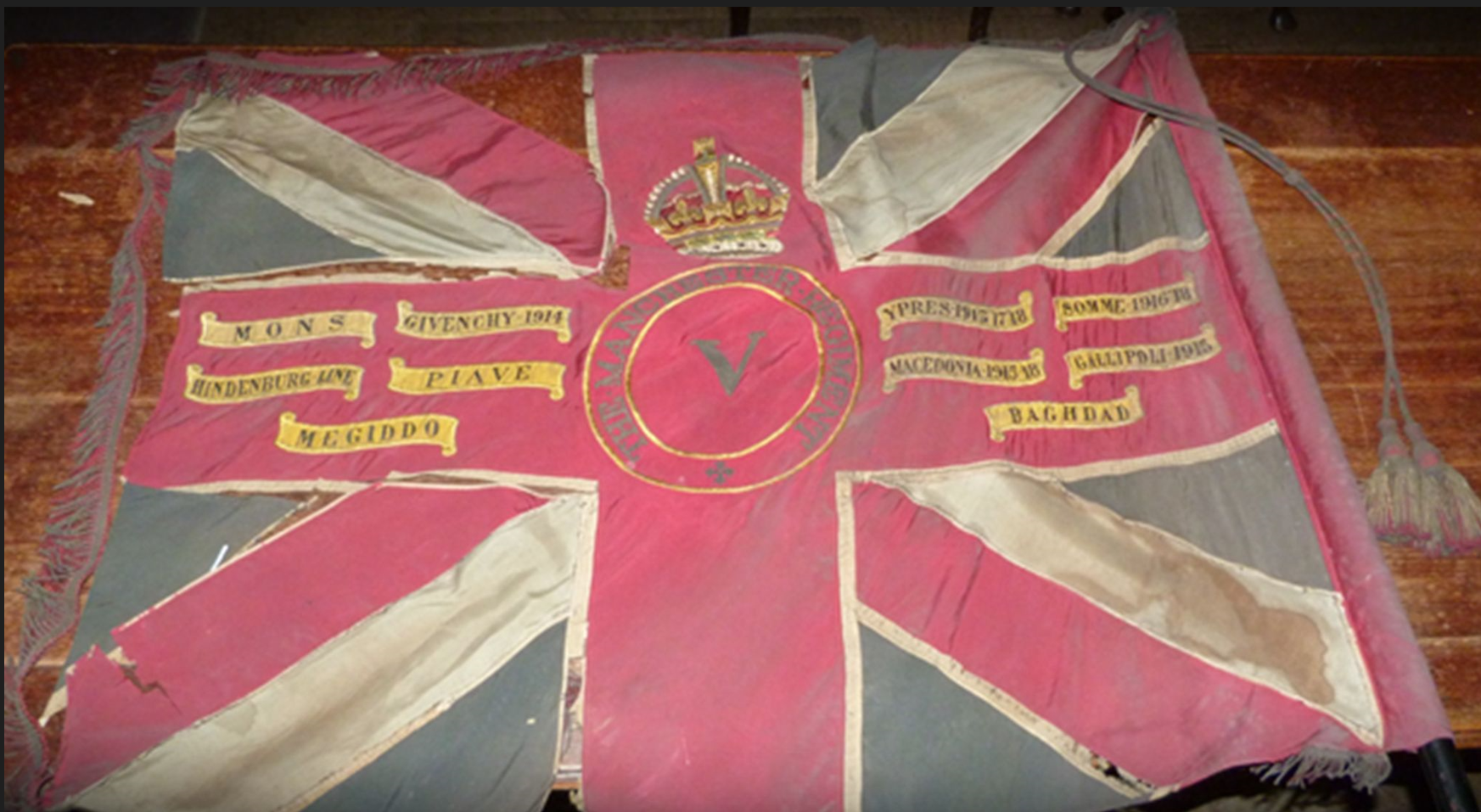 King's Colour 5th Battalion Manchester RegimentOn the 7th April the Wigan Cadre, complete with the Regimental Colours, arrived at Wigan to be welcomed by the Mayor and townspeople and many of their old comrades. The cadre then marched through the town packed with enthusiastic well-wishers. The Mayor gave a few words of welcome after which they were entertained to a hot-pot meal in the Wigan Volunteer Drill Hall.
King's Colour 5th Battalion Manchester RegimentOn the 7th April the Wigan Cadre, complete with the Regimental Colours, arrived at Wigan to be welcomed by the Mayor and townspeople and many of their old comrades. The cadre then marched through the town packed with enthusiastic well-wishers. The Mayor gave a few words of welcome after which they were entertained to a hot-pot meal in the Wigan Volunteer Drill Hall.
Regimental flags or Colours originally went into battle and acted as a rallying point for troops and to mark the location of the commander. There are normally two Colours, the Sovereigns Colour and the Regimental Colour, collectively called a stand. They carry the battle honours of the regiment and are one of the most sacred symbols of the British Army. Nowadays they are paraded on special ceremonial occasions, acting as a focus of regimental pride and embody the honour, esprit-de-corps and heritage of the regiment.
After the conflict 1/5th Battalion were granted the following battle honours. Helles, Krithia, Rumani, Albert, Ypres 1917, Somme 1918, Bapaume, Arras, Ancre, Hindenburg Line, Canal du Nord, Cambrai 1918, Selle, and Sambre.
 Consecration of the 5th Manchester Colours on Wigan Market Square
Consecration of the 5th Manchester Colours on Wigan Market Square
(Under Army regulations when a battalion is presented with new colours the old stand is to be laid up in a church or chapel associated with the regiment, who then take over responsibility from the Army. The Church of England dictates that once colours have been laid up in a church they should stay where they are until they have completely disintegrated. Then the remains should be buried with the staff, along with the lion and crown which sits atop the staff, in consecrated ground without any markings.
The symbolism behind the practice is that the Colour had been allowed to die and then been buried just as the soldiers who served under the Colours had been. The original Colours of the 5th Manchester Regiment are now laid up in All Saints Parish Church in Wigan).
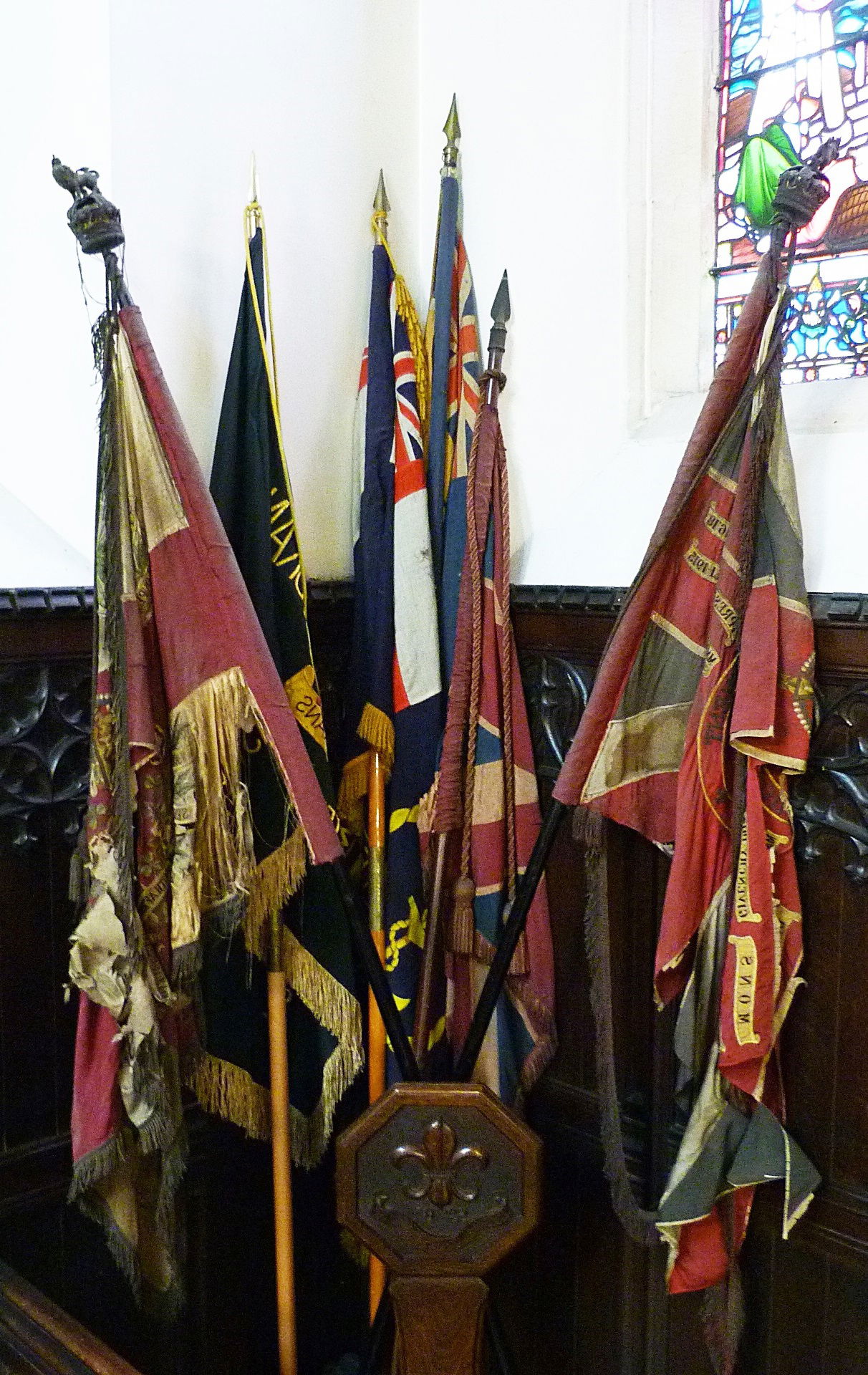 Colours laid up in Wigan Parish Church
Colours laid up in Wigan Parish Church
Although hostilities ceased with the Armistice on 11 November 1918, the First World War did not end officially until the Treaty of Versailles was signed on 28 June 1919. Any soldiers who died of their injuries before this date were accorded a military funeral. Accordingly after this date any deaths were considered to be in peace time and had a civilian burial.
In Britain, peace was celebrated on 19 July 1919, with a Victory Parade in London as the main event. A contingent of men from 5th Battalion travelled from Wigan to London and with 15,000 troops from the British Empire marched through London. The Colour Party who proudly carried the Colours consisted of Captain C. P Brown, Lieutenant Holmes, RQMS Christie DCM and Lance Corporal Wilkinson VC.
 Victory Parade in London 19 July 1919
Victory Parade in London 19 July 1919
The Human Cost
During the duration of the Great War 1/5th Battalion had received 35 separate draft replacements totalling 2,107 men. From first seeing action in Gallipoli on 4 May 1915, up to the Armistice on 11 November 1918, the battalion had suffered a total of 1,845 casualties. These comprised of 400 dead, (including killed in action, died of wounds and died of sickness), 1,308 wounded and 137 missing in action.
The war to end all wars, the war that many said would be over in three or four months had claimed over 35 million casualties, military and civilian, and at least 50 million died of Spanish Influenza as it came to a close in 1918. Total British casualties on the Western Front were nearly two and three quarter million.
The Royal Army Medical Corps had handled five and half million medical cases, two thirds of military deaths were due to direct battle injuries, the other third from disease, illness and infections. With no effective antibiotics, many hundreds of thousands died from tetanus and gas gangrene when bullet and shrapnel wounds became infected.
Recognition
It is a tradition in the Armed Forces that any appointments, promotions and honours awarded don’t come into force until the person’s details have been published in either the London, Edinburgh or Belfast Gazette. It is a practice known as being ‘Gazetted’. The Gazette has been the official journal of records or gazettes of the Government of the United Kingdom since 1665.
The Gazette records held in the National Archives in Kew show that the officers and other ranks of the 1/5th Battalion Manchester Regiment were awarded the following individual honours for service and gallantry in WW1.
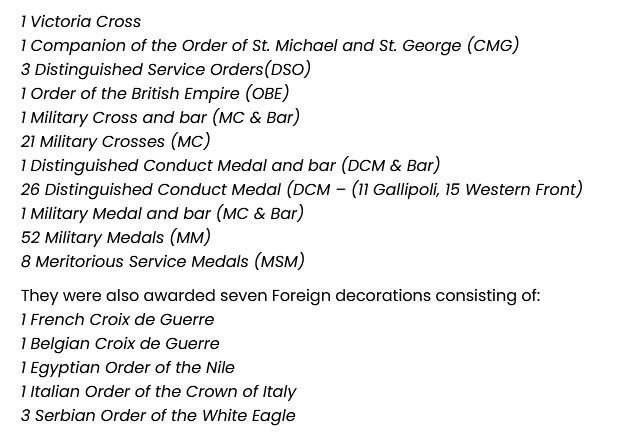
Grandfather Frank was Gazetted on 17 June 1918 when he was awarded the Meritorious Service Medal (MSM) for ‘Valuable Services Rendered in France’. He was also awarded the 1914/15 Star, British War Medal, Victory Medal, and Territorial Force Efficiency Medal. Sadly the original medals are no longer in the family, although I have acquired copies. They were possibly sold during the depression of the late 1920’s and 30’s when many working class families faced real hardship.
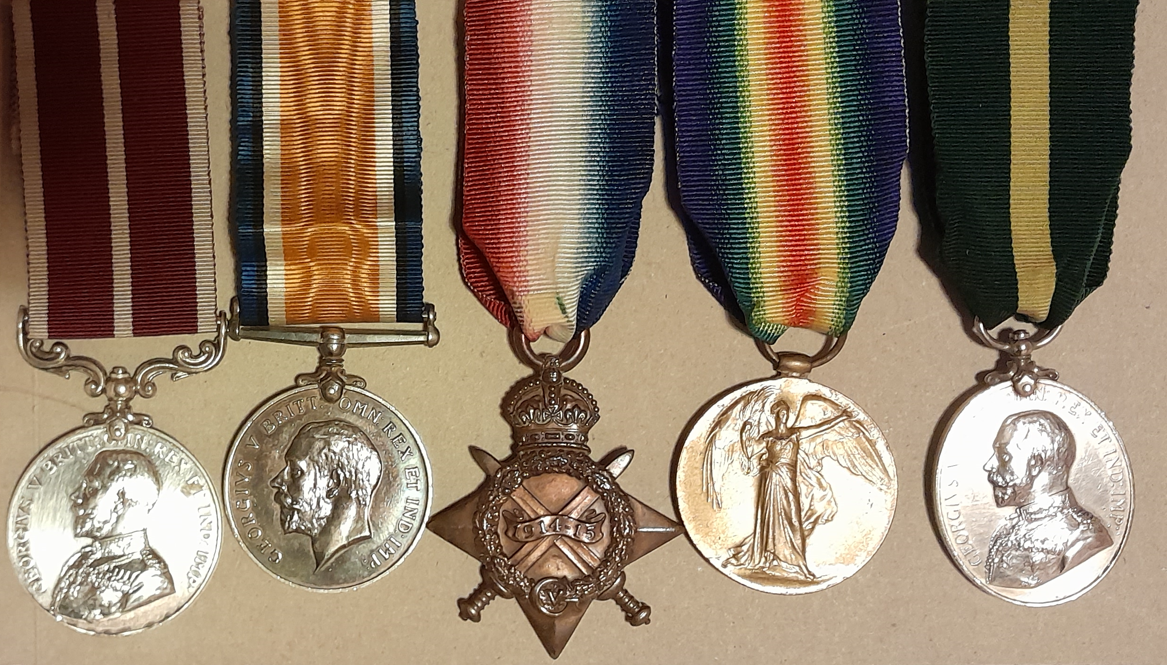 Medals awarded to Col. Sgt F.Taylor. L-R Meritorious Service Medal. British War Medal, 1914-1915 Star, Victory Medal & Territorial Force Efficiency Medal
Medals awarded to Col. Sgt F.Taylor. L-R Meritorious Service Medal. British War Medal, 1914-1915 Star, Victory Medal & Territorial Force Efficiency Medal
Thousands of unemployed ex WW1 servicemen were forced to pawn or sell their medals in order to feed their families. On Remembrance Day in 1929 many veterans paraded with their pawn tickets on their chest to show their discontent. Countless numbers of these medal sets were broken up. The Victory Medal and the Campaign Stars were cast in Bronze and therefore had limited scrap value; however the British War Medal is made of silver and many thousands were melted down for their scrap value.
42nd (East Lancashire) Division Memorial
In 1922 a battle memorial to the soldiers of 42nd (East Lancashire) Division who lost their lives in the Great War was unveiled in the village of Trescault, twenty miles south east of the city of Arras, in the Pas-de-Calais department of France. It is located 250 yards away from Ribecourt Road Military Cemetery where 78 members of the Manchester Regiment, including fifteen from the 1/5th Battalion are buried, following the battles of the Hindenburg Line of 1918.
 42nd (East Lancashire) Division Memorial, Trescault, France.
42nd (East Lancashire) Division Memorial, Trescault, France.
Sir Henry Darlington
In 1936 Sir Henry Clayton Darlington KCB CMG TD DL JP published his war time memoirs entitled ‘Letters From Helles’. The book was in the form of typescripts of army books containing notes, orders, letters and papers relating to the training of 5th Battalion Manchester Regiment in 1914. They recorded his time as Commanding Officer of 1/5th Battalion Manchester Regiment in Egypt from October 1914 to April 1915 and in Gallipoli, from July 1915 to November 1915.
In his introduction to ‘Letters from Helles’, Sir Henry writes.
"The men of the 5th Manchester’s were mostly colliers and allied trades. They were blessed with an unquenchable sense of humour, an ability to stick it, great self-reliance and an apparently natural esprit de court: the last two virtues being, I imagine, to the fact that they worked down the pit and were very loyal to their trades unions. I never knew them rattled and their outlook on affairs is well instanced by the following incident: Not being in France on Nov. 11th, 1918, I afterwards asked my Pioneer Sergeant, who was in the front line on Armistice Day , whether there was any great excitement among the men at 11 a.m. on that day. His reply was, ''I have seen more excitement at a beer issue. Of the officers I could never say enough".
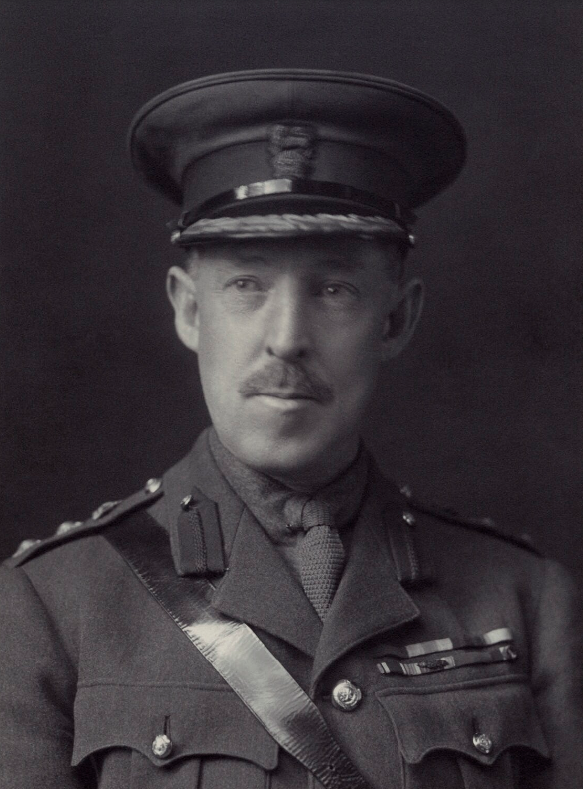 Sir Henry Clayton Darlington CMG TD DL JP
Sir Henry Clayton Darlington CMG TD DL JP
Henry came from a prominent local family and was born 27 June 1877 in Wigan, the eldest child of Henry and Edith Blanche Darlington (nee Smith). His father was a solicitor and commanded the Wigan Volunteer Battalion. His grandfather Ralph, also a solicitor held prominent positions in the town. He was Mayor of Wigan twice in 1849 and 1850 and became an Alderman. He was appointed Chief Magistrate and also held the positions of Borough Coroner and church warden.
Henry went to school at Rivington, followed by a couple of years of private tuition with Reverend John Crofts before attending Shrewsbury School. He then joined the family firm of Messrs. Peace and Darlington, solicitors of Wigan and Liverpool and qualified as a solicitor at the Supreme Court in 1904.
He had a distinguished military career, gaining a commission as a 2nd Lieutenant, aged 19 with the 1st Volunteer Battalion Manchester Regiment based at Wigan with whom he saw active service during the Boer War in South Africa. Henry married Mabel Anne Hirst at St. James CE church, Meltham Mills in Yorkshire on 21 August 1909.
He was promoted to the rank of Major on 16 September 1913. During the Great War he was mentioned in dispatches on three occasions, 22 September 1915 in Gallipoli, 6 March 1916 in Egypt and on 7 November 1917 in Belgium. In 1916 he was awarded the Companion of the Order of St. Michael & St. George and on 5 July 1918 the Order of the Crown of Italy.
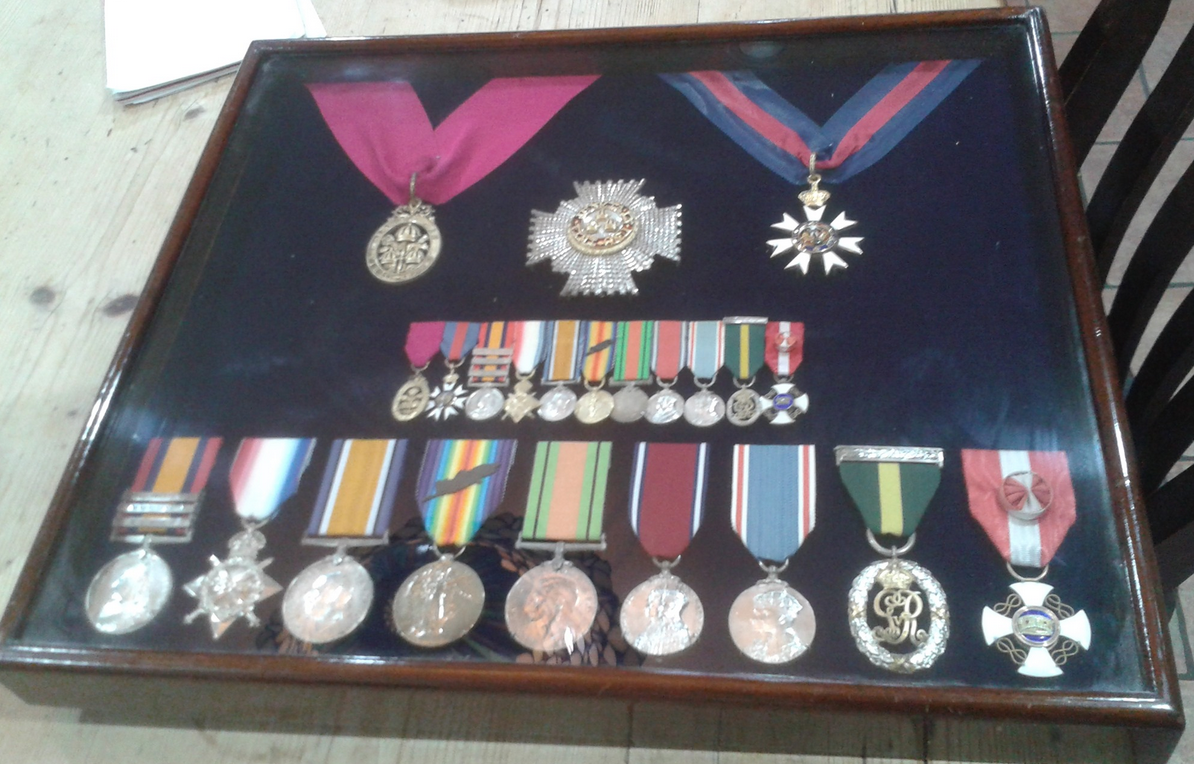 Honours and medals awarded to L. Col H.C.D Darlington
Honours and medals awarded to L. Col H.C.D Darlington
Alongside the 1914-1915 Star, British War Medal, and Victory Medal, he was awarded the Territorial Decoration. He continued as Commanding Officer of the 5th Wigan Territorial Battalion until 1920. From then until 1924 he commanded the 127th (Manchester) Infantry Brigade, eventually becoming Honorary Colonel of the regiment from 1927 to 1947.
In 1921 Henry was made a member of The Most Honourable Order of the Bath. He became Deputy Lieutenant of Lancashire, made a Justice of the Peace in 1923 and became Sir Henry in 1925 when he became a Knight Commander of the Order of the Bath in the King's birthday honours list. In 1945 he served as High Sheriff of the County Palatine of Lancashire. Sir Henry Clayton Darlington died 25 December 1959 in Hampshire, aged 82.
L/Cpl Alfred Wilkinson VC
The story of 1/5th Battalion’s only Victoria Cross recipient Lance Corporal Alfred Robert Wilkinson was to have a premature and tragic end. Alfred was born on 5 December 1896 at 27 Brideoake Street, Leigh to Alfred and Sarah Wilkinson (nee Swift). On leaving school he went to work with his father at No 3 Mill of the Mather Lane Spinning Company in Leigh where he was employed as a cotton piecer.
On 14 December 1914 he enlisted into the 2/5th Battalion Manchester Regiment at Atherton. On 27th January 1916, whilst still in training he was transferred to the 18th Battalion Manchester Regiment. and went overseas on 29th July 1916, being part of a draft of replacements for losses in the opening days of the Battle of the Somme.
18th Battalion spent August and early September training and providing working parties, before going back in the line for much of September and early October. On 12th October the 18th Manchester’s, as part of 30th Division, attacked the German position south of Ligny-Thilloy. Again there were considerable casualties in the ranks of the battalion and out of a rifle strength of three hundred and fifty who went ‘over the top’ two hundred and fifty were killed, wounded or missing.
On 8th November 1916 Wilkinson was admitted to the 43rd Casualty Clearing Station with an ankle injury and a week later was admitted to the 16th General Hospital at Etaples. It was not until 23rd December 1916 that he re-joined the battalion. Alfred had seen plenty of active service before he was transferred to the 1/5th Battalion, which was probably in early 1918 when 18th Battalion was disbanded.
After the war he went back to his old job at Mather Lane Mill in Leigh. In November 1929 Alfred was invited to London, along with 319 other Victoria Cross recipients from across the British Empire, to a dinner in the House of Lords hosted by His Royal Highness, Edward the Prince of Wales. On Armistice Day the contingent marched to the Cenotaph behind the Grenadier Guards and later attended a military pageant at the Royal Albert Hall.
Alfred married Grace Davies on 26 October 1932 at the Twelve Apostles Roman Catholic church in Westleigh, and four years later they had a daughter who they named Grace Mary. The Wilkinson’s acquired a sweets and tobacconists shop at 34 Leigh Road. In 1938 King George VI and Queen Elizabeth visited Leigh and Alfred was one of the local citizens presented to them.
Shortly before the outbreak of the Second World War in September 1939 the family had given up their shop and moved to 113 Etherstone Street in Leigh and Alfred gained employment at Bickershaw Colliery as a laboratory technician in the surveyors’ department. After the outbreak of war he joined the Local Defence Force, later to be renamed as the Home Guard. He also became a Special Constable. However he was keen to play a more active part in the war and the 43 year old applied for a commission in the newly formed Royal Pioneer Corps.
On the morning of Friday 18 October 1940 Alfred left home at 6.30 am to go to his work at the colliery. He was testing samples of air taken from different areas of the mine to determine the amount of gas present in order to monitor the amount of ventilation required. At 8.15 am Colin Smith, a laboratory apprentice, went into the room where Wilkinson was sitting and thought that he looked ill. Alfred told him that he had a headache, opened the door and later said that if he did not feel any better he would ask to go home. Smith later remembered that two Bunsen burners were alight in the room as well as a firebrick oven, described as a furnace.
Smith then left to go down the pit about half an hour later. At about mid-day Harold Webb, a brickwork's clerk at the colliery went to an outside water tap below the window of the laboratory and saw Alfred reclining in a chair with his head thrown back and his legs outstretched. He immediately assumed that Wilkinson was ill and went inside, finding him unconscious. He sent for breathing apparatus and artificial respiration was carried out. Alfred was pronounced dead in the ambulance on the way to the Bolton Royal Infirmary by Dr. McFaul. On the day of his death Alfred had received a letter with official notification that he had been granted a commission in the Pioneer Corps.
An inquest was held on the following Tuesday when the cause of death was confirmed by Dr. Banning, pathologist at Bolton Royal Infirmary, as carbon-monoxide poisoning. Harry Oughton, the colliery chief surveyor, told the coroner that after Wilkinson had been taken to the Infirmary he went to the laboratory to test the fittings. He tried all the apparatus with regard to gas and found it in order. It had then been decided to remove a 2 inch flue pipe leading from the furnace to the outside atmosphere to make sure it was clear.
To do this it had been necessary to remove a ‘T’ junction which was on the outside wall. On being removed it was given a knock to remove any shavings of rust or dirt. Then some feathers were noticed and on the pipe being given another knock the body of a sparrow fell out. The bird, which was in a fresh condition, was in the down section and required a hard knock to remove it.
After a service in St. Joseph’s RC church Alfred Wilkinson VC was buried in Leigh Cemetery with military honours provided by the Home Guard and Royal British Legion. He was laid alongside his father who had died in January 1916 in grave IU 99. A headstone, in the form of a cross of black marble, was later erected on his grave, provided jointly by The Manchester Regiment and Wigan Borough Council.
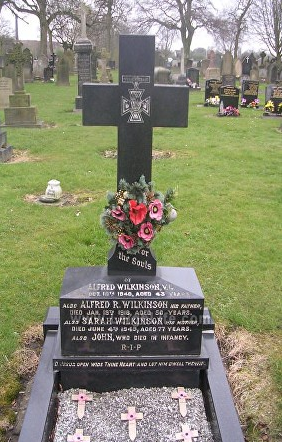 Grave of Alfred Wilkinson VC, Leigh Cemetery
Grave of Alfred Wilkinson VC, Leigh Cemetery
(In November 2018, 100 years after the end of World War One, a statue of Alfred was unveiled in Leigh by his granddaughter Jackie Lowe and nephew Philip Wilkinson. At the same time his grave was refurbished and an information board installed in Leigh Cemetery)
Disembodied from War Time Service
Unlike their Regular and New Army counterparts, territorial soldiers didn’t get mobilised and discharged. Under the legal terms of their enlistment they were ‘embodied’ into war time service and ‘disembodied’ when hostilities had ceased.
Grandfather Frank was disembodied from active service on 27 January 1919 after nearly four and half years’ service abroad. Due to his wounds he was discharged from the army as no longer being fit for active service and awarded the Silver War Badge in recognition.
Over two million men were discharged because of wounds or illness during the Great War. In September 1916, King George V authorized the Silver War Badge to honor all military personnel who had served at home or overseas since 4 August 1914 and who had been discharged because of wounds or illness.
The Silver War Badge was a small, circular badge made of sterling silver, bearing the King’s cypher, a crown, and the inscriptions ‘For King and Empire’ and ‘Services Rendered’. On the reverse is a unique badge number applicable to the holder.
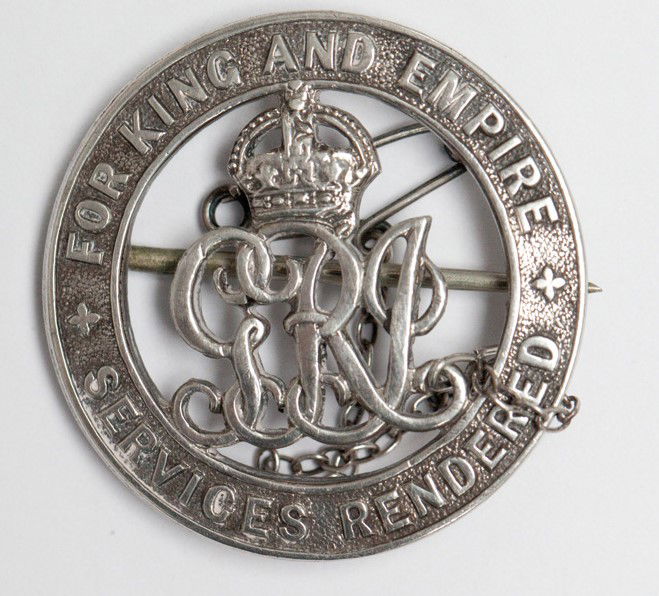 Silver War Badge
Silver War Badge
The badge was not simply an honor; it also served a practical purpose. At the time, men of military age who were not obviously in the service were sometimes accosted or insulted by civilians presenting them with white feathers — a symbol of cowardice for shirking their patriotic duty. The badge, designed to be worn on civilian clothing, served as an outward symbol that the wearer’s duty to country had been honorably fulfilled.
Frank returned to his old job at Ince Council and like so many others of his generation just got on with his life, raising a family eight children, four boys and four girls. According to my father he rarely spoke of his war time experiences.
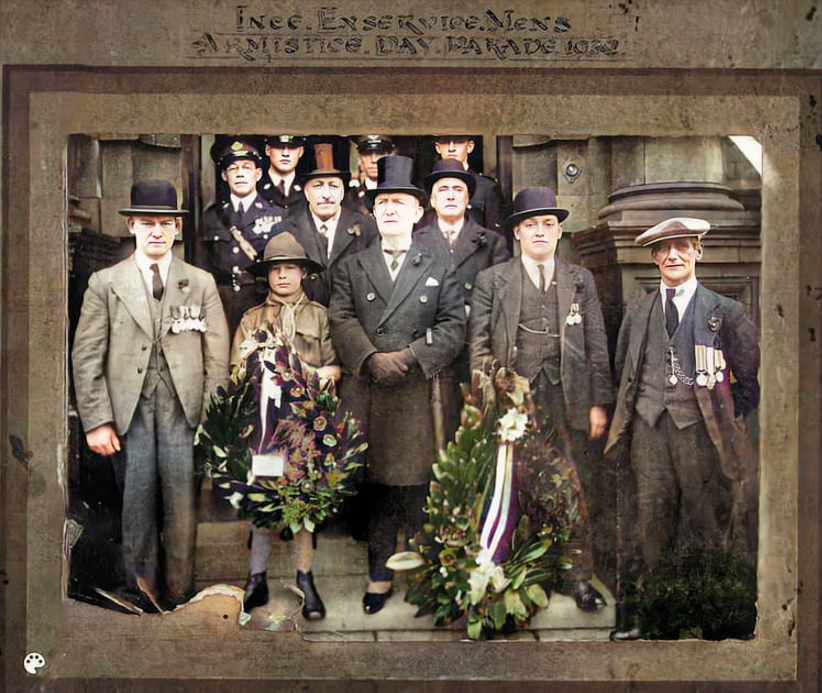 Ince Ex-Servicemens Armistice Day Parade 1932. (L) Thomas McCarthy MM (R) Frank Taylor MSM with dignitaries on Ince Town Hall steps.
Ince Ex-Servicemens Armistice Day Parade 1932. (L) Thomas McCarthy MM (R) Frank Taylor MSM with dignitaries on Ince Town Hall steps.
The 1939 England & Wales Register taken at the start of World War Two shows him living at 367 Warrington Rd, Spring View with my grandmother Alice and their six youngest children, his occupation is motor lorry driver. His two eldest children, Isaac and my father John are absent from the register, they were regular soldiers in the Royal Artillery at the time, serving in Gibraltar. My grandfather died in Spring View, Wigan on 4 August 1955 aged 68, his cremated remains were scattered in Wigan Cemetery at Lower Ince.
Great Uncle George, his brother, was finally released from military service on 13 March 1919 and transferred to the RAF Reserve. He returned to his old job as a wagon builder in Ince. He and his wife Elizabeth had six children, two boys and four girls, his eldest child, Fred had been born when George was in Egypt on active service. His great granddaughter is the famous singer Lisa Stansfield. The 1939 Register shows him still living at 10 Crompton St, Lower Ince and a carpenter at the local wagon works. During WW2 he served as a special Police Constable. George died in 1958 aged 66 and is buried in Westwood Cemetery, Lower Ince, grave D93.
Unfortunately the service records of grandfather Frank and great uncle George didn't survive. The service records of soldiers who fought in the Great War of 1914-18 were stored in the War Office repository in Arnside St, London. On 8 September 1940, during the Blitz, the building was gutted by fire caused by incendiary bombs, approximately two thirds of the 6.5 million records were lost in the flames. Some 2.8 million records were saved, many fire and water damaged and are known as the ‘Burnt Collection’. Today, researchers have about a forty per chance of successfully finding a service record.
 Frank Taylor's pay book 1915-1917
Frank Taylor's pay book 1915-1917
Apart from the newspaper article all I have are a few photos of my grandfather, a couple in uniform and one on Remembrance Sunday in 1930 stood on Ince Hall steps. I have had these touched up and colourised to bring them back to life. Also I have one of his pay books (Army Book 64) that covered the period 4 Oct 1915 to 29 Sept 1917. Being over a hundred years old it is in a fragile condition and some of the original entries which were written in pencil are barely legible. It is a tangible link to him though, as it would have been his constant companion tucked into the top right hand pocket of his tunic, accompanying him through the battlefields of Gallipoli, Egypt, Sinai, France and Flanders.
FOLLOWING IN FOOTSTEPS
In 2017, along with fellow veterans I embarked on a First World War battlefield trip to France and Belgium. By reading the battalion war diaries and studying trench maps, I located the spot where the 1/5th Manchester’s had occupied the front line at Frezenberg, north of Ypres, on 13 September 1917.
On our route to the Last Post Ceremony at the Menin Gate in Ypres on 13 September 2017 we stopped off at the spot. It was an emotional moment as I left a poppy cross in remembrance on the old front line at the edge of a field, knowing that exactly 100 years to the day I was treading in my grandfather's footsteps in the Ypres Salient.
 Menin Gate, Ypres, Memorial to 54,896 missing British and Commonwealth soldiers who have no known grave, unveiled 24 July 1927 by Field Marshall Lord Plumer, one of the towers of the medieval Cloth Hall can be seen through the archway
Menin Gate, Ypres, Memorial to 54,896 missing British and Commonwealth soldiers who have no known grave, unveiled 24 July 1927 by Field Marshall Lord Plumer, one of the towers of the medieval Cloth Hall can be seen through the archway
All is peaceful now, nature has reclaimed the devastated landscape back, Borry Farm is a working farm again and the Wienerberger brick works now stands on the site of the Bremen Redoubt. However all along the Western Front reminders of the conflict still remain in what is termed as the 'Iron Harvest'.
Deadly Legacy
The iron harvest is the annual collection of unexploded ordnance such as artillery and mortar shells, hand grenades and bullets, also rifle barrels, shrapnel, barbed wire piquets and other military equipment collected by Belgian and French farmers after ploughing their fields during the Spring planting and Autumn harvest. The unexploded munitions are placed along the boundaries of fields and other collection points for disposal by the authorities.
 Iron harvest collected by farmer Dirk Cardoen at Varlet Farm, Poelkapelle, Flanders. His farm was in the middle of the Passchendaele battlefield and was used by the Germans as a strong point. It was captured by the 63rd Royal Naval Division on 26 October 1917.
Iron harvest collected by farmer Dirk Cardoen at Varlet Farm, Poelkapelle, Flanders. His farm was in the middle of the Passchendaele battlefield and was used by the Germans as a strong point. It was captured by the 63rd Royal Naval Division on 26 October 1917.
During the Great war millions of shells were fired and as the landscape was churned up by the heavy bombardments, many shells with impact fuses (perhaps one in four) failed to explode in the soft mud and were buried. Each year, many tons of unexploded shells are recovered.
The authorities have declared some areas in north east France as red zones and are fenced off as danger areas because of the sheer amount of unexploded ordnance in the ground. Some surveys conducted in 2005–06 discovered up to 300 shells per hectare (120 per acre) in the top 6 inches of soil in the worst areas.
These areas are saturated with unexploded shells, including many gas shells and the soils are heavily polluted by lead, mercury, arsenic, acids, various dangerous gases like chlorine, and human and animal remains. Two areas, one near Ypres and the other close to Woevre in northern France are heavily contaminated with arsenic and strictly off limits.
Since the Great War hundreds of people; farmers, innocent civilians, construction workers and bomb disposal technicians have died. According to the 'Securite Civile', the French agency in charge, at the current rate, over 300 more years will be needed to clear the area of the Western Front completely of this deadly legacy.
LEST WE FORGET.
Graham Taylor
2023
Acknowledgements
Thanks to Hugh Darlington for access to war time photos and memorabilia relating to his grandfather Lt. Colonel H.C Darlington, Commanding Officer of 1/5th Battalion Manchester Regiment.
Sources
1/5th Bn Manchester Regt, Gallipoli War Diaries May 1915 - Dec 1915; 1/5th Bn Manchester Regt, Western Front War Diaries March 1917- March 1919; 42nd (East
Lancashire) Division; World Heritage Encyclopaedia; Australian War Memorial; Britannica; Imperial War Museum; De Rufigny's Roll of Honour 1914-1919; Journal of the Victoria Cross Society 14th Edition March 2009; Letters from Helles, 1936, Sir Henry Darlington; Liddell Hart Military Archives; Museum of the Manchester Regiment; National Library of Scotland Maps; Ordnance Survey/British War Office, First World War Trench Maps 1915 -1918; Krithia Gallipoli Stephen Chambers; Private Lord Crawford’s Great War Diaries; QARANC Queen Alexandra’s Royal Army Nursing Corps; Railway Museum; Roads to the Great War – ww1 blogspot; Tameside Metropolitan Borough Libraries & Leisure; The 42nd East Lancashire Division, 1914 -1918. Frederick. P Gibbon; The Territorial Force; The Manchester's in Gallipoli 1915-1916 Facebook page; The Long Long Trail; VC Online.org; Wigan & Leigh Archives; Wikipedia.